2015 - Christmas in India

Above: Western state snow totals showing above average snow pack throughout Utah, 23 December 2015.
TIMDT and Mwah (sic) left for India just as a mega storm hit the Wasatch. 40 inches of new snow at the resorts and counting.
We departed San Francisco on an Ethiad Airlines triple 7, about noon on 22 December 2015 and arrived in Abu Dhabi, after a 14 hour flight, about 4PM on 23 December 2015. After a 5 hour layover spent snoozing, reading, blogging, and eating in the Ethiad Airlines lounge, we departed for New Delhi, on another Ethiad triple 7, and arrived about 3:00 AM on Christmas Eve day, 24 December 2015.
FeeBee and B1B's family, and their friends, Psychology, Montana, and son K, had made their own separate ways to New Delhi. We would meet them later in the morning for a day tour.

Above: Business class cabin. Ethiad Airlines, triple 7. 23 December 2015.
Losing a day. Our home for 23 December 2015.
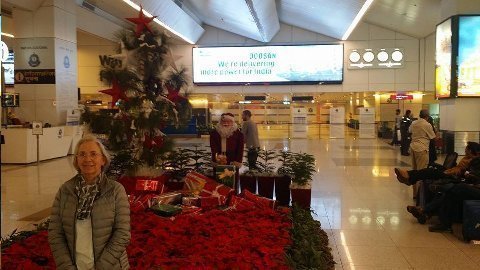
TIMDT. 3:00 AM. New Delhi Airport. 24 December 2015. Merry Christmas say all the banners.
With a coupla (sic) millenia experience, and not without occasional sectarian violence, India is one of the few countries of the world where multiculturalism is celebrated...where it actually works.
Every one celebrates everybody else's holiday. Hindus celebrate Christmas... all respect Ramadan. .. Muslims celebrate Holi and Divali. And...nobody is offended!
I love visiting India. This is my 4th visit to India in 6 years. While the challenges are legion, India is on the move. She aspires.
TIMDT is on her 9th India visit in as many years. Giving birth to Rudy Jr. here in 1973 made India special for her.
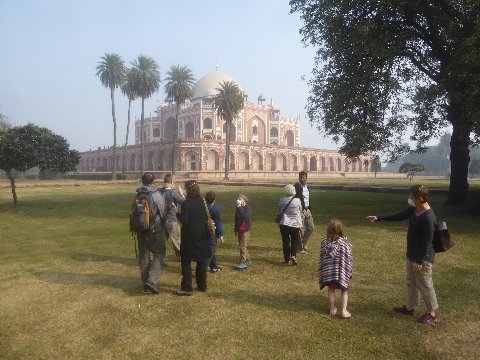
Above: Humayan's Tomb. New Delhi, India. 24 December 2015.
Guide, VJ, kids, Drums, Cat, and K, and adults, TIMDT, FeeBee, B1B, Philosophy, and Montana in the image.
Humayan Moghul great grandfather of Shah Jahan, builder of the Taj Mahal.
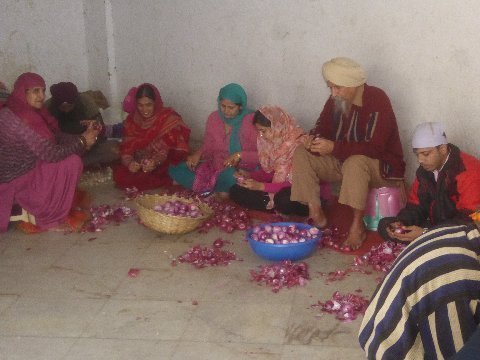
Above: Food preparation at Gurudwara Bangla Sahib Sikh temple in New Delhi, India. Near Connaught Place. 24 December 2015.
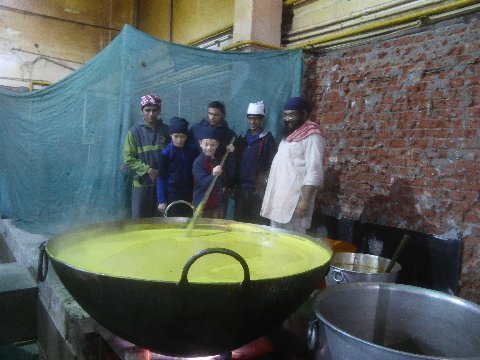
Above: Bare footed with head covered, Drums, K standing near, stirs up the dahl. Gurudwara Bangla Sahib Sikh temple in New Delhi, India. Near Connaught Place. 24 December 2015.
One of India's largest Sikh temples, Gurudwara Bangla Sahib serves up to 50K meals on holy days.
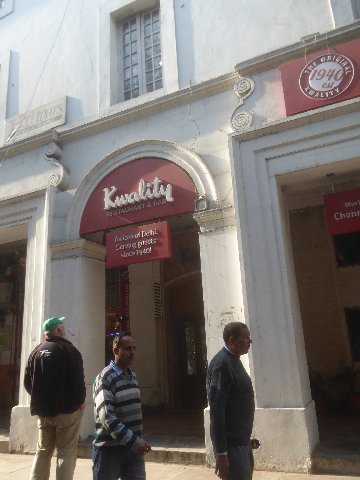
Above: The Bishop observes the Kwality Restaurant, on Parliament Street, just across the street from the site (now home of a "new skyscraper" built in 1974, of the old New Delhi branch of Citibank where the Bishop worked during 1972/1973. 24 December 2015.
Our group had lunch here. Dahl, rice pillau, bindi, alou gobi, chicken tikka kebab, nan, salty lassi. Later on, the kids said lunch was the best part of the day. Its good to see the kids liking the exotic, spicy food.
I ate occasionally at this restaurant, in the early 70's. It felt good to touch the past at Kwality.
Kwality reminded me of some of the established restaurants in New York City. The Palm, for example. The waiters at Kwality were all in their 50's or above... long time employees... professionals. Food and service were excellent. We arrived to the empty restaurant about noon. By the time we left, every table was full.

Above: The Bishop observes the exterior of the New Delhi, Connaught Place branch of Citibank. 24 December 2015.
The Bishop worked as Sundries officer, Current Accounts Officer and Bills Officer over a period of 18 months at this branch in 1972/1973. Then, the Bishop was a junior officer at Citibank, New Delhi and the only gringo working at the branch. His senior Indian officers treated him and his wife very well during what was a significant cultural change for him and his family. He and TIMDT are gratefully in touch with many of these same Indian officers and their spouses 42 years later.
The actual branch were the Bishop worked was on Parliament Street, only a short walk away from where the branch (as seen, on Connaught Place, in the above image) is today. The branch in the image is in a "new building" constructed in 1974.
As the Bishop surveyed the area of Connaught Place it seemed incredible to him that during his 28th year he lived and worked in New Delhi. He was supported by his 27 year old wife and 2 year old daughter.
Memories started to waft back as The Bishop strolled through the Connaught Place area. He remembers once, while serving as Current Accounts and Cash Officer, the branch ran out of cash. His 2nd in charge, who usually trekked to the nearby Reserve Bank of India, on cash runs was not available, so his boss, Ajit Grewal Singlh (now deceased) said that he, The Bishop, would have to go get the cash himself. Ajit's sly smile quickly signaled that the cash replenishment errand would be somewhat of a spectacle... an American Bank officer on a cash run in the bowels of the New Delhi branch of India's central bank. It was. There were lots of gawks and lots of smiles both from the Citibank clerks who accompanied the Bishop and the cash disbursement at the Reserve Bank of India.
Ajit Grewal, my first real boss in professional life, was a great guy. I was able to stay in New Delhi with him and his wife Royina, an accomplished author, in 2007 precedent to a motorcycle trip I took through northern West Bengal, Bhutan, and Assam.
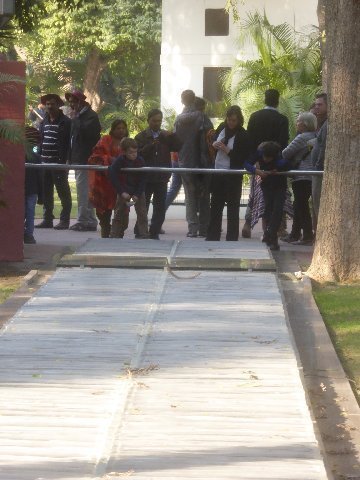
Above: Site of the assassination of Indian Prime Minister Indira Ghandi, 31 October 2015. Safdarjang Road, New Delhi, India. 24 December 2015.
The pathway down which Mrs. Ghandi was walking when assassinated by two of her Skih guards is now layered with crystal.
Mrs. Ghandi had stirred up the ire of Sikhs when she authorized Indian troops to attack Sikh extremists holed up in the Sikh Golden Temple in Amritsar. Most of the extremists were killed and the Golden Temple, the "Mecca" for Sikhs, was partially destroyed.
In the image, beyond, the kids, their parents and TIMDT can be seen.
While on another visit to south India earlier this year, January 2015, we saw the spot where Indira Ghandi's successor, her son, Rajiv Ghandi, was assassinated at the hands of a Tamil extremists suicide bomber. Sriperumbudur, near Chennai, Tamil Nadu.
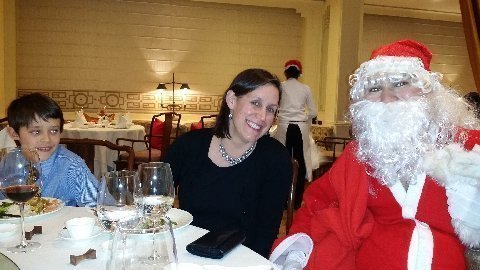
Above: K, mom Montana, and Santa. Taipan Restaurant, Oberoi Hotel, New Delhi, India. Christmas Eve. 24 December 2015.
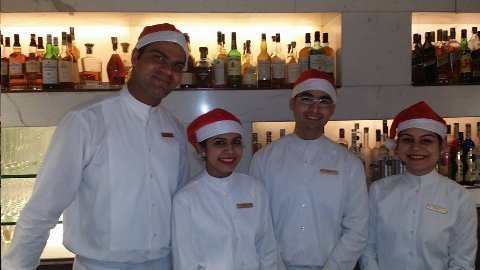
Above: Bar tenders, New Delhi Oberoi Hotel. New Delhi, India. Christmas Eve. 24 December 2015.
Christmas may be dying on 5th Avenue...but it's alive and well in India.
B1B joined Mwah (sic) for a post dinner, Christmas eve cocktail at the bar.
Merry Christmas!
Addendum:
Get used to it, it happens!
Lianne,
Miami, FL
Wants to wish you and your family a Merry Christmas and hope that 2016 will bring you joy and happiness. It is Christmas Eve and 84 degrees here. No danger of a white Christmas.
Bridge,
Palm Beach, FL
Saw the last 4 minutes – UNBELEIVABLE!
Joe, Sydney, Australia
Bishop,
Stihl and I skied Deer Valley today, 50 plus inches of snow here in the last 48 hours, we got first tracks this morning when they opened the Sultan lift for the first time this year. We missed you.
Our best to you and the family. We hope you have a very Merry Christmas.
Travel safe.
Golf,
Chicago, IL

Above: B1B, snake charmer, and cobra. Ghandi Memorial. New Delhi, India. 25 December 2015.

Above: Montana and TIMDT on bicycle rickshaw. Chandni Chowk, Old Delhi, India. 25 December 2015.

Above: Swastika symbol. Sjevtambar Jain Temple. Naughaha, Old Delhi. 25 December 2015.
In the ancient Indian language of Sanskrit, swastika means "well-being". The symbol has been used by Hindus, Buddhists and Jains for millennia and is commonly assumed to be an Indian sign. Hitler co-opted the symbol after which the swastika has had a different connotation in the minds of post WWII people.

Above: Vegetable walla. Old Delhi, 25 December 2015.

Above: Adherents on steps of Jama Masjid Mosque. Old Delhi, India. 25 December 2015.
As it was Friday, Muslim Sabbath, we were unable to enter the mosque. Thousands of adherents were arriving for prayers. According to V.J., our guide, the top Imam of India was slated to be at the mosque today. This, he said, accounted for the large number of police carrying automatic weapons surrounding the mosque today.
18% of India's population is Muslim, making India the second largest Muslim country in the world. First is Indonesia.
Broadly speaking, India has been one of the more successful countries to live with multiculturalism. Its constitution is secular and tolerant of all religions.
Notwithstanding, communal violence has reared its head from time to time.
When India was partitioned into India and Pakistan in 1948, over a half million people lost their lives.
In 1992, members of the current ruling party, BJP, destroyed the 430 year old Babri Mosque in Ayodha. It was claimed by the Hindus that the mosque was built over the birthplace of the ancient deity Rama (and a 2010 Allahabad court ruled that the site was indeed a Hindu monument before the mosque was built there, based on evidence submitted by the Archaeological Survey of India. This action allegedly caused humiliation to the Muslim community. The resulting religious riots caused at least 1200 deaths. Since then the Government of India has blocked off or heavily increased security at these disputed sites while encouraging attempts to resolve these disputes through court cases and negotiations.
The BJP party, which long ran second to the Indian National Congress Party, won national elections in 2014 elevating Narendra Modi to the Prime Minister role. While Modi was elected in the wake of successful economic reforms he made while governor of the state of Gujurat, the BJP has not lost its reputation as being a Hindu nationalist party and fears have been rising recently that sectarian violence, Hindus against Muslims, will break out once again.

Above: Dates for sale. Near Jamah Masjid mosque. Old Delhi, India. 25 December 2015.
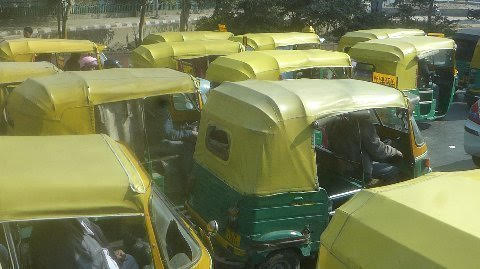
Above: Three wheeler auto rickshaws. Old Delhi, India. 25 December 2015.
After our tour of Old Delhi via bicycle rick-shaw, we dined at Char Bazarre, in the Broadway Hotel.

Above: B1B, FeeBee, Drums and Cat. Qutub Minar, New Delhi, India. 25 December 2015.
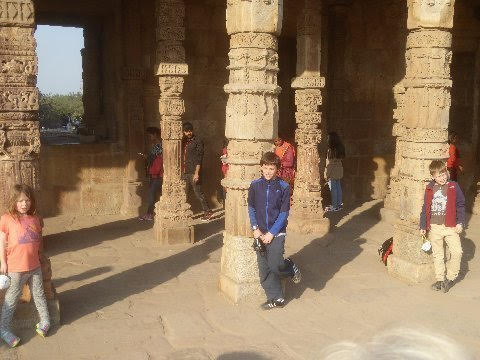
Above: Cat, K, and Drums. Qutub Minar. New Delhi, India. 25 December 2015.
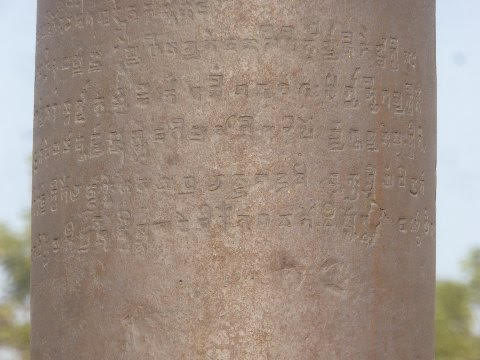
Above: Iron pillar dating to 400 AD. Qutub Minar. New Delhi, India. 25 December 2015.
The inscription on the pillar is in Sanscrit, written in Gupta-period Brahmi script.
It remains a mystery how the makers of this pillar refined the iron to such a level of purity that it has not rusted away over the centuries.
The pillar weighs over 6,000 kilograms and is thought to have originally been erected in what is no Udayagiri by one of the Gupta monarchs in approximately 402 CE.
Merry Christmas from the Taylors
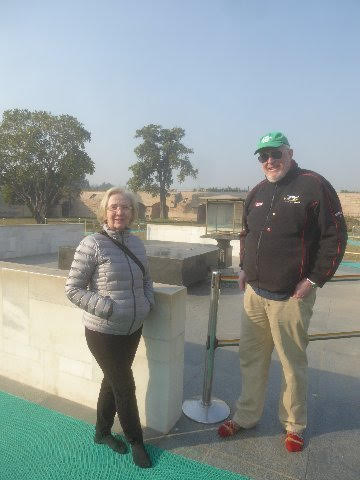
Above: Margaret and Steve. Raj Ghat, Mahatma Ghandi's cremation site, New Delhi, India. Christmas Day. 25 December 2015.
Though Ghandi was not a god, like Christ he was a martyred figure whose legacy has lived long after his death. Ghandi's message, accomplishing political change through peaceful non violence, dove tails nicely with the Christian message of "peace on earth goodwill toward men."
We hope that these messages will resonate amongst mankind in the coming years.
We wish you a most joyous Christmas and a Happy New Year.
Margaret and Steve Taylor
Addendum
Thanks for sharing Merry Christmas from [LaDoc and LaPsy].
Los Angeles, CA
thanks Steve.
Brand,
Venice, CA
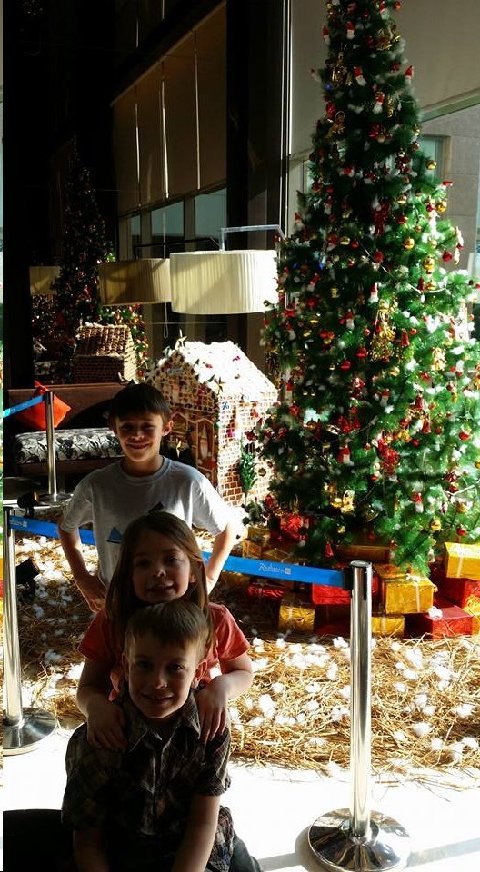
Above: K, Drums, Cat. Radisson Hotel lobby. Guwahati, Assam, India. 26 December 2015.
Today was a transit day. Shift from Oberoi Hotel in New Delhi to Diphlu River Lodge in Kaziranga National Park, Assam, northeast India. Two hour AM flight by Jet Airways from Delhi to Guwahati, lunch at Radisson (see image above), and 5 hour drive, north on national route 37 to Kaziranga.
With good friend Espresso I visited Kaziranga 42 years ago. Riding elephants into the grasslands to see the rare, endangered white rhino, has always been "up there" as a memorable experience for me. I wanted the kids and grand-kids to see it.
Back to the above image. The ubiquity of Christmas, as seen here in the hotel Christmas tree display, in predominantly Hindu India, continues to astound. Assam... no less.
On to Kaziranga!
(Sorry about lighting. Only angle I could get)!
Addendum:
Thanks for sharing this Steve! Have a grand New Year!
Best wishes,
Patrick,
London, England
Merry Christmas and Happy New Year Steve. Looks like you are having fun.
The skiing has been wonderful, travel safe.
Golf,
Chicago, IL
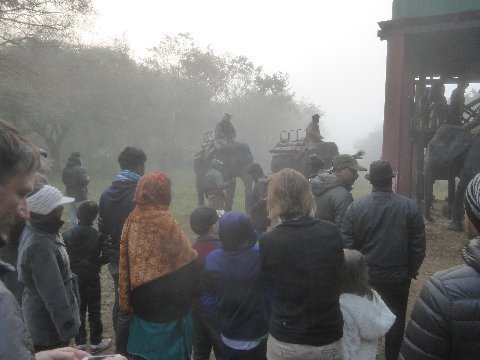
Above: Elephants make their way to loading station. 6:30 AM. Kaziranga National Park. Assam. northeast India. 27 December 2015.
Drums, FeeBee, and Cat look on.
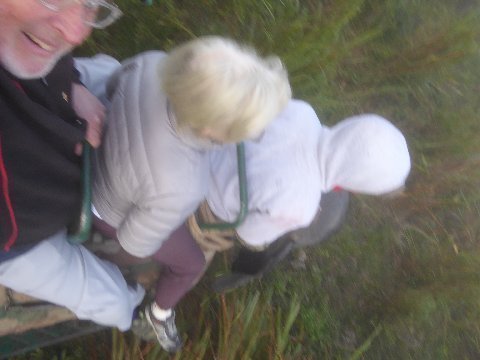
Above: First selfie ever while riding an elephant. Kaziranga National Park. Assam. northeast India. 27 December 2015.
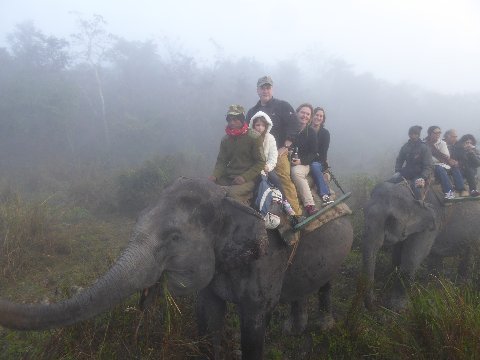
Above: Mahout, Cat, B1B, FeeBee, and OBGYN on Jumbo. Kaziranga National Park. Assam. northeastern India. 27 December 2015.
Eerie, quiet, early AM atmospherics. Only sounds were rider whispers and elephant steps plodding in the wet grass and mud.
Memories of doing this elephant walk with Espresso 42 years ago came rushing back.
It was a thrill to me seeing the joy on the kids' faces as they participated in this special experience.
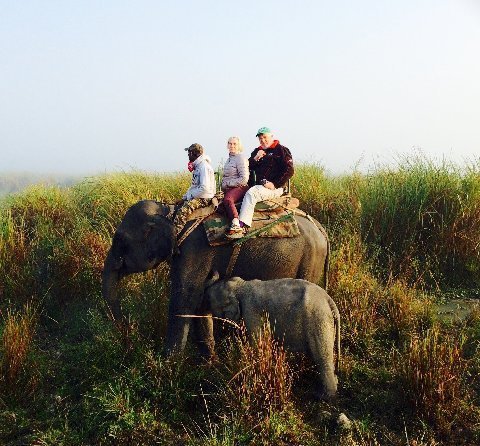
Above: The Bishop back at Kaziranga after 42 years, this time not with Espresso, but, with TIMDT and Mahout. Kaziranga National Park, Assam, northeast India. 27 December 2015.
Baby elephant is Joy. Mahout allowed Joy to suckle her mother a couple of times during our ride to see the rhinos.
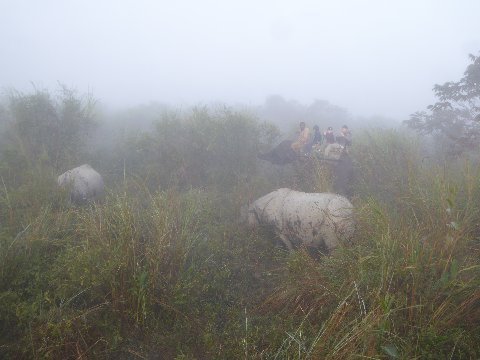
Above: Rhinos, with elephant spectator beyond. Kaziranga National Park. Assam. northeastern India. 27 December 2015.
Rhinos are not bothered by elephants who can get quite close to the rhinos without spooking them.
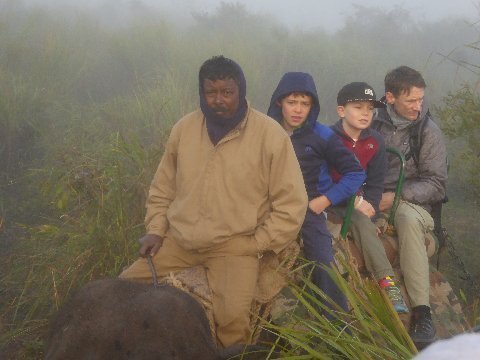
Above: Mahout, K, Drums, and GP. Kaziranga National Park. Assam. Northeastern India. 27 December 2015.
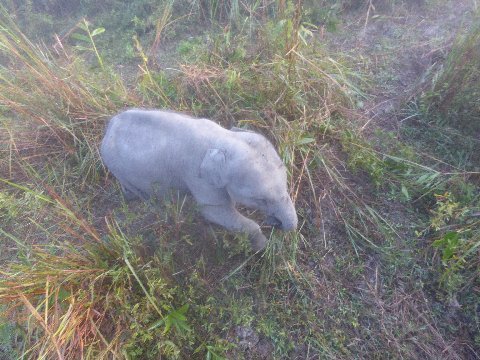
Above: Joy. Kaziranga National Park. Assam. Northeastern India. 27 December 2015.
Image captured by Mwah (sic) from atop Joy's mother.
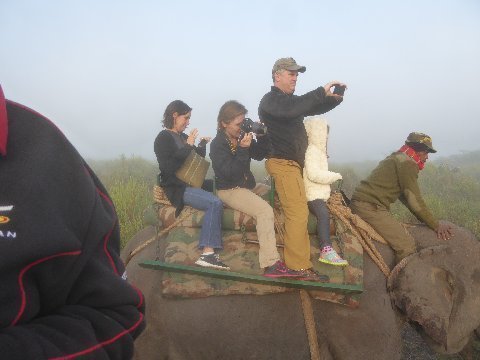
Above: OBGYN, FeeBee, B1B, Cat and Mahout. Kaziranga National Park. Assam. Northeastern India, 27 December 2015.
No one could stop taking images of the animals.
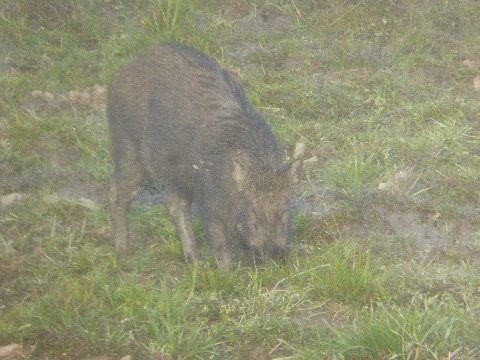
Above: Wild Boar. Kaziranga National Park. Assam. Northeastern India. 27 December 2015.
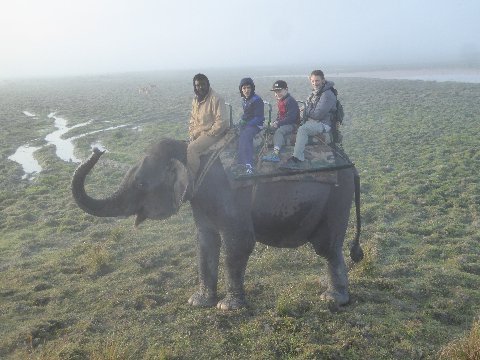
Above: Elephant poses with Mahout, K, Drums and GP. Kaziranga National Park. Assam. Northeastern India. 27 December 2015.
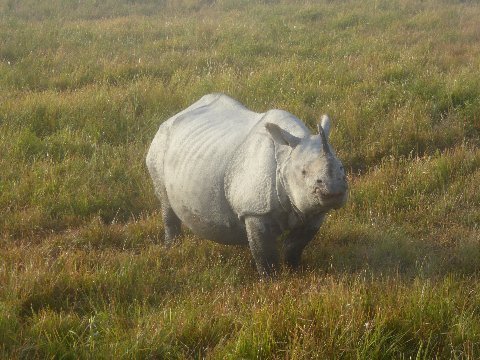
Above: Big boy rhino. Kaziranga National Park. Assam, northeastern India. 27 November 2015.
Image taken by Mwah (sic) from elephant.
Rinos eat grass all day. The grasslands of Kaziranga are known for their elephant grass, which reaches 14 feet in height.
There are about 100 Bengal tigers in the park... but, sightings are not frequent because of the proliferation of grass.
Our naturalist, Bumani, discovered a tiger track on one of the dirt roads.
In any case, the tigers would have been a bonus... as the principle reason to visit the park is the elephant ride to see the rhinos.

Above: OBGYN, FeeBee, B1B, Cat, and Mahout. Kaziranga National Park. Assam. Northeastern India. 27 December 2015.
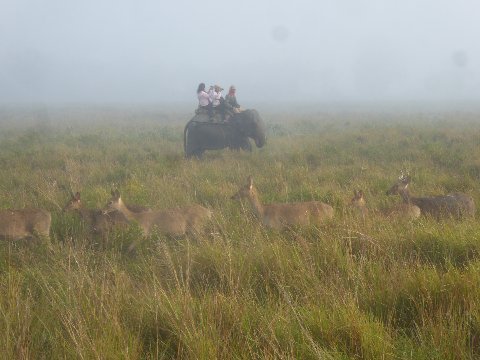
Above: Swamp Deer with elephant observer. Kaziranga National Park. Assam. Eastern India. 27 December 2017.
Kaziranga Big Five:
Swamp Deer
Elephant
Indian Water Buffalo
Rhinoceros
Bengal Tiger
We would see four of the five.... missing the Tiger.
The elephant ride to see the rhinos is the main reason to visit the park in any case.

Above Piglets. Borbil Village. Assam, Northeastern India. 27 December 2015. Home of the Mishing People, a tribal group spread through Assam , Tibet and Burma.
The village visit was not originally part of the schedule. TIMDT suggested that the group ought to do something else after a post elephant ride breakfast.
Ranauk came up with the village idea. The experience was very well received by all of us. Excellent experience for the kids.
Following the visit to the village, we stopped at the nearby Hathkuli organic tea plantation.

Above: Bishop and Drums pose with Borbil village kids. Borbil Village, Assam. Northeastern India. 27 December 2015.

Above: Pig. Borbil Village. Assam. Northeastern India. 27 December 2015.
Its a pig's life.... at least for a while.

Above: Village woman winnowing rice in the breeze. Borbil village. Assam. Northeastern India. 27 December 2015.

Above: Fisherwoman. Borbil village. Assam. Northeastern India. 27 December 2015.

Above Drums observes piglets at lunch. Borbil village. Assam. Northeastern India. 27 December 2015.

Above: Landscape, including distant mustard plant field, looking to the eastern hills direction Mianmar. Borbil village. Assam. Northeastern India. 27 December 2015.

Above: Mustard close up. Borbil Village. Assam. Northeastern India. 27 December 2015.

Above: Bumani (naturalist) OBGYN, FeeBee, TIMDT, B1B, and Ranauk (our handler). Borbil village. Assam. Northeastern India. 27 December 2015.

Above: Home construction. Borbil village. Assam, Northeastern India. 27 December 2015.
All village homes are on stilts notwithstanding that authorities have moved the village inland from the banks of the spring flooding Brahmaputra River. The villagers kept the old style of home building.

Above: Village woman spinning cotton thread. The thread will be woven by village girls and women into table cloths, shawls, runners etc. Borbil village. Assam. Northeastern India. 27 December 2015.
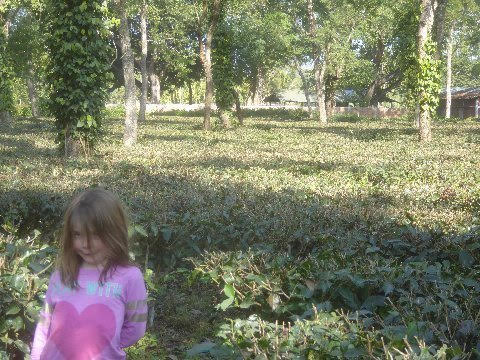
Above: Cat poses at Hathkuli Tea Estate, Kaziranga, Assam. Northeast India. 27 December 2015.
Tea bushes are on a fairly flat area with Cotton trees interspersed to diffuse the light. Pepper plants are growing around the tree trunks.
From Amalgamated Plantations web site:
The word Hathikuli is derived from the Assamese words “Hathi” (elephant) and “Kuli” (Frequent) which translates into a place that is frequently visited by elephants. The estate is situated on NH-37, adjoining the Kaziranga National Park which is a world heritage site. It falls in two districts- Golaghat & Karbi-Anglong. The tea garden stretches 15 Kms along the Highway. It produces Organic Green Tea, Orthodox Tea, CTC Tea, Black pepper and inorganic fish spawns.
As the garden is located in the same ecological zone as the Kaziranga National Park, the company decided to convert it into an organic plantation. The transformation initiated in 2007, finally achieved completion in 2011. The organic status of the estate has led to an increase in the number of natural predators that feed on the various pests that blight the tea plants. Turning the plantation into an organic one has naturally improved its soil structure. There are a huge number of earth worms in the estate’s soil compared to that of the conventional gardens. Hathikuli is also host to many wild animals and birds which visit the estate now and then.
Though usually reluctant to consume organic foods (stunted and full of bugs), I purchased a small box of the tea at the plantation's retail outlet to try out at home. I am much more comfortable eating genetically modified foods (no watermelon seeds, for example) and because of the use of insecticides, no bugs.
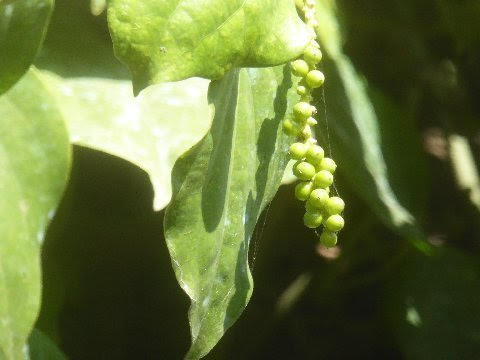
Above: Pepper. Hathkuli Tea Estates. Kaziranga, Assam. Northeastern India. 27 December 2015.
Addendum:
Absolutely fabulous.
Bronx Girl,
Pelham, NY

Above: Grrr and Z. Salt Lake City. 27 December 2015.
They caught on to this one quickly. They are given a picture and have to create the same picture using the blocks provided. They each have their own profile which keeps track of their achievements and remembers where they left off. When they complete a puzzle, more are unlocked. It's quite fun and this is just the first one. This one will develop their spatial skills.
Portland,
SLC, UT

Above: Grrr. Christmas morning. Salt Lake City, UT. 25 December 2015.
Image by Portland.
Salt Lake City, UT

Above: Grrr, Z and Roy clean out the fridge at home. Salt Lake City, UT. 22 December 2015.
Portland,
Salt Lake City, UT
Steve.. thanks for sharing these memories with me and your family. The pictures are incredible. Happy New Year to all..
Espresso,
Washington, D.C
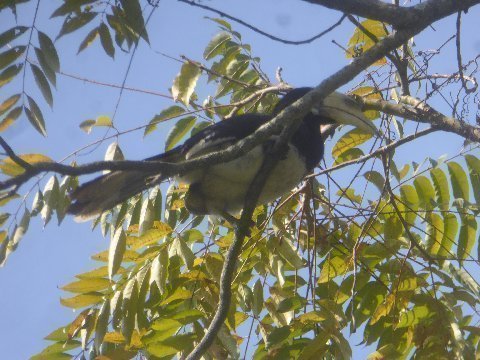
Above: Oriental Pied Hornbill. Kaziranga National Park. Assam. Northeastern India. 27 December 2015.
Without naturalist Bumani attending I wouldn't have spotted most of these birds, let alone be able to name them. He earned a decent gratuity.
Notwithstanding the interesting bird sightings, we hardly scratched the surface. There are 500 varieties of birds in Kaziranga.
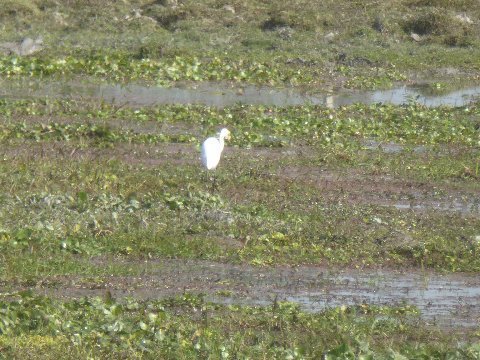
Above: Cattle Egret. Kaziranga National Park. Assam. Northeastern India. 27 December 2015.
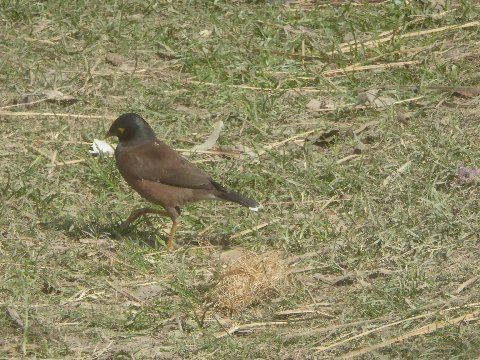
Above: Common Mynah. Kaziranga National Park. Assam. Northeastern India. 27 December 2015.
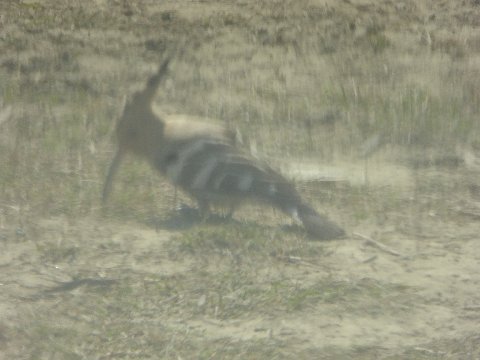
Above: Common Hoopoe. Kaziranga National Park. Assam. Northeastern India. 27 December 2015.
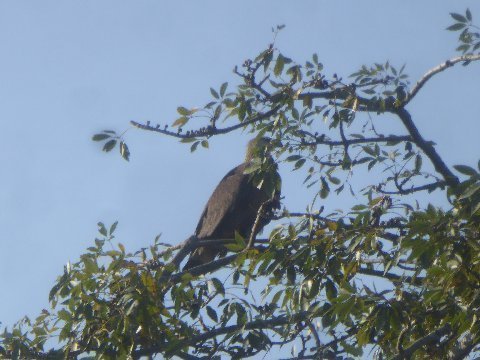
Above: Pallas's Fishing Eagle. Kaziranga National Park. Northeastern India. 27 December 2015.
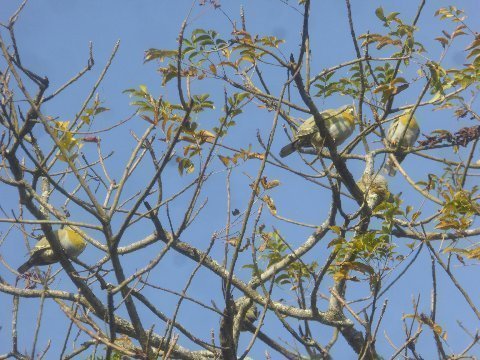
Above: Yellow Footed Green Pigeon. Kaziranga National Park. Assam. Northeastern India. 27 December 2015.
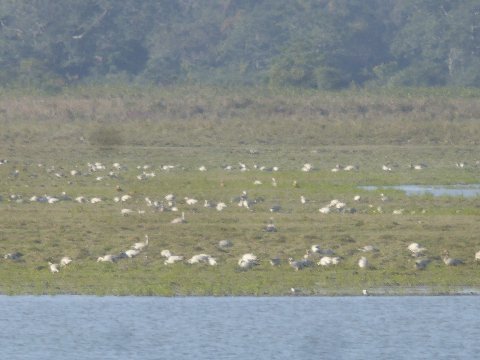
Above: Bar Headed Geese. Kaziranga National Park. Assam. Northeastern India. 27 December 2015.
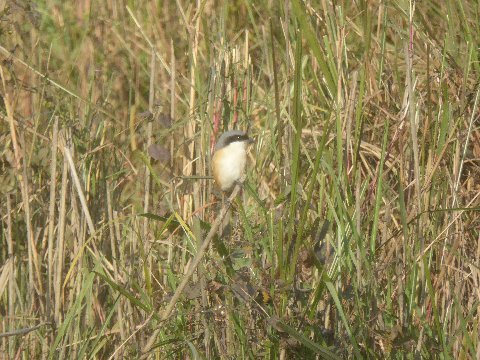
Above: Greyback Shrike. Kaziranga National Park. Northeastern India. 27 December 2015.
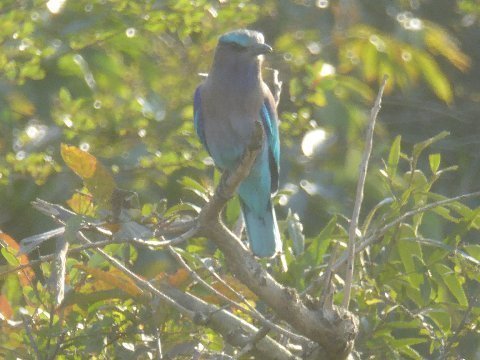
Above: Indian Ruler. Kaziranga National Park. Northeastern India. 27 December 2015.

Above: Common Stonechat. Kaziranga National Park. Assam. Northeastern India. 27 December 2015.

Above: Indian Pond Heron. Kaziranga National Park. Assam. Northeastern India. 27 December 2015.
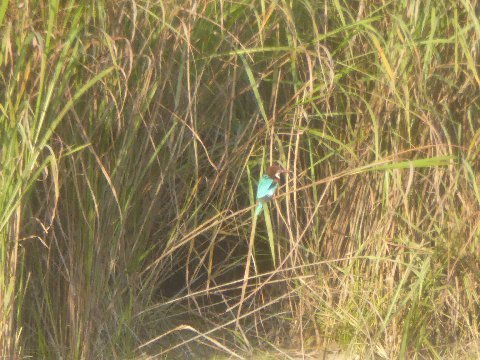
Above: Kingfisher. Kaziranga National Park. Assam. Northeastern India. 27 December 2015.
Addendum
Wow! What a splendid adventure you’re having with your family! Thanks for sharing the joy.
Mrs. Driggs
Salt Lake City, UT
Wait. That is a fisherwoman?
Bronx Girl,
Pelham, NY
Yes. The green plants are a water covering. The basket goes into the water through the green plants.
Happy New Year my friend. I will be having a glass of WW Vintners Sangiovese and toast your travels. Best to TIMDT and family.
John Galt
Walla Walla, WA
Ditto. Also... time to start planning a ride.
Steve & Margaret are in India for the holidays, apparently.
Teeny Tiny
Chicago, IL
Sorry. No closed list parens. Thanks for pointing out.
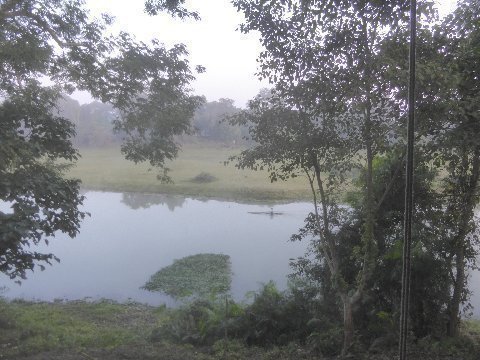
Above: Raftsman paddles down Diphlu River. 6:30 AM. Kaziranga National Park. Assam. Northeastern India. 28 December 2015.
Image captured from restaurant/bar deck of Diphlu River Lodge.
Today, after breakfast, we would take a "jeep safari" through the west section of Kaziranga National Park. The west section purportedly had large numbers of Rhesus Macaque, Gibbon, and Capped Langur monkeys.
We had expected to do the elephant walk again, but due to a large number of local holiday travelers visiting the park, the forest service, which manages the elephant walk, had restricted park visitors to one elephant walk per park visit.
Ranauk, our handler, said he would compensate for the missed elephant walk by bringing an elephant to the lodge at lunch time in order for the kids to give it a bath in the Diphlu River. That sounded intriguing.
I didn't mind missing the "second" elephant walk as the distance covered is limited (though the elephant ride experience is a "must do" at Kaziranga). The Jeep safaris go deeper into the park and cover a lot more area.
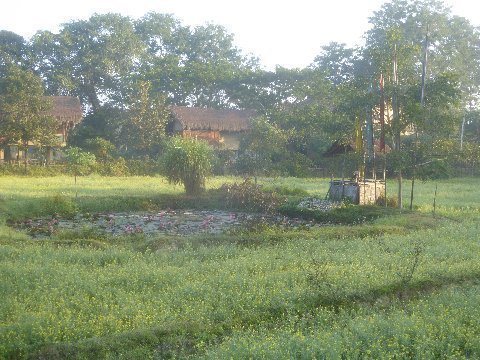
Above: Diphlu River Lodge. Kaziranga National Park. Assam. Northeastern India. 28 December 2015.
Mustard field and lily pond in the foreground.
The hotel/lodge was much better than the government guest house I stayed in while visiting Kaziranga 42 years ago. Showers, cleanliness, beds, sheets.... all good. Food, buffet style, was basic but the restaurant had an abundant quantity of fresh "ovened" nan...which I don't need, but, find hard to resist.
In a small bar, outside on the deck level of the restaurant, we'd meet at cocktail hour - it was dark - with other guests of the hotel , with small fire pits intersticed, and exchange travel stories. One British couple, 45 something, talked of their river cruise on the Bramahputra. A lone Swiss fellow, sitting at the bar, noted that his son was in the tech business in Seattle. A 55 something Belgian couple from Antwerp relayed their concern about growing fears of Islamic terror in Europe.
I'm very intrigued by the Brahmaputra River cruise.... I'm trying to persuade TIMDT to check it out... particularly before the big companies.... Viking et al.... find out about it. Apparently the boat stops at remote villages along the river which are inaccessible by road.
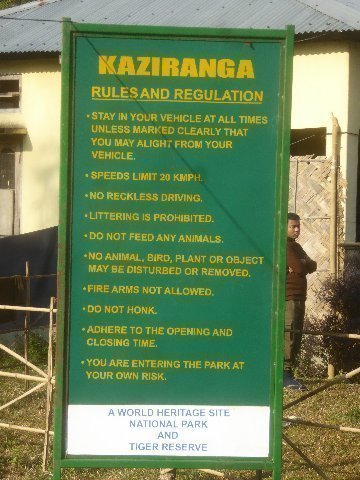
Above: Sign at west entrance at Kaziranga National Park. Assam. Northeastern India. 28 December 2015.
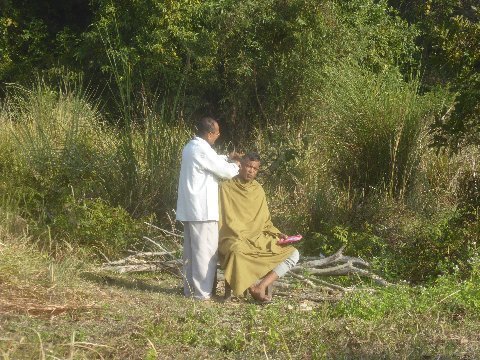
Above: Outdoor haircut. Kaziranga National Park. Assam. Northeastern India. 28 December 2015.
Barbering image was taken well within the park at a ranger station/residence.
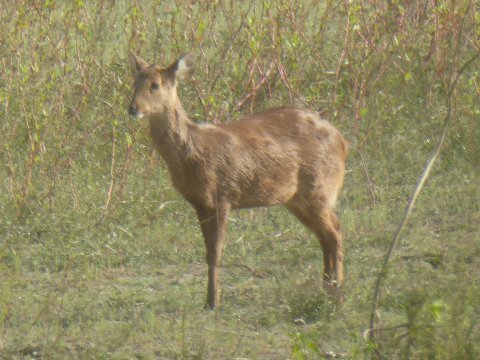
Above: Barking deer. Juvenile. Kaziranga National Park. Assam. Northeastern India. 28 December 2015.
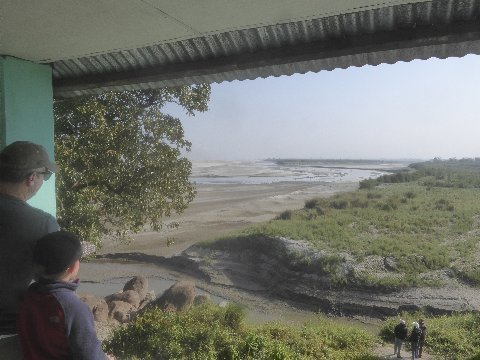
Above: B1b and Drums observe the confluence of Diphlu and Brahmaputra rivers. From lookout. Kaziranga National Park. Assam. Northeastern India. 28 December 2015.
The Brahmaputra forms the northern border of the 450 square kilometer Kaziranga National Park.
The river, one of the major rivers of Asia, originates, north of the Himalayas in Tibet. It flows across southern Tibet through the Himalayas in great gorges, into India, and southwest through the Assam Valley (where we are today), then south through Bangladesh where it merges with the Ganges... then through a massive delta into the Bay of Bengal.
The Brahmaputra is important for irrigation and transportation. It is navigable for most of its length. The river is highly prone to flooding resulting from the Spring run off when the Himalayan snows melt.
Average flow is 19,000 cubic meters per second; over 100,000 cubic meters per second at flood stage.
My first encounter with the Brahmaputra river was in 2009. I was riding a Royal Enfield motorcycle south from Bhutan. I and a dozen friends crossed the river bridge linking the north side of the river with Guwahati, Assam. While riding across the bridge spanning this mighty river I experienced a tear up moment as I tried to get my mind around the significance of this river, the majestic mountains it drained, the millions of people whose livelihood depended on its existence, and the simple fact that I was lucky enough to be there to take it all in.
The Chinese are starting to build dams on the Brahmaputra. The river's political significance grows as a consequence.
Addendum:
great shots ! thanks Steve. HNY :)
Brand,
Venice, CA
Dear Steve,
I well remember a visit to Kaziranga game park in the mid '70s. We stayed at a small government lodge / cabin that came with a local cook. Alcohol was banned but he managed to find some rough 'black rum' that went down well enough with lots of coke and lime.
The highlight was the elephant walks in the morning and evening. The evening walks were best...we had a good chance of spotting rhinos and maybe a tiger.
One evening after the sun had set, we came across a small herd of rhino on the trail back to camp. They can't see very well, so we managed to get close. They didn't seem to mind the elephants. Then someone took a photo with a flash. Boom! The rhinos bolted every whichway, the elephants started moving, the mahouts started shouting, the rhinos ran left and right of us. Luckily, no one fell off, none of the elephants were struck and calm returned when the rhinos disappeared in the dark.
Needless to say, the mahouts were not pleased and talked among themselves as we made our way back. You can imagine what they thought of us.
The bird life was incredible but we hadn't a clue what we were looking at since our guide didn't speak English after all. We saw lots of wild boar and water buck in the marsh.
Now, forty years later, I wonder what Kaziranga looks like. Have the rhinos gone?
Ciao
Bosco,
Dallas, TX
Hi Steve:
I felt sorry that you did not see #5, the tiger(s) on your India trip and elephant ride, so I've attached a pic of 36 Tigers (beers) I saw earlier this year. They were caged in the three boxes on the back on my Thai prototype Kawasaki. It was tough over the next weeks, fighting them down!
Best,
Dr. G
To be in Bogota, Colombia 12 hours from now for the start of my third motorcycle journey through South America, possibly with a bit of adventure along the way.
Bogata, Columbia

Following images were captured on the return portion of our AM jeep safari into the west end of Kaziranga National Park, 28 December 2015. We were advised we might see some monkey varieties, but there would be less chance to see buffalo, rhino, and tiger.
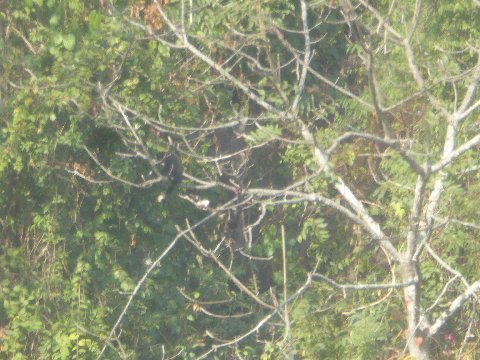
Above: Gibbon (?). Left central on tree branch. Kaziranga National Park. Assam. Northeastern India. 28 December 2015.
I say (?) because I'm not totally sure. The Gibbons were visible in the far distance swinging from the branches but it was very difficult to get a telephoto shot at 30x.
Before we spotted the Gibbons their screeching and barking pierced the forest quiet as it reverberated from the mountain where we spotted them into the flats, where we were, below.
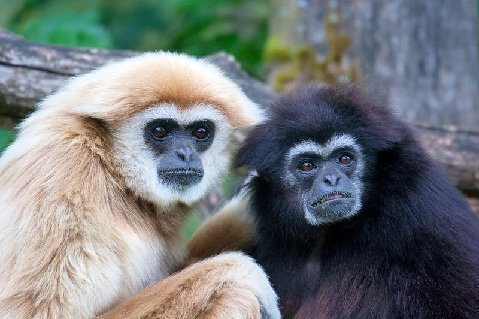
Above: Gibbons (file copy). 28 December 2015.
I don't mind including this file image as I did spot the Gibbons hanging in the trees with my naked eye.
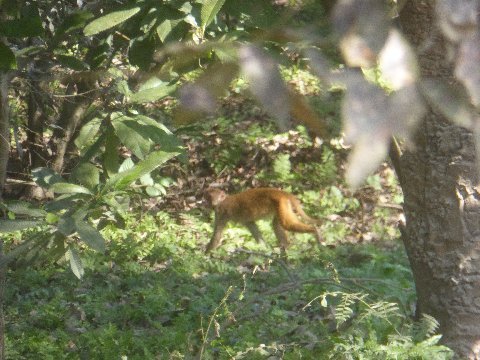
Above: Rhesus Macaque monkey. Kaziranga National Park. Assam. Northeastern India. 28 December 2015.
There were a troop of these monkeys off to our left as we were driving back from the Brahmaputra/Diphlu river confluence. Hard to get an image as the skitish monkeys were all moving away from our jeep.
We weren't really in "Jeeps." We were riding in a generic "jeep," a Mahindra four wheel drive vehicle with the rear outfitted for as many as six people to sit or stand as they watched for animals.
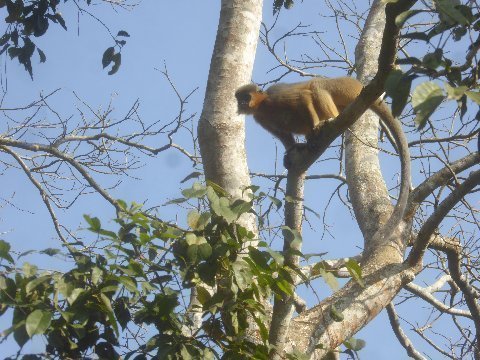
Above: Capped Langur. Kaziranga National Park. Assam. Northeastern India. 28 December 2015.
Beyond the Rhesus Macaque monkeys, on the same (left) side of the road, we saw a troop of Capped Langur monkeys playing in the tree tops. Most were in the distance, moving, making it difficult to get a good image. Then, Cat, yelled, "Look!" She pointed at the monkey in this image almost directly above our head.
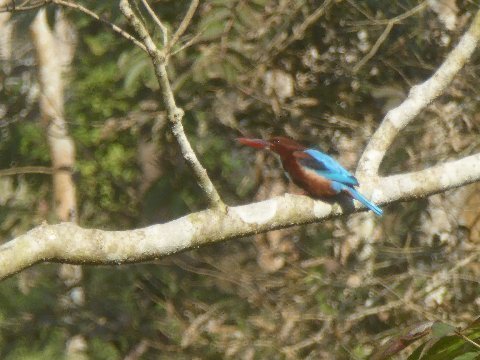
Above: Kingfisher. Kaziranga National Park. Assam. Northeastern India. 28 December 2015.
Kingfishers are prolific here. Kind of like sighting bald eagles in Alaska.
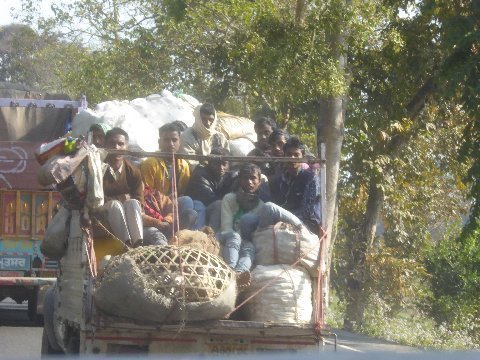
Above: Passengers on goods truck. National Highway 37. Assam. Northeastern India. 28 December 2015.
No wasted space.
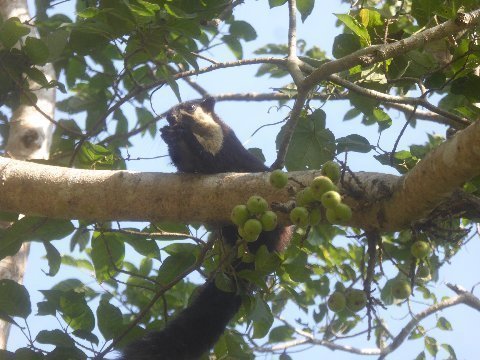
Above: Malayan Giant Squirrel. Highway 37. Assam. Northeastern India. 28 December 2015.
Bumani, our hired naturalist, was amazing. He spotted this squirrel as we were driving down the highway. Much of what I have seen today was because of Bumani's sharp eyes.
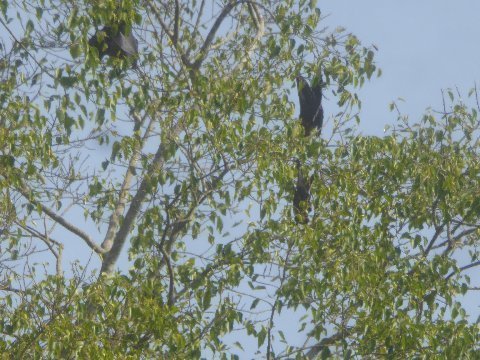
Above: Flying Foxes. Highway 37. Assam. Northeastern India. 28 December 2015.

Above: Elephant and young mahout. Highway 37. Assam. Northeastern India. 28 December 2015.
Ho hum... just your common, everyday elephant walking down the road.
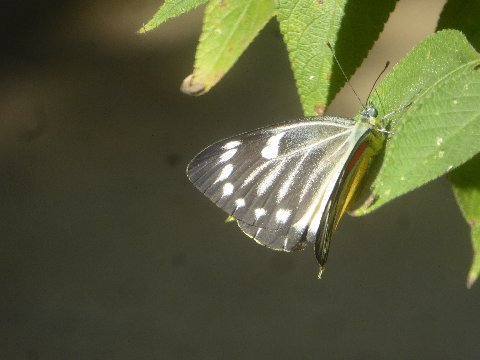
Above: Buttterfly. Diphlu River Lodge. Assam. Northeastern India. 28 December 2015.
I couldn't get my camera to focus/light correctly on the wing underside... but, red and yellow color can still be discerned by looking under the right wing of the butterfly.
Addendum:
Thanks for sharing all the wonderful pictures of your trip. I am sure it is an experience none of you will ever forget. We look forward to hearing Phin and Xanthe 's thoughts.
We wish you all the best in 2016.
Rochester and Mississippi,
Sarasota, FL
Thanks for sharing. You missed some great snow. Happy New Years to all.
Tennis,
Miami, FL
Hi guys, nice photos! Happy New Year!
We have a new address; 963 [xxxxxxx] Court, Las Vegas, NV 89149. Come see us when you come
down the next time!
Sincerely,
Riyadh and Ashton,
Las Vegas, NV
very Rudyard Kipling Steve :)
Brand,
Venice, CA
Our fourth outbound safari post elephant bath and lunch at Diphlu River Lodge. The first safari was the early morning elephant walk to see the rhino yesterday. The next three safaris were by jeep, deeper in the park. This PM we moved back east in the park, using the same entrance we used to ride the elephants... but, driving much deeper into the park.
The amazing Bumani continues as our naturalist.
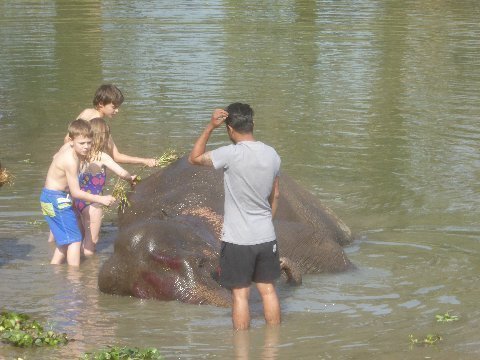
Above: K, Cat, and Drums give elephant a bath. Diphlu River Lodge. Kaziranga National Park. Assam. Northeastern India. 28 December 2015.
Unplanned washing event was conceived and organized by Ranauk, our handler for the Kaziranga period as compensation for not being able to do a second.
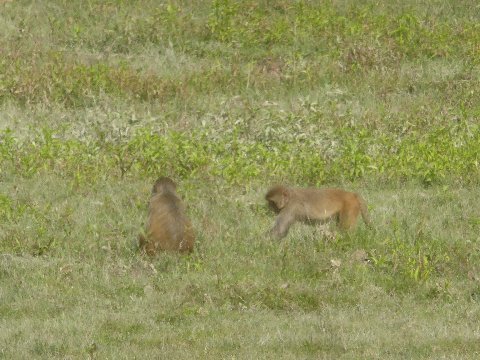
Above: Rhesus Macaques monkeys across Diphlu River from Diphlu River lodge. 28 December 2015.
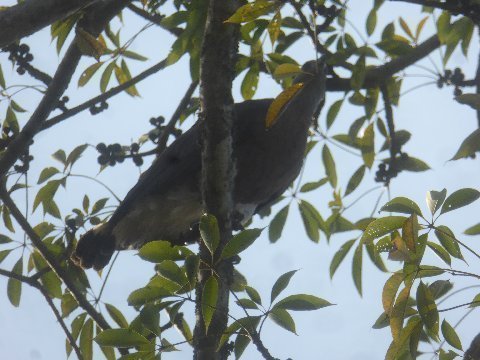
Above: Grey Headed Fishing Eagle. Kaziranga National Park. Assam. Eastern India. 28 December 2015.
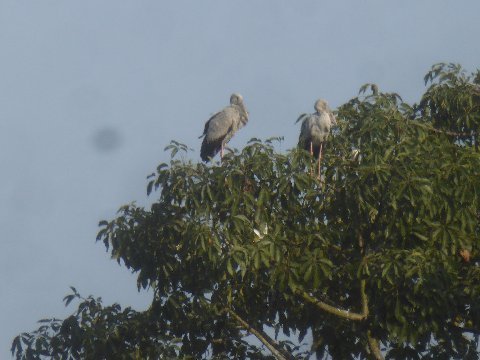
Above: Adjutant Storks. Kaziranga National Park. Assam. Northeastern India. 28 December 2015.
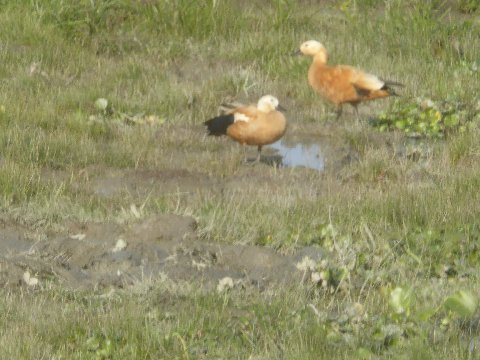
Above: Ruddy Shelduck. Kaziranga National Park. Assam. Northeastern India. 28 December 2015.
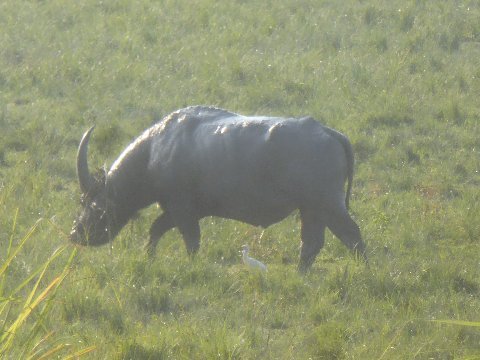
Above: Assamese Water Buffalo. Kaziranga National Park. Assam. Northeastern India. 28 January 2015.
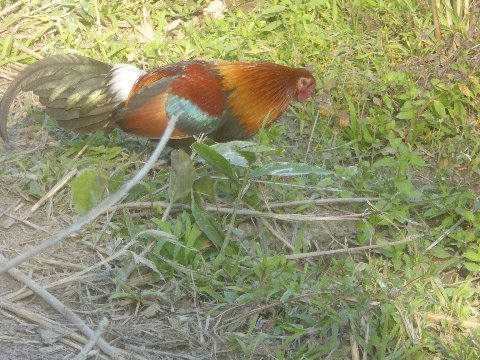
Above: Jungle Fowl. Kaziranga National Park. Assam. Northeastern India. 28 December 2015.
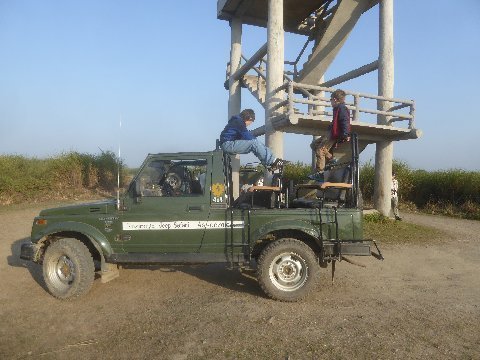
Above: K and Drums on "jeep" (Mahindra four wheel vehicle adapted for safari). Background lookout platform. Kaziranga National Park. Assam. Northeastern India. 28 December 2015.
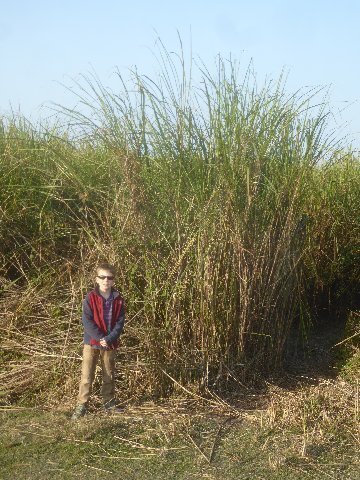
Above: Phin posing in front of elephant grass. Kaziranga National Park. Assam. Northeastern India. 28 December 2015.
Grass reaches a maximum height of 14 feet.
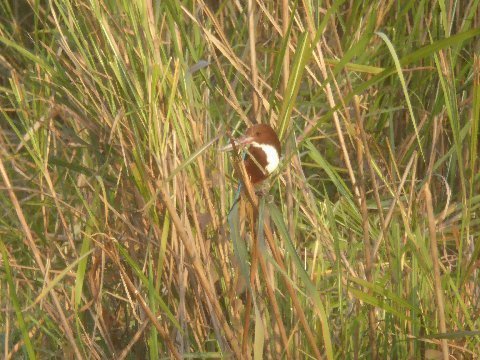
Above: Pied Kingfisher. Kaziranga National Park. Assam. Eastern India. 28 December 2015.
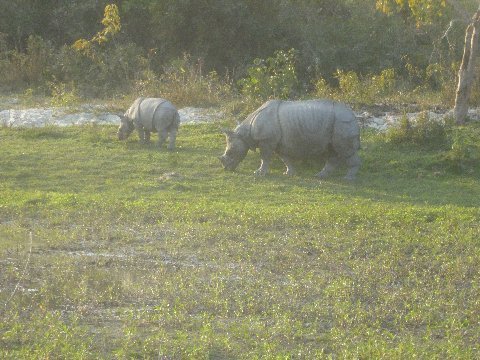
Above: Rhinos, mother and calf. Kaziranga National Park. Assam. Northeastern India. 28 December 2015.
Interesting to see the animals in a deeper, wooded section of the park as opposed to the grasslands where we saw them while riding elephants yesterday.
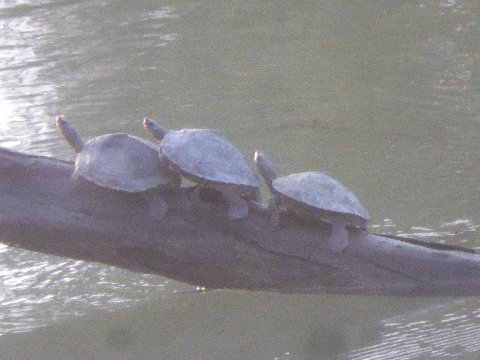
Above: Assamese Roofed Turtles. Diphlu River. Kaziranga National Park. Assam. Northeastern India. 28 December 2015.
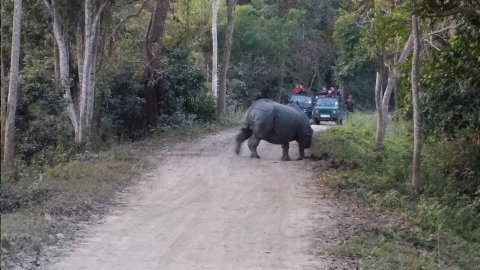
Above: Why did the Rhino cross the road?
Because he wanted to get to the other side!
Kaziranga National Park. Assam. Northeastern India. 28 December 2015.
Addendum:
Following four images Rudy Jr.'s and Portland's house. Christmas Eve, 2015.




Thanks for sharing. My grandson wanted to know if you were a professional photographer! Would like to know what camera you use.
Lianne,
Miami, FL
Panasonic Lumix. Leica Lens. Cost about $300 at Costco.
Friends who know photography say its the best of the small cameras. I have to buy one every six months as, at least the way I use it, dust gets inside the lens. You can see some of the dust particle distortions on some of the images I've been showing. Time to get a new one.
Sensational photos - Steve ; no file photos only if you take it with your camera is permitted let's stay real 😊
Mr Z3
Ojai, CA
Today, 29 December 2015, we would drive back, from Diphlu River Lodge, Kaziranga National Park, to Guwahati (four hours), where we were to visit Kamakhya Mandir Hindu temple and see the Brahmaputra River close up, before taking a 3:30 PM flight from Guwahati to Delhi. This didn't all happen as planned.... as described below.
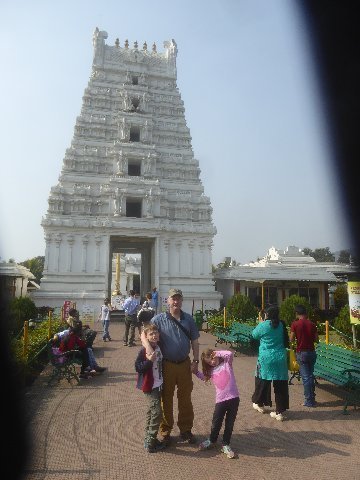
Above: Drums, B1B and Cat. Balijamandir Temple Complex. Guwahati, Assam. Northeastern India. 29 December 2015.
Though interesting, this is not the temple I had hoped to see. I saw Kamakhya Mandir Hindu temple while motorcycling through Guwahati in 2009, and thought it sufficiently interesting to see again... particularly with family members. I will never forget the image I saw there of a well dressed Indian family standing by as they watched their Hindu priest ritually sacrifice a goat.
Kamakhya Mandir Hindu temple is a well known, well attended, Tantric Hindu temple located closer to the city than the temple shown in the image. Ranauk, our escort, told us that because of the 40 or so minute delay caused by construction traffic we encountered while entering the city, and because of an excessive amount of traffic in Guwahati itself, we would not have sufficient time to make our intended temple visit, see the river, and still have time for lunch before proceeding to the airport. The temple shown in the image, Balijamandir Temple Complex, is on the less travelled city bypass road which heads directly to our lunch spot, The Radisson Hotel, and the Guwahati airport.
Planning this trip again, and considering a desire to have an un pressured visit to see Kamakhya Mandir Hindu temple and Guwahati sights, I would add an extra day to this segment... notwithstanding the construction delay or an earlier - say 6:00 AM - departure.
Not complaining. Just sayin'. The trip to Kaziranga was the reason for the journey to Eastern India.
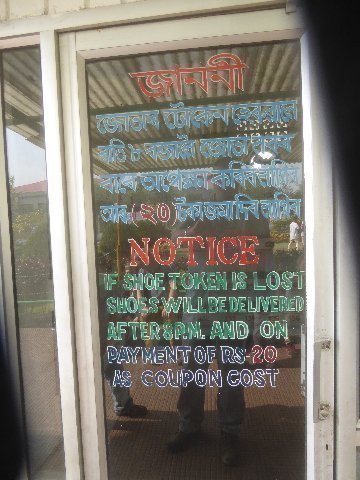
Above: Sign on the shoe deposit kiolsk indicating how to get your shoes if you lose your ticket. Balijamandir Temple Complex. Guwahati, Assam. Northeastern India. 29 December 2015.
Addendum
Great shots of wildlife! It is a trip of a lifetime for the kids and they will remember it fondly. Enjoy!
Bridge,
Palm Beach, FL
I am on my 4th Panasonic Lumix in the past 5 years. They deteriorate over time and do awfully when water hits them. That said they are the best camera, I have been able to find. The zoom length is by far the best of any small camera. I would have missed many great photos but for the zoom capability. The Leica lenses are superior to all other small pocket carry csmeras. My last Costco purchase was random. Thanks had the $300 Panasonic on a one day sale for $150.
The Pope,
Tallahassee, FL
What a unique experience for the grandchildren
They will have lots of stories to share with their friends
Montage, Marina del Rey, CA
Transit day... from Delhi (Triton Hotel, Gurgaon) to Samod, Rajesthan.
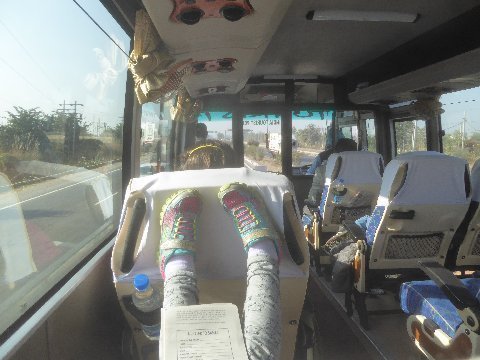
Above: Our bus. Enroute to Samod, Rajesthan from Delhi. 30 December 2015.
Five hour drive.
A long drive in India.... but, at least the way we're doing it, in a clean, air-conditioned tour bus. The drive is not the ordeal it may seem.
There is always something eye catching to see out the window. A camel pulling a cart. A Rajesthani woman in dissonant, brightly colored clothing carrying an aluminum water pot on her head. Its good for posture. "You ought to try that," I told Cat, riding on the seat in front of me.
It is impossible for me to turn my head away from an elephant, under the tutelage of a turbaned mahout, plodding slowly down the road... or a crowded shopping bazaar teeming with vendors, ramshackle kiosks, dogs, cows and bicycle rickshaws impeding the shoppers.
Part of internalizing India is the ride.
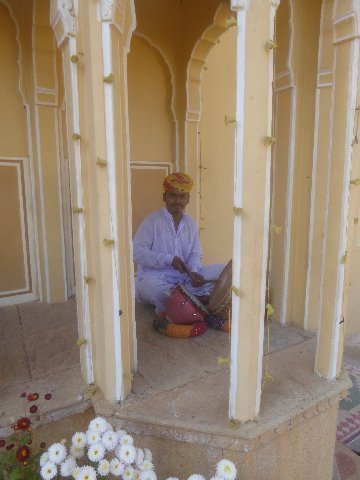
Above: Drummer. Entry portal. Samod Palace Hotel. Samod, Rajesthan, India.
A musician playing an Indian wind instrument was seated in similar manner on the other side of the entry way.
Magical.
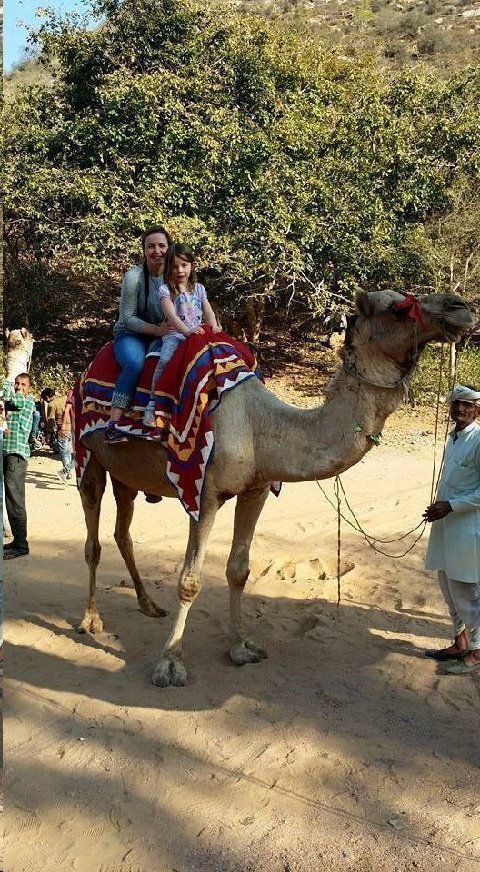
Above: FeeBee and Cat on camel. Samod, Rajesthan, India. 30 December 2015.
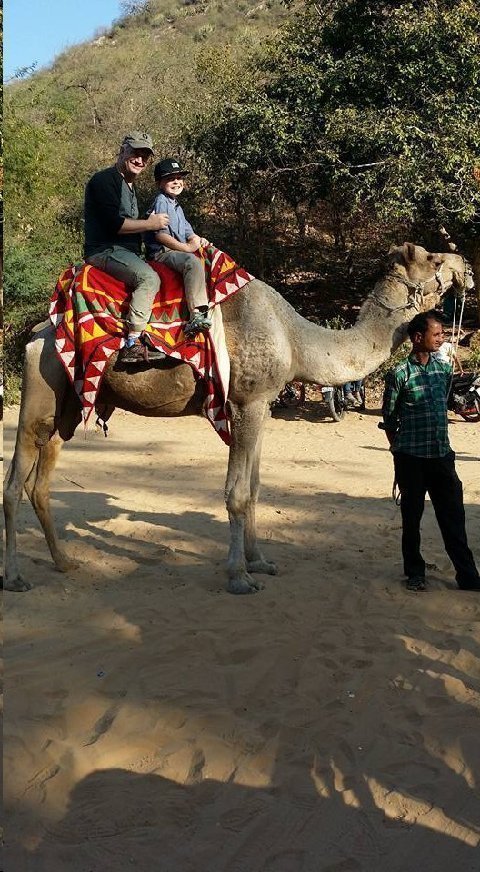
Above: B1B and Drums embark on a camel ride. Samod, Rajesthan, India. 30 December 2015.
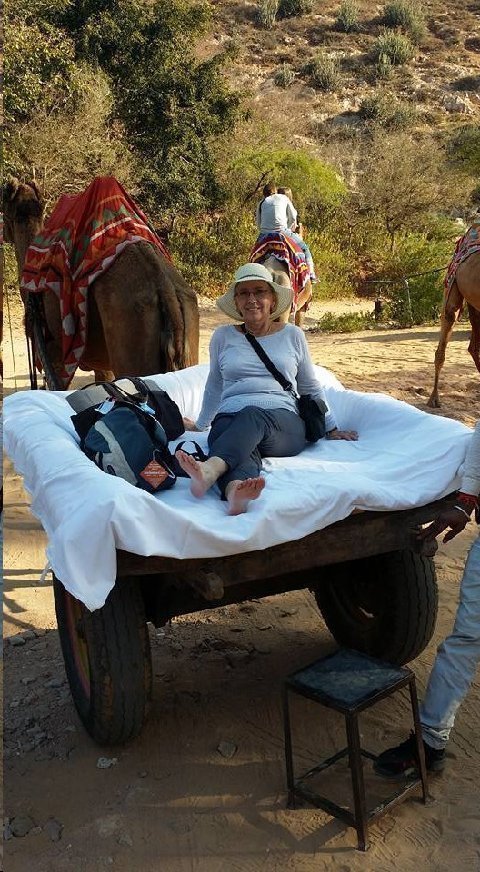
Above: TIMDT joins the camel ride... after a fashion. Samod, Rajesthan, India. 30 December 2015.
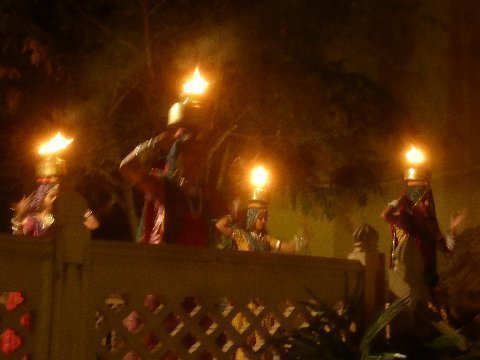
Above: Rajesthani dancers. Samod Palace Hotel, Samod. Rajesthan, India. 30 December 2015.
Addendum

Above: Z, Roy, and Grrrr shovel snow at home. 24 December 2015. Image by one of the parents.

Above: Original art in Samod Palace. Samod, Rajesthan. India. 31 December 2015 (New Years Eve).
Samod Palace is a magical place. Its a real Rajput palace... not quite a Maharaja's palace... but one owned by one of the Maharaja's retainers. The feudal family who controlled the palace had rights bequeathed by the Maharaja of nearby Jaipur of tax collection from forty surrounding villages before having to give up the property to the Indian government in 1948, two years after independence.
Rajesthan. I'm on my first real visit here. Forty two years ago I made it beyond Haryana boundaries to the Sariska Tiger preserve, but, the preserve is much closer to Delhi than to main Rajesthan cities such as Jaipur (capital), Udaipur, Jaiselmer, or Jodhpur.
Incidentally, I saw tigers at Sariska forty two years ago. TIMDT says she doesn't remember the experience, but I do... vividly. I must have gone with some Citibank guys.
By vivid, I remember forest authorities preparing a venue in front of a viewing stand for a tiger kill. The goat tied up to a post in front of us didn't have much of a chance. I'm told that today such contrived tiger sightings are not permitted.
I learned from Indian guides that in the 80's and 90's the entire tiger population of Sariska was killed off. In 2005, game authorities inserted two male and 8 female tigers back into the park.
Back to "my first real visit" to Rajesthan, 2015/2016.
Rajesthan is home of the Rajputs, a warrior class who claim to have originated from the sun, moon and fire. he Rajputs have more or less controlled Rajesthan for the last thousand years. They resisted most invaders. The magnificent forts they built, Amber, Jaiselmer, Jodhpur etc. were for protection from one another during the many squabbles they had amongst themselves. The forts were the center of Princely States, and were usually anchored by a magnificent palace inhabited by the Maharaja and Maharani.
Most empires passing through the sub continent respected the war making capabilities of the Rajputs and wisely resisted attempts to conquer the Princely States by force. Still, the Mulgals in the 14th and 15th centuries managed to get effective control through clever marriage arrangements. The Princely States then became vassal states of the Mughal empire. The Mughals had considerable respect for the warrior qualities of the Rajputs, many of whom held senior, even general officer, positions in the Mughal armies.
Even the mighty British empire, which followed the Mughals, which controlled more of the subcontinent than any other empire, allowed the Princely States to remain intact. The Princely States made cooperative agreements with the British Empire like they did with the Mughals and relations remained more or less peaceful through the British period.
During British times, the Maharajas shunned fighting and became well known playboys in European pleasure capitals... Monaco, London...many became expert players on the polo circuit. As a consequence Rajesthan's people became neglected. At the time of India independence, Rajesthan scored lowest on education levels and highest on poverty rates.
After independence, the Maharaja's were forced to cede over their lands, including the majestic forts, to the new government of India in return for rights to their palaces. Many Maharajas formed foundations to ensure that their remaining assets were protected and converted their properties into luxury hotels in order to ensure future income and lifestyle.
And... that is why we get to stay in a real Rajput palace! Samod Palace is now a hotel which sustains income for the family that ran the place for over 400 years.
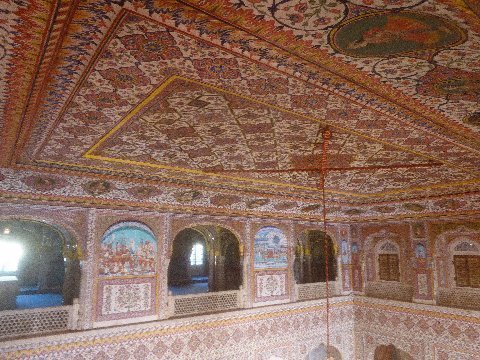
Above: Function room ceiling and balconies. Samod Palace. Rajesthan, India. 31 December 2015.
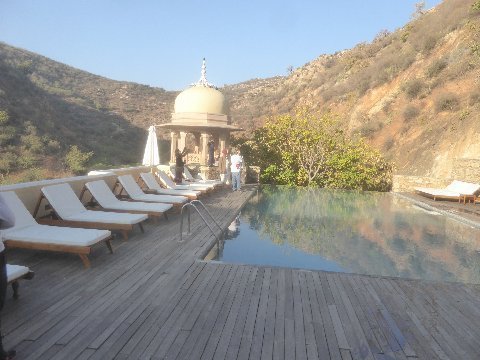
Above: Upper floor infinity pool. Samod Palace. Rajesthan, India. 31 December 2015.
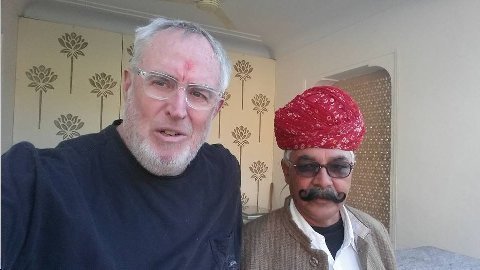
Above: Mwah (sic) with Mr. Gopi Sharma. Samod Palace. Rajesthan, India. 31 December 2015.
Wonderful 'stache.
Mr. Sharma's family line served as tax collectors for the feudal lord of Samod for 400 years. They now serve as family historians, passing down the Samod story through the generations.
Hindu good fortune mark on Bishop's forehead.
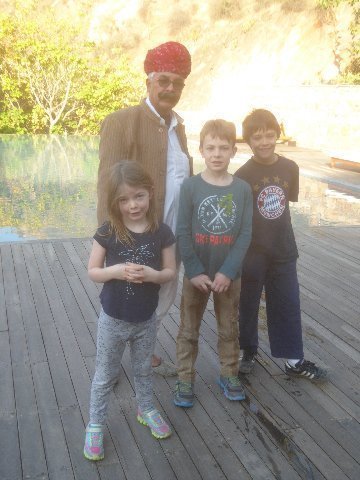
Above: Cat, Drums, and K with Mr. Sharma. Samod Palace, Rajesthan, India. 31 December 2015.
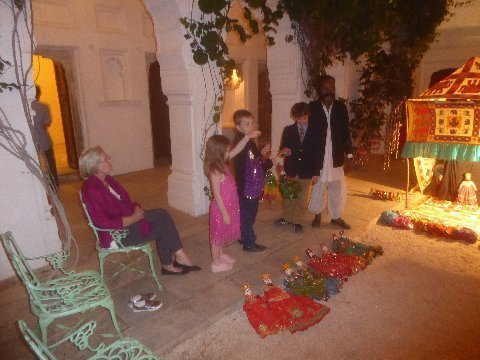
Above: Puppet show. Samod Palace Hotel. Rajesthan, India. 31 December 2015.
Parents purchased a puppet... the ones in the image lying side by side - for their kids.
Samod Palace was highly kid friendly. There were other families with children staying at the hotel while we were there.
Once again, TIMDT makes the right call on hotel selection.
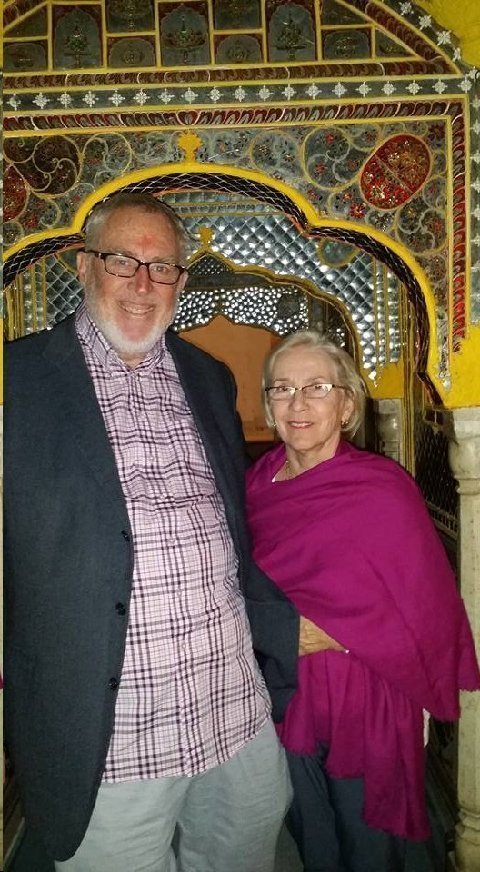
Above: The Bishop and TIMDT. New Years Eve cocktails. Samod Palace Hotel. Rajesthan, India. 31 December 2015.
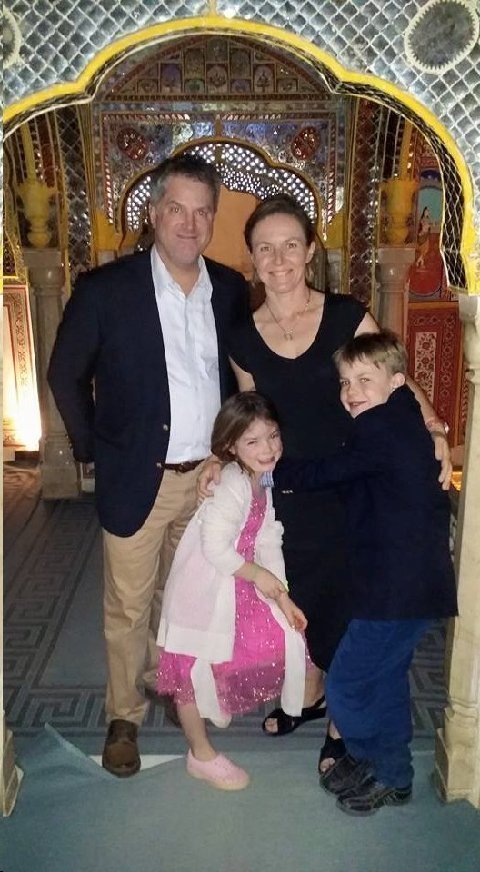
Above: B1B, FeeBee, Cat, and Drums. New Years Eve cocktails. Samod Palace Hotel. Rajesthan, India. 31 December 2015.
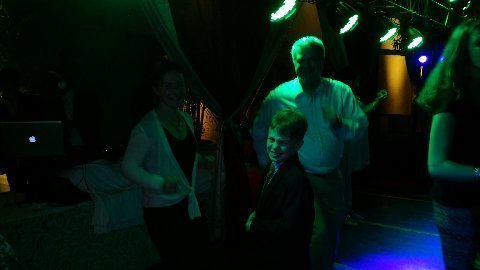
Above: FeeBee, Drums, and B1B boogy. Dinner. New Years Eve. Samod Palace Hotel. Rajesthan, India. 31 December 2015.
Addendum:
Wonderful pictures;😺 seems like all are enjoying.
Mr Z3,
Ojai, CA
Memory of a lifetime for kids.
Basketball,
Pelham, NY
Glad you are not in Assam anymore. Just now heard about a major earthquake in the area. Safe travels..
Espresso,
Washington, DC
Dodged a bullet?
http://www.ndtv.com/topic/earthquake-in-assam

Above: Four Generations - 30 December 2015.
Aunt Joyce, Sarah, Dan and Grey.
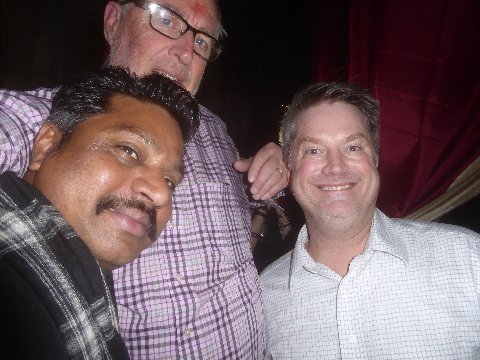
Above: AJ, The Bishop, and B1B. . Samod Palace, Rajesthan, India. 12:05 AM. 01 January 2016.
Happy New Year!
Good to ring in the new year with two good, respected guys.
B1B, AJ (our handler), and Mwah (sic) were the only ones of our group who lasted out the Samod Palace New Years Eve party into the new year. I kind of cheated. At 10:15 PM I went to bed, but didn't fall asleep. So, I got up at 11:45 PM, dressed, and went back to the party... to find AJ and B1B boogying away with a couple of sari clad Indian ladies.
I returned to the table we had booked and found it empty. I thot... we'll this is impressive... the establishment keeps our table open in case we decided to return. Then, some people, with heaping plates from the buffet, came and started to sit down. AJ came over and said, "Steve, they've turned your table," where upon he escorted me to a seat closer to the dance floor. The manager came over to me and apologized, offering me a complimentary drink. No big deal. The atmosphere was festive. Everybody was greeting everybody else with a "happy new year.!" Wait staff, management and patrons. A happy, hopeful tone prevailed. I mused to myself that it would be another 12 hours before people in Park City would see in the new year.
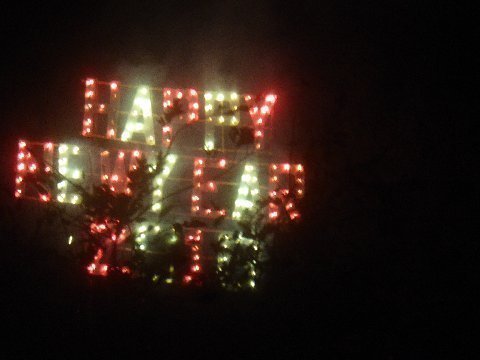
Above: Happy New Year in fireworks. Samod Palace New Years Eve party. Samod. Rajasthan, India. 01 January 2015.
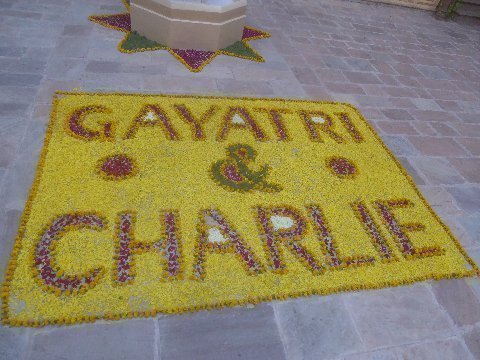
Above: Floral arrangement on pavement for wedding at Samod Palace Hotel. Somod, Rajasthan, India. 01 January 2015.
Individual petals laid side by side to create this display! Another amazing sight at magical Samod Palace!
Somebody, who was at the Samod Palace, wrote a Trip Advisor review the next day. We didn't get to the wedding... but, the tone of the following write-up reflects the spirit we felt at the Samod Palace on New Years Eve.
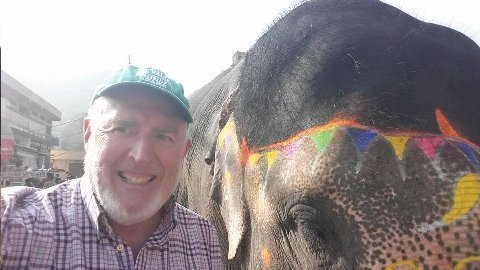
Happy New Year! 01 January 2016.
Elephant selfie.
Amber, Rajesthan, India. 01 January 2016 (elephant on the right).
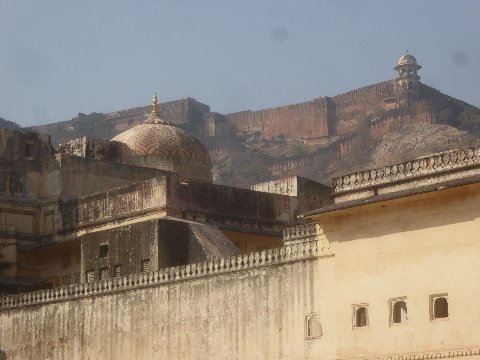
Above: Amber Fort. Amber, Rajasthan, India. 01 January 2016.
Image looks from inner courtyard out to portion of 3 mile wall which surrounds the fort. I was awed by the scale of the construction
The honey colored, sandstone fort was constructed by the Kachwaha Rajputs, headed by Maharaja Man Singh, begun in 1592. Amber was the former capital of Jaipur state.
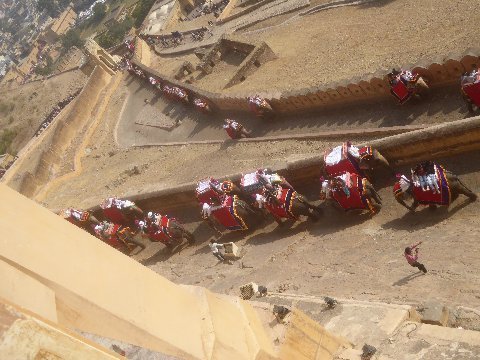
Above: Elephant parade. Amber Fort. Amber, Rajasthan, India. 01 January 2015.
The Amber Fort stands above the town. Tourists have the option of riding elephants up to the fort in the elephant parade. Our tour bus parked below. We rode up to the fort in authorized hire jeeps.

Above: Hawa Mahal Palace. Jaipur, Rajasthan, India. 01 January 2015.
Translated as "Palace of the Winds." The palace is essentially a high screen wall built so the women of the royal household could observe street festivals while unseen from the outside.
It is constructed with red and pink sandstone. The palace sits on the edge of the city Palace and extends into the women's chambers.
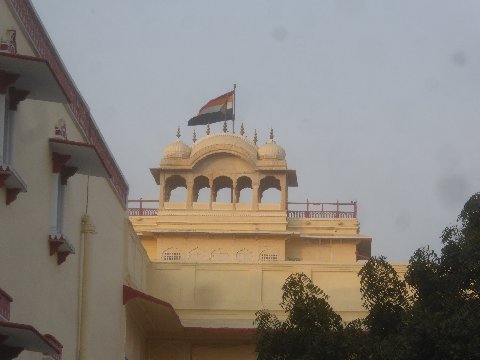
Above: City Palace (section). Jaipur, Rajasthan, India. 01 December 2015.
The palace is a complex of courtyards, gardens and buildings right in the center of the Old City. The outer wall was built by Jai Singh, Maharaja of Jaipur, after he abandoned Amber Fort. But, within the wall the palace has been enlarged and adapted over the centuries. It is a striking blend of Rajasthani and Mughal architecture.
Image shows the Maharaja's flag atop the palace. The current Maharaja is 17 years old and studies at Eton in the UK.
The visit to the armory was most interesting to me of the inner palace sights. A wide array of Mughal and Rajput weapons, knives, armor, artillery. Three blunderbusses were in prominent display.
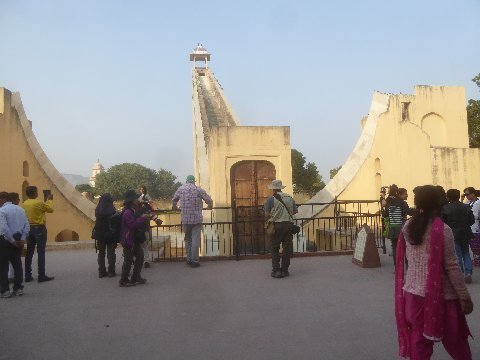
Above: Bishop (at the fence) observes World's largest stone sun dial. Jantar Mantar, City Palace, Jaipur, Rajasthan, India. 01 January 2016.
Note the shadow on the right side arch which indicates the time at about 3:30 PM.
Adjacent to City Palace is Jantar Mantar, an observatory begun by Jai Singh in 1728. In aggregate, the observatory looks like a collection ob strange sculptures. Jai Singh liked astronomy more than he liked war and town planning (at his order Jaipur became the world's first planned city... ahead of Washington D.C., Canberra, Brasilia etc).
Jai Singh sent scholars abroad to study foreign astronomy constructs. He built five observatories. Jantar Mantar is the best preserved. It has been designated as a Unesco world heritage site.
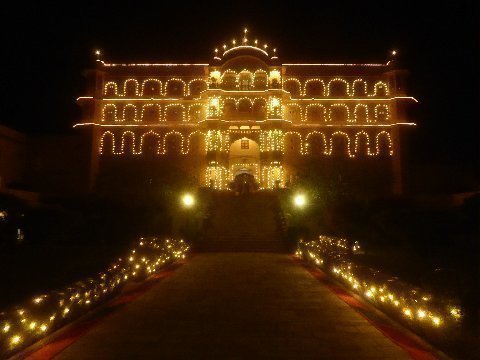
Above: Samod Palace. . Samod. Rajasthan, India. 01 January 2016.
Magical. Image taken on our return from Amber Fort and Jaipur.
Addendum:
Glad you are having a great time. Sorry for Phin's tummy upset, hope he's okay.
Now for the grown up time - I wonder which one you will like better! The short time in Coronado with family was good. Nice to see first hand little Gray DeWitt Gilman. He is a darling baby. Cyd and I shared the drive and we drove a total of 1720.1 miles over a 5 day period.
Cold in Ashland and very gloomy. Cold wind has windchill. Got home Sat. afteroon after staying in Sacto overnight. Because of holiday freeways weren't terribly crowded.
Tomorrow is first Company Call and then first four plays intros - so things are off with a bang with intros and rehearsals. Sets are already complete and costumes in final stages.
First four plays are Twelfth Night, Great Expectations (adaptation premier), River Bride (premier) and Yeoman of the Guard.
Have a great time with Callens and other couples.
Aunt Joyce,
Ashland, OR
Steve
It is wonderful that you have your grandchildren on this trip. They will have happy memories and an urge to see and understand the world.
Most people do not have memories from an early age but travel to different parts of the world tend to stick and be endearing. When I was 3 years old, my family took a 4 week ship ride from Sydney to Southampton England. I remember being in the hills of Ceylon (now Sri Lanka) where I was given several carved wooden elephants, watched Aden (now Sanaa) residents dive off our ship when passengers threw money in the water, going through the Suez Canal, passing Stromboli at night and seeing the glow of the volcano, walking around Gibraltar and standing with my great aunt in Southern England to watch the Golden Arrow train pass by. Those memories are still with me and made a lasting impression and created a passion for seeing the world.
The Pope,
Tallahassee, FL
Rajasthan ...spelling, no?
Great pics.
Bronx Girl,
Pelham, NY
Tks Bronx girl
I’ve really enjoyed your diary of this trip Steve! Thanks for sharing…and never doubt the TIMDT picks!
- Joan Cusack, Chicago, IL
HI Steve!
Your "picto diaries" have been a true education! Thanks for including me -- and what a wonderful opportunity for your family!
I can hardly believe that you may have returned home by now but if you happen to be considering the Wasatch Bagel for breakfast this coming Thursday, 1/7, please let me know as I would like to be there if your were there. Otherwise, anything I might wish to talk about can surely wait !!
Manhattan, Park City, UT
Steve,
I was with you at the Sariska Tiger preserve sighting in the summer of 1972. I do not think TIMDT went with us. It was just you and me. I do not remember any other Citibank folks being with us.
I also remember it vividly. We went in the back of a four wheel drive vehicle, in the dark of night. I thought I remembered it was a water buffalo that had been tied up, but maybe I got it wrong.
We got up in an old shooting stand near a water hole of some sort. I remember watching one of the adult tigers rip off the hind quarter of the beast with one swipe and carry it off into the bushes to eat.
It was an incredible experience.
I also remember there was controversy back then about the presence of the tigers in the preserve. Apparently they had eaten a few farmers who had strayed into the preserve to take their cattle to better grazing areas. We talked about the long range viability of the preserves with the inevitable growth in population that was occurring in India.
Sounds like the tigers took a hit for a while, but have now been restored.
Regards,
Delhi PJs,
Riverton, UT
DPJ,
Thanks much for filling in those blanks. One of the reasons I started to keep a diary is frustration about remembering trip details. I remember the event but who was with me, when I went etc. often blur. In hindsight, I wish I had started my diaries earlier.
I accept your account of the event.
Richard and I cleared our motorcycles in Bogota today, the usual (as Dr. G says) monkey fook, and while we were waiting I said to Richard, "I once offered my opinion on travel in India, after having spent some months there on a motorcycle, and shouted I'd never go back unless I got soft and rented a car and driver." It made me think....wonder if Steve is moving around by train? Nahhhh. Bus? Nahhhhh. Motorcyle? Nahhhhhh. Airplane? Maybe.... but my conclusion was chauffeured car.
It's kind of a British thing, having a driver, sitting in the back with the cooler for nibbling on packaged food and drinks....just a dream for a Cheap Charlie like me, but the only way I'd do another 10,000 k's over there....
Soooo, are you riding atop a train, jambed in a bus, or being a bit British?
Dr. G, from Bogota
British. A/C tourist bus with TIMDT, two other adult couples and three kids. Local, highly qualified and compatible handler/guide. Bus driver and bus driver assistant. Assistant helps you off the bus... brings you bottled water... helps the bus driver with paperwork when their are road side check-in requirements (yes India still overly bureaucratic)
I have (as have you) motorcycled in India before..., but not that much. In 2009 I rode from Darjeeling through a short northern section of West Bengal into Bhutan. Then from southeastern Bhutan south, through Assam to Guwahati.
Two news updates: There was a fairly major quake in Assam yesterday. 10 killed 100 injured (order of magnitude. Also, friends from Miami just joined us here in Delhi and informed that on their trip to Bhutan earlier this year, the east/west road spanning the country was all torn up and under construction. They said they saw a lot of motorcyclists "dragging" their bikes through the mud. I assumed that meant that they weren't always upright.
I have ridden the length of that road (2009) What is it, about 300 miles in length?. Then the road was mostly a rough macadam... fairly narrow. There was sameness in traveling through Bhutan that got old for me after a while. Perhaps its because we went in October when the mountains were occluded by a permanent low grade fog. I enjoyed the riding experience in Assam more... and was glad to go back there last week.... albeit dodging the earthquake bullet by only a couple of days.
Thanks much for you posts on South America look forward to more. Hi to Richard.
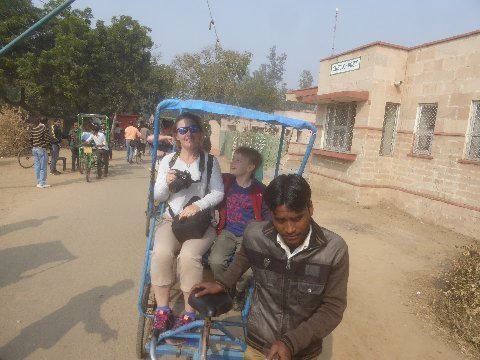
Above: FeeBee and Drums on bicycle rickshaw. Keoladeo Ghana National Park. Bharatpur, Rajastahan, India. 02 January 2015.
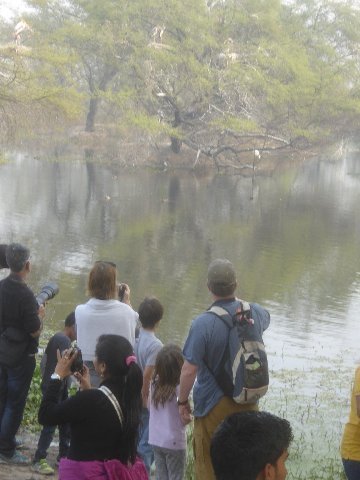
Above: Imaging birds. Keoladeo Ghana National Park. Bharatpur, Rajasthan, India. 02 January 2016.
This a nesting tree for Painted Herons.
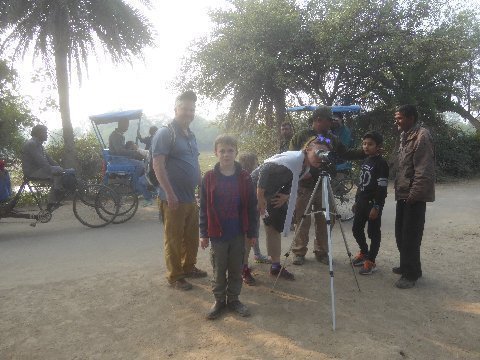
Above: FeeBee observes through scope. B1B and Drums look on. Keoladeo Ghana National Park. Bharatpur, Rajasthan, India. 02 January 2016.
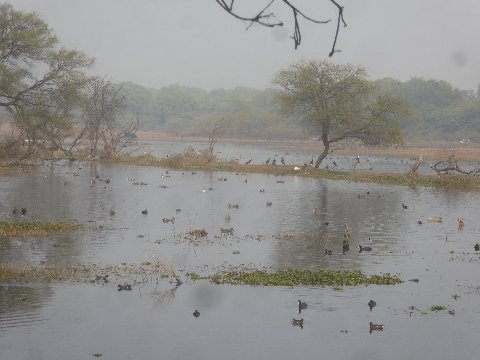
Above: Birds, birds, birds. Keoladeo Ghana National Park. Bharatpur, Rajasthan, India.
This bird sanctuary is not to be missed. I've never seen anything like the number and variety of birds any place else. Like Kaziranga, Keoladeo Ghana is a Unesco world heritage park.
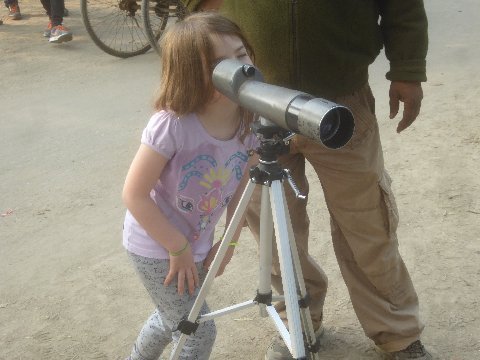
Above: Cat gazes. Keoladeo Ghana National Park. Bharatpur, Rajasthan, India. 02 January 2016.
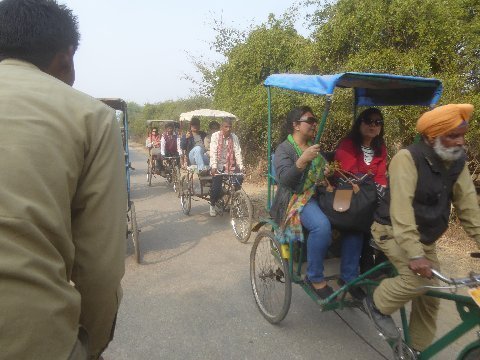
Above: Bird watchers on obligatory bicycle rickshaws. Keoladeo Ghana National Park. Bharatpur, Rajasthan, India. 02 January 2016.
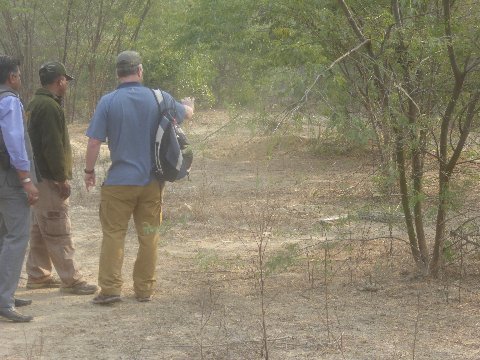
Above: Ajay, Viney (our naturalist guide), B1b and python. Keoladeo Ghana National Park. Bharatpur, Rajasthan, India. 02 January 2015.
B1B makes a movie. After shooting for 30 seconds or so, the python slithered into its hole... making for some excellent snake movement in the video.

Above: Hindustan Ambassador Car. Keoladeo Ghana National Park. Bharatpur, Rajasthan, India. 02 January 2016.
They still turn a few of these out today. TIMDT and Mwah (sic) owned a light green copy during our three years in India, 1972-1974.
Of late they've been a sign of austerity often being used by politicians eager to convey to the voters their proper use of taxpayer funds.
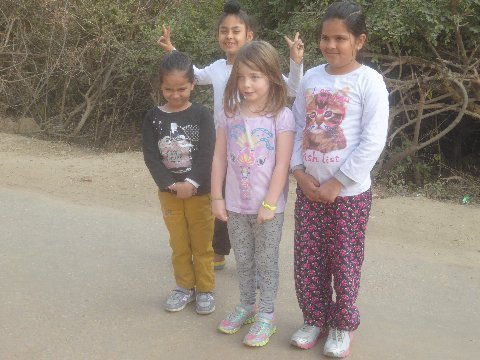
Above: Cat poses with Indian children. Keoladeo Ghana National Park. Bharatpur, Rajasthan, India. 02 January 2016.
Cat particularly was often sought out by Indian families to join in a pose. For a few days she resisted this. This time, when the family asked, I told her it would be polite to go pose with the family. Now, her mother fears she will think she's a celebrity.

Above: Drums, TIMDT, Cat, FeeBee, Viney and B1B. Keoladeo Ghana National Park. Bharatpur, Rajasthan, India. 02 January 2016.
Addendum:
When I opined "bus" in my earlier casting about for your mode of transportation, I was not thinking of one of those VIP tourist buses (that look like a pretty nice way to go). I was thinking of the local Indian buses, the ones with people hanging out the windows, no air con, and a driver on some kind of drugs. :-) Could not picture you in one of those.
I once took one of those VIP buses in Thailand, and over night one for 12 hours. I thought "Pretty fooking cool, this lounge chair with air con and pretty Thai lady serving drinks and various movies running on the Video screens." Later I learned to be more selective as the Thai bus drivers seem to crash quite often (and flee the scene it they are alive). Once during the night the bus driver walked past to use the toilet and I gave it no thought....until I realized the Thai service girl was driving the bus at 140 KPH in the middle of the night - that'll wake you up LOL
Of all the places I went while in India, my "tops" was Raj....
And when I met the Dali I did not say, "Hello your most holiness," I sang out "Hello Dolly....you're looking swell Dolly...."
Best,
Dr. G
Bogata, Columbia
It was kind of half way in between the two extremes you talk about. Our bus was half size... about 21 seats. We 10 people stretched out a bit taking a double seat for each one. No TVs... no cocktail service. Good window visibility as there is always something to marvel at while riding down an Indian highway. See below.

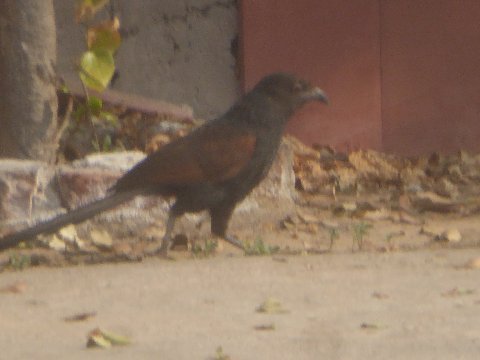
Above: Crow Pheasant. Rest stop. National Highway 11. Rajesthan, India. 02 January 2015.
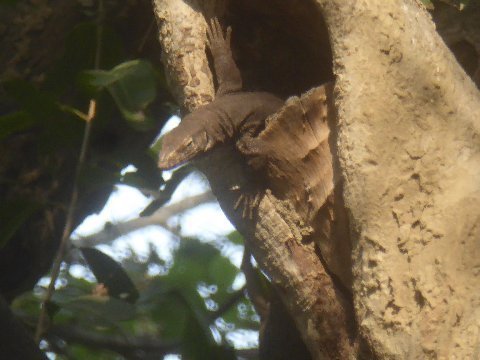
Above: Monitor Lizard. Keoladeo Ghana National Park. Bharatpur, Rajasthan, India. 02 January 2015.
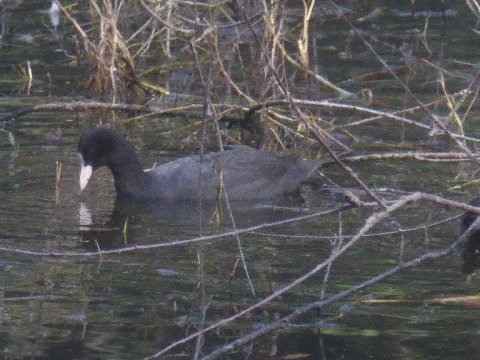
Above: Common Coot. Keoladeo Ghana National Park. Bharatpur, Rajasthan, India. 02 January 2016.
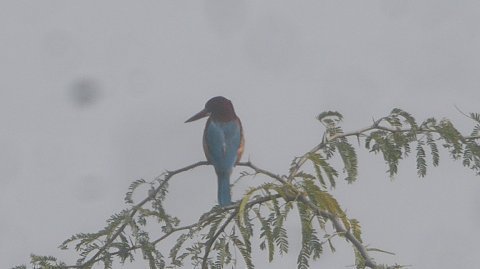
Above: Kingfisher. Keoladeo Ghana National Park. Bharatpur, Rajasthan, India. 02 January 2016.
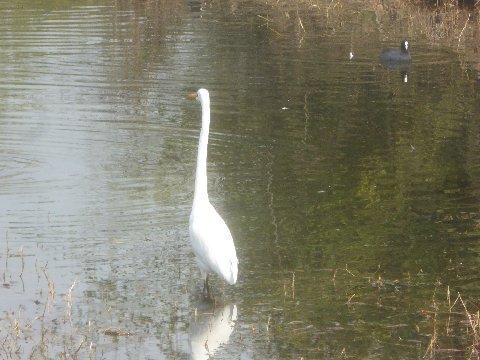
Above: Cattle Egret. Keoladeo Ghana National Park. Bharatpur, Rajasthan, India. 02 January 2016.
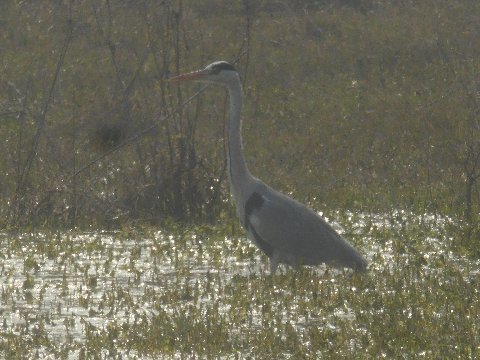
Above: Grey Heron. Keoladeo Ghana National Park. Bharatpur, Rajasthan, India. 02 January 2016.
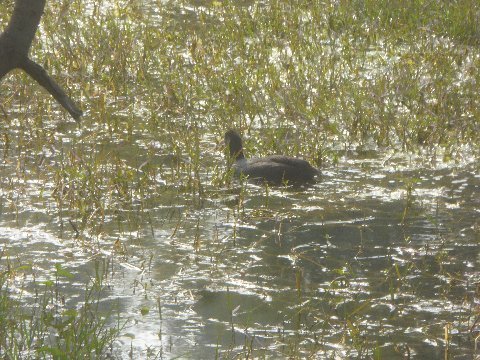
Above: Northern Shoveler. Keoladeo National Park. Bharatpur, Rajasthan, India. 02 January 2016.

Above: Wild Pig. Keoladeo National Park. Bharatpur, Rajasthan, India. 02 January 2016.
Making a meal of just caught fish.

Above: Brown Winged Jacana. Keoladeo National Park. Bharatpur, Rajasthan, India. 02 January 2016.
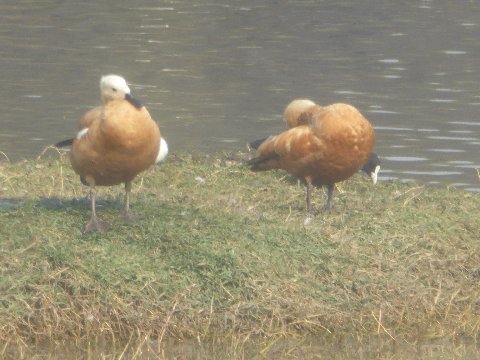
Above:Brahmani Ducks. Keoladeo National Park. Bharatpur, Rajasthan, India. 02 January 2016.
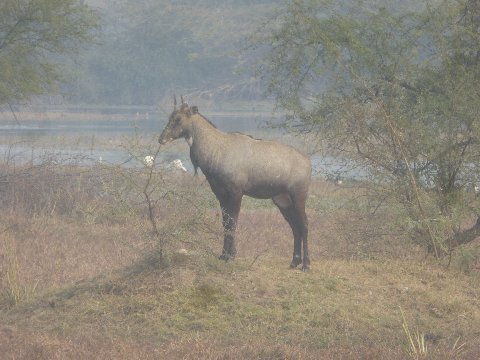
Above: Blue Bull. Keoladeo National Park. Bharatpur, Rajasthan, India. 02 January 2016.
Largest Indian antelope species. 2nd largest to Eland in Africa.
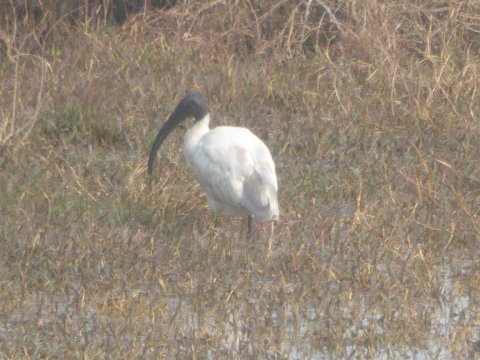
Above: Black Headed Ibis. Keoladeo National Park. Bharatpur, Rajasthan, India. 02 January 2016.
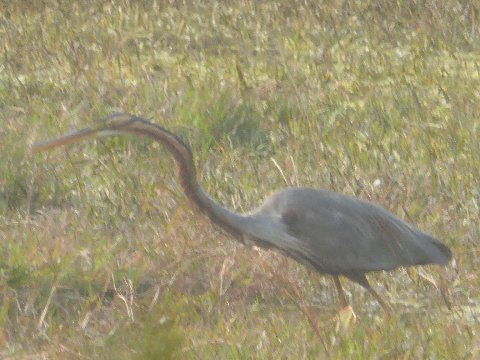
Above: Snake Bird. Keoladeo National Park. Bharatpur, Rajasthan, India. 02 January 2016.
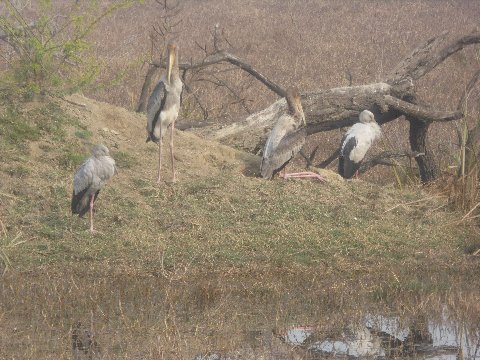
Above: Painted Storks and Open Bill Storks. Keoladeo National Park. Bharatpur, Rajasthan, India. 02 January 2016.
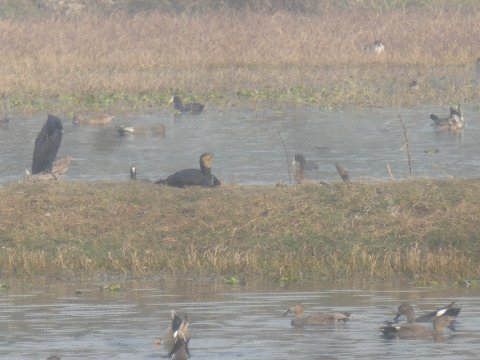
Above: Grey Lag Goose. Keoladeo National Park. Bharatpur, Rajasthan, India. 02 January 2016.
Black bird on other side of the pond. Rare. Migrates to India from Siberia.

Above:Painted Stork. Keoladeo National Park. Bharatpur, Rajasthan, India. 02 January 2016.

Above: Cat. Oberoi Amarvilas Hotel. Agra, India. 03 January 2015.
Image by TIMDT.

Above: Drums. Oberoi Amarvilas Hotel. Agra, India. 03 January 2015.

Above: Drums at breakfast. Oberoi Amarvilas Hotel. Agra, India. 03 January 2015.

Above: Bishop. Taj Mahal. Agra, India. 03 January 2015.
Breathtaking... even after having been here two or three times before.
Shah Jahan's memorial to his beloved wife.
Mumtaz Mahal, despite well along in a pregnancy, decided to accompany Shah Jahan on a trip to Gwalior to quell an uprising or a disturbance.
She got sick... and never recovered. She lost the child she was carrying.
She made a dying wish to her beloved husband: "Remember me and take care of our six children."
Shah Jahan remembered her by constructing the Taj Mahal... the apotheosis of Islamic architecture.
Shah Jahan's youngest son, Aurangzeb, eager to become king, but not destined to be king by accident of birth, took matters into his own hands. He killed his three brothers and imprisoned his father - house arrest, as it were - in the Agra Red Fort. Shah Jahan was cared for for the rest of his life by a dutiful daughter.
Well, that's the gist of it anyway.
I'm reciting from memory the story as I remember it as being told by Ajay, our handler/guide. Ajay is a wonderful story teller. He is adept at bringing out factors of real interest as opposed to regurgitating fact based history... as though from a text book. He tells the stories with expression... with passion. Its a real delight following him in our Indian monument hopping.
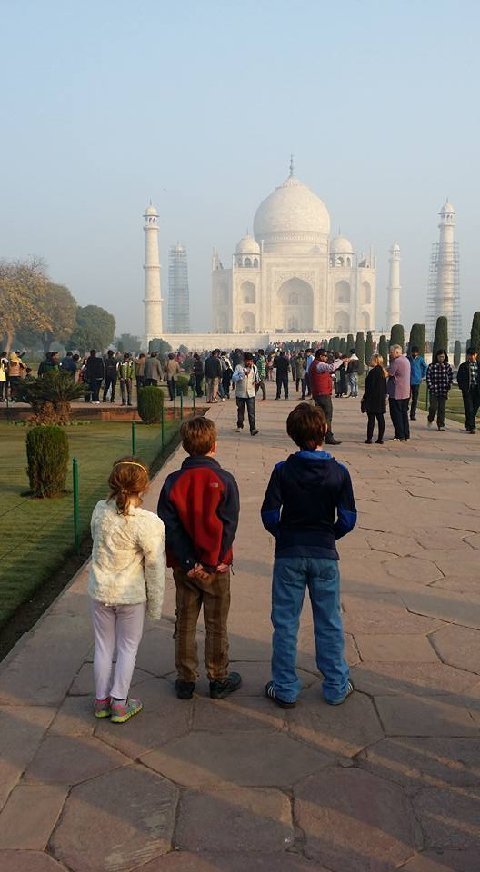
Above: Cat, Drums, and K. Taj Mahal. Agra, India. 03 January 2015.
Third generation.
What will they remember about this visit when they're my age?
Will the experience of visiting the Taj Mahal shape their future lives in any way?
They're pretty young. Don't know.
My first overseas trip was at the age of 17 when I accompanied my parents to Egypt where Dad had taken a year position with Egypt's National Institute of Management Development. I had my first year of college at American University in Cairo. The experience was seminal in orienting me towards an international business career.
7 (Cat) and 9 (Drums and K) is not 17... but, one never knows how travel will impact one's future direction.

Above: B1B, Drums, FeeBee, The Bishop, Cat, GP, Obgyn, and K. Taj Mahal, Agra, India. 03 January 2015.
TIMDT decided to stay back in the hotel while we visited the Taj Mahal.
Reminds me of a time in Florence circa 2006.
I was riding a motorcycle in and around Tuscany (circa 2006) while TIMDT and Prosecutor were visiting Tuscany and Umbria on a girls trip.
On one particular night I joined the dynamic duo for dinner in Florence and spent the night with TIMDT in her room.
The next day, I expected to join the girls in seeing the sights... The Duomo... the David... you know, world heritage sites.
After breakfast, TIMDT asked me what my plans were. "I thought I'd join you guys to see the main sights of the city," I replied.
TIMDT and prosecutor looked at one another, then TIMDT turned to me and said.... "Good idea... you go see the David and the Duomo... we'll meet you for lunch."
"Well, what are you guys going to do?" I asked.
"We're going to Frette, Christophle, and Tods," was TIMDT's reply.
OK... lets be fair. TIMDT has visited Florence and Agra several times before this visit. Still, its a funny story that one could come such a distance and not visit the star attractions.

Above: TIMDT. Agra Red Fort. Agra, India. 03 January 2015.

Above: Cannon ball hole. Residence of Shah Jahan. Red Fort. Agra, India. 03 January 2015.
Another story.
Ajay pointed to a scratch mark on a stone platform near the chambers of Shah Jahan, where he lived during his house arrest. Ajay then drew our gaze from the scratch mark to the hole in the marble wall pictured here. He said the hole was caused by a cannon ball fired by the British during the Indian Mutiny in 1857. The cannon ball had hit the stone platform and ricocheted to create the hole pictured here.
Western History calls it The Indian Mutiny, Indian Rebellion ... or, the Sepoy Mutiny. Indians refer to the conflict as The First War of Indian Independence.
The proximate cause of the mutiny was the ethnic gulf between the European officers and their Indian troops. The British had issued new gunpowder cartridges that were widely believed to be greased with cow or pig fat, which insulted both Hindus and Muslims. Other than Indian units of the British East India Company's army, much of the resistance came from the old aristocracy who were seeing their power steadily eroded under the Company.
Addendum:
Close
Great pictures of the animals. You must have a great zoom lens. Thanks for sharing
Bridge,
Palm Springs, FL
Panasonic Lumix. 30x Leica lens. $300 at Costco.
Very nice thank you for sharing.
Hand,
San Jose, CA
FeeBee/B1b and GP/Obgyn and their families departed for home early this AM. TIMDT and Mwah (sic) transferred from the Triton Hotel in Gurgaon to the Imperial Hotel in downtown Delhi to begin the next stage of our Indian adventure.

I completed reading this book, "Global Tilt, Leading Your Business Through The Great Economic Power Shift," today, 04 January 2016.
Ram Charan was a first year business policy (BP) teacher at Harvard Business School when I was there in 1969... not my BP teacher... I took first year BP from John Glover.
I recall when at HBS being surprised at how many Indian professors were teaching there. There was Charan. There was also my professor in Managerial Economics, Reporting, and Control (MERC), S. K. Bhattacharia. And others, whose names I don't recall.
I didn't realize it then, but later came to understand that these high powered Indian educators were the predecessors of a growing Indian talent juggernaut (Hindi term!) that would launch India into becoming a world economic power. Charan's book is about how global thinking businesses must play in the Indian and other southern markets, to survive. Playing in northern markets alone won't cut it according to Charan.
Charan: Northern markets are sagging and Southern markets are surging... and "you ain't seen nothing yet." Two billion middle class customers, all of whom live below the 31st parallel, will enter the world consumer market in the next decade. If you focus on short term gains desired by Wall Street, eschew the vagaries of foreign markets on the verge of a consumer purchasing power surge, you will die as a business.
New buzzwords too: "multicontextuality." CEO has to master multicontextuality to succeed. Ie. the ins and outs of each market are different. Different plans, skills and strategies will be required for each. There is no cookie cutter, Northern solution to operating below the 31st parallel.
The book contains practical tips on what you'll need to do to succeed in the south. Hire doers and not talkers, for example. And, without a knowledge of local context, it can be hard to discern one from the other.
From fly leaf:
To survive let alone thrive, in this new, fiercely competitive and hugely diverse international arena, everyone needs to adapt. Businesses need to seek broader horizons and embrace fresh strategies. They need to develop a profound understanding of the nature of the global landscape, with all its complexities and local variety. In other words, they need to tear up the old rule book and write a new one.
In enjoyed the book... particularly in the sense that I was a pioneer as an overseas, South world (India, Philippines) Citibank executive for six of my fifteen years working outside of the United States. I had to deal with many of the cultural issues about which Charan speaks. I laughed out loud as I read Charan's descriptions of how the guys on the spot in the foreign market had to deal with the "ignorant, unhelpful doofuses" (my term, not Charan's) at corporate headquarters. Been there done that!
True, I was at the operational level in my southern market work days... and Charan is talking to strategists in the book. Later in my career I operated at the strategy level so Charan's framework for action was not totally unfamiliar. I enjoyed reading the book and recommend it to anyone wishing to better understand how to capitalize on the massive, looming business opportunities awaiting in "the South."
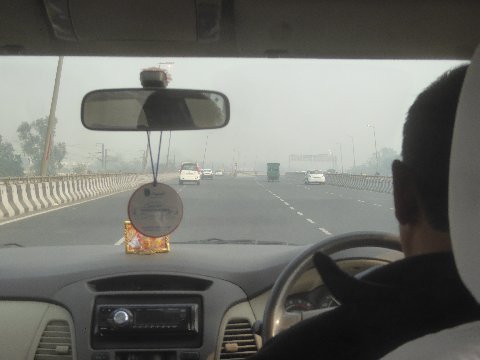
Above: Delhi pollution scene. Highway near airport in Gurgaon, India. 04 January 2015.
Problems and Challenges
Delhi is polluted. .
Arriving in Delhi, you might be forgiven if you thought you had woken up into a scene of post apolcalytic Los Angeles, in the film, "Blade Runner." The occluded atmosphere is here. Only the fire belching smokestacks are missing. There is one auto or motorcycle for every five Delhi residents. Delhi, now the largest city in the world with 20 million people, has a car induced pollution problem.
City authorities instituted an odd/even tag number driving scheme on January 1 and early reports say that compliance is not bad. 2000 drivers were fined on 03 January 2015. The fine is Rupees 2000, or, about $30.00. Fines are far more severe if you are caught doctoring or substituting a tag.
There are a myriad of exemptions to the tag scheme. A woman driving alone can drive every day, notwithstanding her tag number (see "violence against women" paragraph, below). CNG cars are exempt. Tourist cars are exempt. Still, four days later, after implementation of the scheme, people are talking about how Delhi traffic has been significantly reduced. There seems to be an upbeat reaction to the scheme four days in.
The real LA solved the pollution problem in the 70's. Now, the Indians will take their turn.
India has other problems to deal with.
Violence against women. In 2012 in Delhi there were more than 600 reported rapes. Only one resulted in conviction. Read a daily paper while here. There will be an article or two about a rape trial. The issue was brought to world attention after a well publicized account of a brutal rape in 2012. The good news is that the issue is finally "on the table" in public discussion.
Bureaucracy/red tape. Even before the BJP political party assumed national leadership in 2014, the Congress party initiated a program of economic liberalization along with a number of education, health and other social-reform initiatives. By 2006, India had become the world's second-fastest growing economy (after China). The BJP has promised to double down on economic, regulatory and red tape reform.
There is a lot of work to be done still.
On the way from Delhi airport to the Triton Hotel in Gurgaon, the bus driver had to stop to pay a commercial bus tourist tax. The driver assistant had to get out of the bus and go to an office near the side of the road to pay the tax. Total time: 15 minutes wait. I imagined the bus assistant waiting in line, and then having to watch a clerk input a bunch of data, by hand, into a cumbersome ledger book. I've seen the pattern in India so many times before.
Twice, flying domestically in India, in the past year, I have had to show my boarding pass to an airline employee while deplaning. What?
Such seeming unnecessary bureaucratic actions, and the petty corruption accompanying, pervade Indian life and stultify economic growth.
1% says he won't believe in Indian seriousness about eliminating bureaucratic hurdles to doing business until Walmart is permitted to do business in India.
Communal tension. In 1992, Hindu extremists destroyed a mosque in Ayodha, Uttar Pradesh. Hindus claimed the mosque was situated on a holy Hindu site. The Hindu revivalist BJP, then the main opposition, did little to discourage the acts, and rioting in the north killed thousands.
In 2002, when 58 Hindus died in a suspicious train fire, more than 2000 people, mostly Muslims, were killed in subsequent riots. In 2008 bombings in Jaipur, Ahmedabad and Delhi were attributed to Islamic anti Hindu groups.
Tensions seemed to be cooling in 2010, when a court stated that the Ayodha site would be split between Hindus and Muslims and the response was peaceful.
85% of nearly 1.3 billion Indians are Hindu. The Moslem population is 11%. The rest are made up of Sikhs, Jains, Buddhists and Christians (there are 20 million Christians in India)! By and large India has been more successful than most countries today making multiculturalism work... but, tensions lie beneath the surface.
Kashmir. The predominately Muslim Kashmir valley is claimed by both India and Pakistan. The majority of the territory is currently administered by India. The impasse has plagued the two countries since Partition in 1947.
Aside: TIMDT, FeeBee, and Mwah (sic) arrived in India in the fall of 1971, just after the end of the third India-Pakistan war. My Citibank boss, Ajit Grewal and his wife Royina, invited us to join them at a post war cocktail party, sponsored by McDonnell Douglas, a customer of the bank, in honor of victorious Indian general, Sam Manekshaw. TIMDT and Mwah (sic) met the general and his wife. Sam Manekshaw was on the cover of Time magazine the week we arrived in India.
There are hopeful signs about resolution of the Kashmir impasse. Just last week, Indian Prime Minister Modi made an impromptu, surprise stop in Lahore to visit with Pakistani Prime Minister, Sharif, on his return from a state visit to Afghanistan. Modi's visit to Pakistan was the first visit of an Indian Prime Minister to Pakistan in ten years.
Islamic Terror. Perhaps one reason for a hoped for rapprochement between India and Pakistan is the two countries' shared concerns about the rise of Islamic terror.... a threat to both nations.
Well known is the 2008 attack by Islamic terrorists from Pakistan on the Taj Mahal Hotel in Bombay. In 2012, when TIMDT and her friends were visiting Hyderabad, they were confined to their hotel room for the duration of the visit due to a bomb explosion authored by Islamic terrorists in a nearby neighborhood. During our stay in India this time around, there was an attack by Pakistani based terrorists on Pathankot Air Force Base, near Delhi, which resulted in the deaths of five Indians in addition to four of the terrorists.
A columnist, writing in today's Hindustan Times, speculated that the terrorists were responding in anger to Indian Prime Minister Modi's recent visit to Pakistan. It is not in the interest of Islamic terrorists that India and Pakistan present a united front in the war against Islamic terror.
Poverty and Illiteracy. Still, today, some 400 MM Indians are illiterate and living mostly in Indian villages at day to day subsistence levels. Sustained 8% economic growth over time will be required to bring this large population into the economic mainstream. Its one thing to lift out of poverty and illiteracy those that are already there. There are also those to come. India adds "an Australia" to its population annually.
The Good News
How can a country with so many people, states, languages, cultures, religions, traditions and opinions get its act together... particularly in the face of the problems outlined above?
There are some good signs.
Business leaders are projecting an 8% economic growth rate for the country in 2016 (The US is trumpeting how "successful" it is with its 2% growth rate). The economy seems to be responding to the economic reforms introduced by the Modi BJP government.... notwithstanding ongoing bureaucratic deficiencies.
By the end of 2016, 850 million Indians are expected to own cell phones.
In Charan's book, reviewed above, the author points out that during that next decade will see two billion new middle class consumers below the 31st parallel. 25% of these customers will be Indians.
There is energy in India. Young energy. The population is getting younger and dynamic... not older and stultified as is happening north of the 31st parallel. The young Indian population aspires. They want education, they want to work, they want to marry and have a family. That India remains a religious, spiritual country largely, i believe explains its aspirational qualities.
India is not burdened with a welfare apparatus which encourages lassitude and dependence. If you don't work, in India, you might not eat. Cultural and religious messages reinforce productivity, self-help, and education. You can see enthusiasm in the faces of people everywhere you go. Everyone is busy.
There is a real pride among Indians about their country and its future. It's palpable. Its one of the reasons I like coming here. There is an aspirational quality about India that is missing north of the 31st parallel.
Despite all its chaos and complexity, India is a country on the move... order out of chaos is coming.
Buy.
Rest day. Catch up day. Apart from a walk in the AM, stayed in the hotel for the entire day. Today, participants in phase II of this year's India visit, members of the Margaret Taylor Dance Troupe, would arrive and we would all join for dinner in the hotel restaurant, 1911.

Above: Sign. Parliament Street. Delhi, India.
Around 8:00 AM I walked from the Imperial Hotel to Citibank, on Connaught Place, to use an ATM. I saw this sign and, presumably person, on Parliament Street.
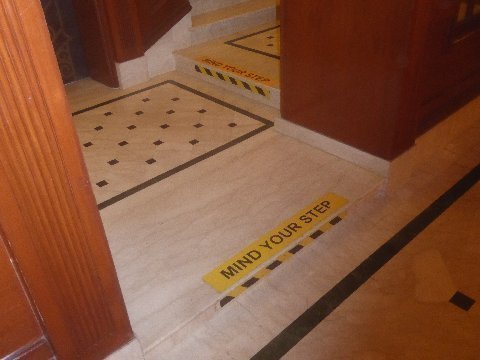
Above: Steps out of elevator. 1st Floor. Imperial Hotel. Delhi, India. 05 January 2015.
No OSHA like rules in India yet. One sees "OSHA violations" everywhere. After tripping up a couple of times I've found myself frequently looking towards my feet when I begin to walk, pass through a doorway, or otherwise find myself in some kind of a transition location.
Does OSHA like thinking make our lives better.... or does it dumb us down to the point where we erode one's natural inclination to be careful?

Above: Shower. Imperial Hotel. Delhi, India. 05 January 2015.
In the hotels where we stay, the showers are THE best! Hot water, rushing out at what must be three times the flow of the pathetic water saving faucets we have in the United States.
No water flow regulations in addition to no OSHA like regulations. Just business license regulations!
My best shower ever was in India. Nanital. 1973. TIMDT, FeeBee, and Mwah (sic) drove to Nanital from Delhi for a long weekend. We got lost on the way, had a car breakdown, and were rescued by a resourceful Sikh landowner on whose land we found ourselves. He fixed our car and set us, with firm directions, on our way.
We arrived in Nanital about 10:00 PM. We were hot and tired. Immediately on reaching the room I headed for the shower. The flow of that hot shower came out like it was a broken water main. I stood there for 15 minutes... until the hot water started to cool. That Nanital shower remains my all time best shower ever.

Above: Print of Qutab Minar from hallway of Imperial Hotel, Delhi, India. 05 January 2015.
TIMDT produced this image to prove her claim that Qutab Minar must have been restored considerably since we lived in Delhi in 1973.
This lithograph is from the mid 19th century and everything but the tower itself looks destroyed. And, so it was, says TIMDT, more or less in 1973.
UNESCO has accomplished a lot of restoration in the last 42 years.

Above: Tea time. Imperial Hotel. Delhi, India. 05 January 2015.
I took tea and worked from this spot during late afternoon. At 4:30 PM I proceeded to the hotel spa for a manicure, pedicure and head massage scheduled for me by TIMDT.
Addendum:
Trident hotel not Tridon.
TIMDT,
Delhi, India
Thanks Steve. After reading today's blog I'll get the book. Thanks for the insight and sharing your first hand experiences. Maybe one day I will go, if I get up the nerve.
Bill,
Salt Lake City, UT
Well stated. Trust you (and we!) will survive the pollution!
Cheeta,
Vancouver, BC
Are you sure this isn’t Dheli?
Jack Aroon, Mahwah, NJ
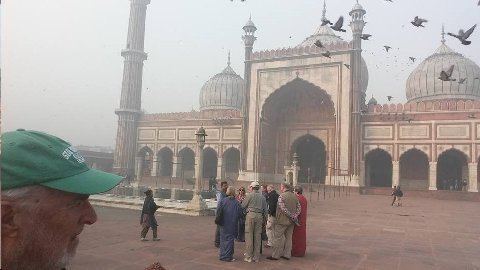
Above: Bishop observes Jama Masjid Mosque. Delhi, India. Margaret Taylor Dance Troupe in the foreground. Note ubiquitous pigeons. Delhi, India. 06 January 2016.
The Bishop was here last week, but couldn't get in as it was Friday. That day, Delhi's chief Imam also visited the mosque which was surrounded by elite security forces.
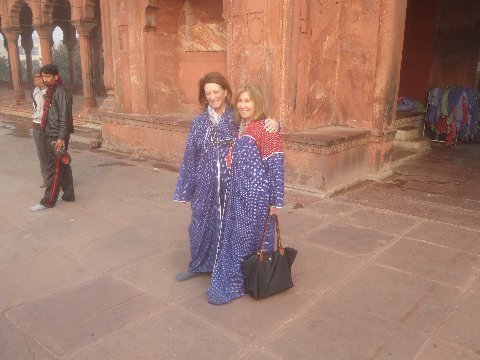
Above: Heat and Spago, members of the Margaret Taylor Dance Troupe. Jama Masjid Mosque, Delhi, India. 06 January 2016.
Piously clad as is required for ladies by mosque authorities.
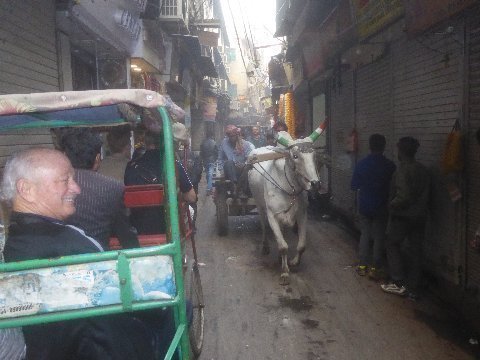
Above: Montage and the bullock. Chandni Chowk. Delhi, India. 06 January 2016.
Traveling in India with the Margaret Taylor Dance Troupe.
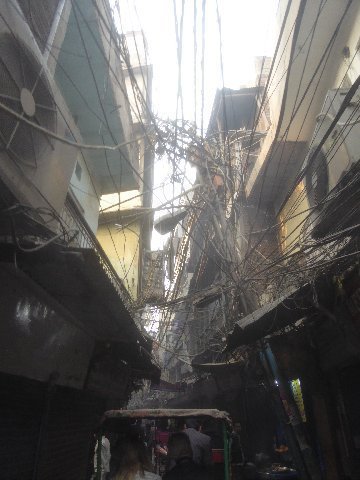
Above: Spaghetti wire. Chandni Chowk. Delhi, India. 06 January 2016.
When there's a power problem, how do they figure out which wire goes to which user?
Touring India with the Margaret Taylor Dance Troupe.
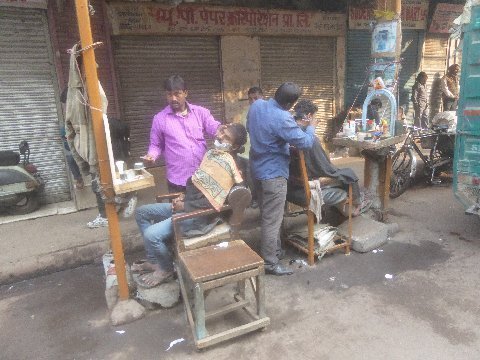
Above: Barber "shop." Chandni Chowk, Delhi. 06 January 2016.
Shave and a haircut six bits.
Touring India with the Margaret Taylor Dance Troupe
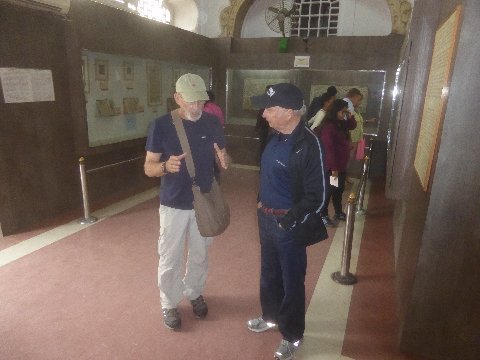
Above: The Admiral and Montage. Red Fort Archaelogical Museum, located in the Mumtaz Mahal of the Red Fort In Delhi.
The museum contains paintings, artifacts, calligraphy, fabrics and other objects dating from the Mughal era.
Here The Admiral and Montage discuss the Volvo IPS propulsion system on the Admiral's Riviera 53 EB boat.
The Admiral and Montage are touring India with The Margaret Taylor Dance Troupe.
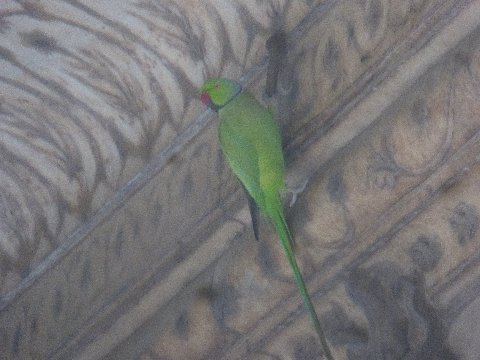
Above: Parrot. Silver plate ceiling. Hall of Private Audiences. Red Fort. Delhi, India. 06 January 2016.
Traveling in India with the Margaret Taylor Dance Troupe.
Adept story teller Ajay relayed the following story as members of the Margaret Taylor Dance Troupe stood, rapt, by the Hall of Private Audiences:
Prithviraj Chauhan (1149–1192 AD) was the ruler of Ajmer and Delhi in the 12th century AD. During his time, Afghan ruler Muhammad Ghori invaded India. Prithviraj Chauhan defeated Ghori in 1191 AD in the first battle of Tarain. However, Prithviraj released the vanquished Ghori and let him travel back out of India. However, Muhammad Ghori started to regroup his forces again and returned to challenge Prithviraj at the Second Battle of Tarain in 1192 AD.
In an epic battle, Prithviraj was defeated and captured by the Afghan forces. Muhammad Ghori had the captured king's eyes burnt with red hot iron rods and took the blinded Prithviraj back with him to Gazni. Along with the king went his trusted poet and advisor, Chand Bardai.
In Gazni, Prithviraj was regularly brought to Ghori's court and taunted and insulted by Ghori and his courtiers. To avenge his insult, Prithviraj and Chand Bardai devised a plan for retribution. Chand Bardai told Ghori that Prithviraj, a renouned archer, was an expert in "Shabd-Bhedi Baan", ie, could hit a target blind folded just by hearing the sound it made. Ghori was immediately interested in seeing such skills and called for an archery display in his court. The blind Prithviraj was brought in and handed a bow and an arrow. A goat was tied to a pillar and Prithviraj was told to display his skills by killing the goat.
Instead, Chand Bardai skilfully told the king the seating position of Ghori through the following couplet:
Char Bans Chaubi Gaj, ungal asat parman;
Ta upar sultan hai, mat chuke Chauhan.
(Four Bamboo lengths in front, then twenty four hands and eight fingers in height, the sultan is sitting. Don’t miss him Chauhan)
Prithviraj Chauhan, based on the directions of his poet friend, lined up his arrow and shot Muhammad Ghori through his throat. Before the Afghans could capture both the Rajput warriors, Prithviraj and Chand Bardai stabbed each other.
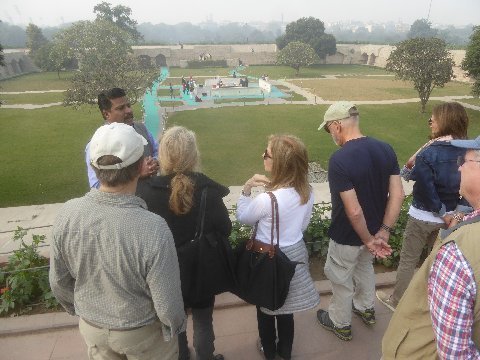
Above: Members of the Margaret Taylor Dance Troupe listen to Ajay at Raj Ghat, cremation memorial of Mahatma Gandhi. 06 January 2015.
Could Gandhi-ji have saved India... prevented its partition in 1947?
Ajay says yes.
Either Jinnah or Nehru were willing to preside over an undivided India, but each insisted on the partition option to prevent the other from running the whole show.
Could Gandhi-ji have been more persuasive to Nehru that he back off of his demand for leadership, allowing Jinnah to take command, knowing that Jinnah, terminally ill, would have been dead in six months anyway? Nehru would surely be head of a united India after Jinnah's death.
Gandhi was assassinated 30 January 1948 by a HIndu nationalist who felt Gandhi didn't do enough to keep India united.

Above: TIMDT and Maui. Piously clad. Gurudwara Bangla Sahib Sikh Temple. Delhi, India. 06 January 2015.
Traveling with The Margaret Taylor Dance Troupe.
Addendum
Are you sure this isn’t Dheli?
Jack Aroon, Mahwah, NJ
What was next on your itinerary after you loaded the kid on a plane in Delhi? Anxiously awaiting next chapter of travelogue.
Country Boy,
Greenwich, CT
Speaking of OSHA, "accidents" wouldn't be called that if you could always avoid them. And that's also why, here in the U.S., we have building codes and electrical codes (presumably, your home meets these).
Don't slip in the hotel shower.
FeeNix
Phoenix, AZ
Have a safe and fun trip!!
Don and Audrey
Las Vegas, NV
Indian Accent.
The Manor
77 Friends colony (west), New Delhi 110 065 India
No. 1 Restaurant in India - Trip Advisor 2014 - Travellers' Choice
San Pellegrino Best Restaurant in India - Asia's 50 Best Restaurants 2015
Amongst 101 Best Places to Eat in the World - Newsweek
Amongst The top 100 Restaurants Worldwide - Foodie Top 100
Best Restaurant in India - Time Out Food Awards
Not "fusion." Rather, "Indian food with a twist." Best example might be our starting amuse bouche... a small nan with melted blue cheese (blue cheese being the twist on the Indian theme."
Restaurant opens in New York City in February 2016. Meridian Hotel, mid-town.
Hat tip: Heat
Review: One of the more memorable dining experiences ever! The Bishop

Above: Tasting Menu with wine pairing


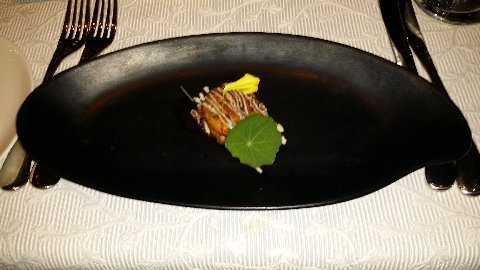

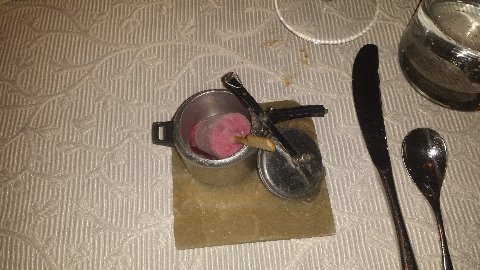
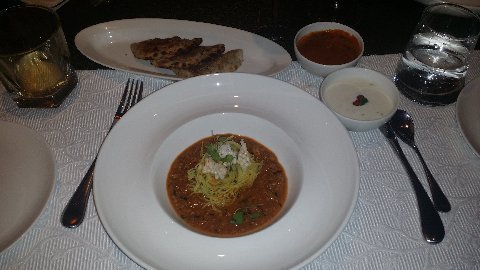
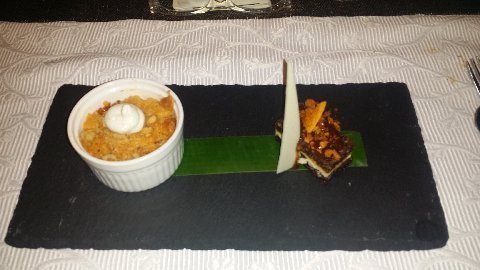
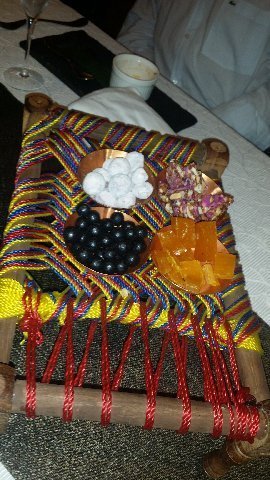
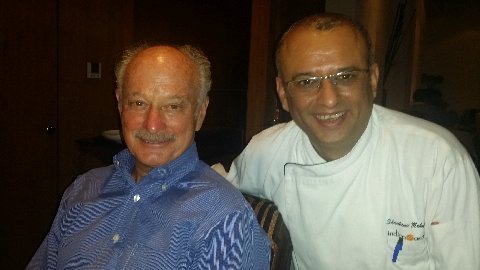
Above: Montage. Chef Shantanu. Indian Accent.

Transfer day. Delhi to Jodhpur. Delhi fog delayed departure by one hour. We got aloft by 12:30 PM and arrived in Jodhpur 2:00 PM.
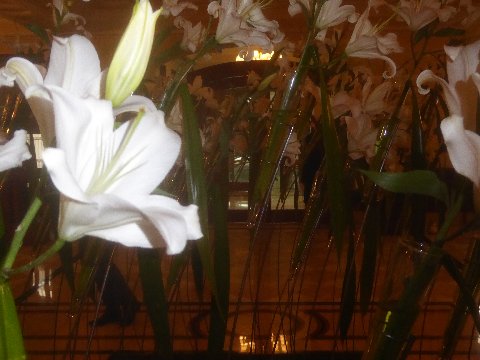
Above: Lilies. Lobby Imperial Hotel. Delhi, India. 07 January 2016.
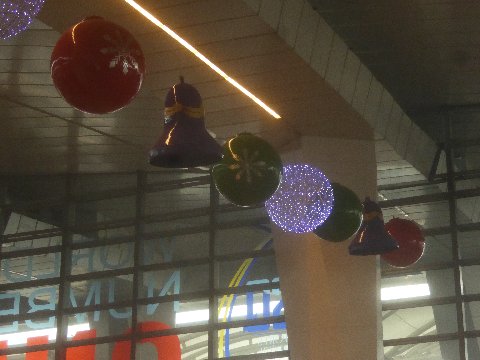
Above: Christmas Decorations. Delhi Airport. Delhi, India. 07 January 2016.
Isn't there some rule about when Christmas decorations should be removed?
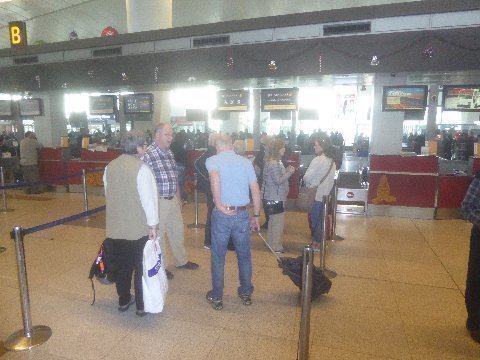
Above: Members of Margaret Taylor Dance Troupe. Delhi Airport. Delhi, India. 07 January 2016.
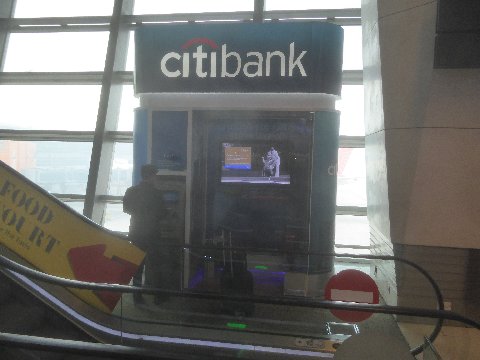
Above: Citibank ATM. Delhi Airport. Delhi, India. 07 January 2016.
Neither my or TIMDT's Citibank debit cards worked in this ATM. I didn't hang around to see if the pictured user was successful in completing his transaction.
My card worked at the Connaught Place Citibank branch ATM a day or two ago.
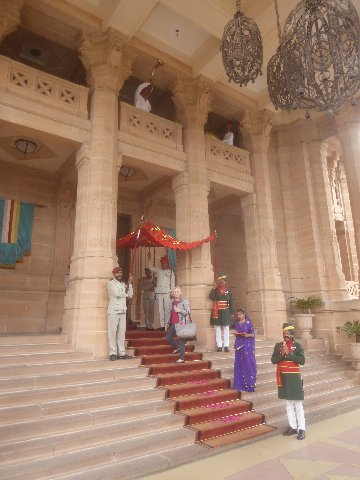
Above: TIMDT arrival at Umaid Bhawan Palace Hotel. Jodhpur, Rajasthan, India. 07 January 2016.
Trumpet fanfare... rose petals... TIMDT getting the welcome she deserves!
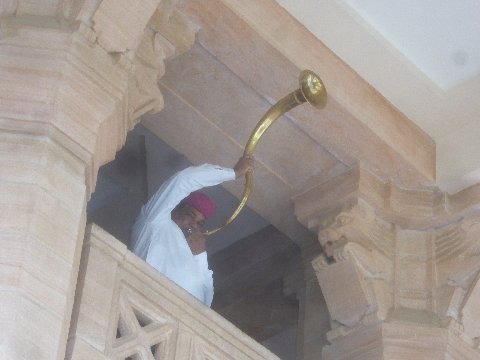
Above: Trumpeter. Umaid Bhawan Palace Hotel. Jodhpur, Rajasthan, India. 07 January 2016.
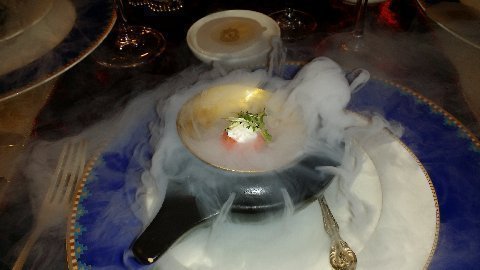
Above: Watermelon Amuse Bouche. Lunch. Umaid Bhavan Palace Hotel. Jodhpur, India. 07 January 2016.
Addendum:
Jack- Steve thought he was going to the New Carnegie deli but ended up in India.
Vegas,
Park City, UT
What's the story behind The Margaret Taylor Dance Troupe?
Dennis,
Pensacola, FL
One of our group, 1%, gave TIMDT's traveling team the name, last year, while the group was traveling in southern India.
Could you tell what method they use to keep the pigeons from soiling the Jama Masjid Mosque shown in the picture?
Nathans,
Massapequa, NY
Pigeon poop all over the place. Irony. Have to take off your shoes. Some of our group brought extra socks for the purpose.
....Been following and enjoying your emails, looks like good fun and group--missing it. But, about to land in Phoenix for big shoot out Monday, Roll Tide!!
Mezzanine,
Miami, FL
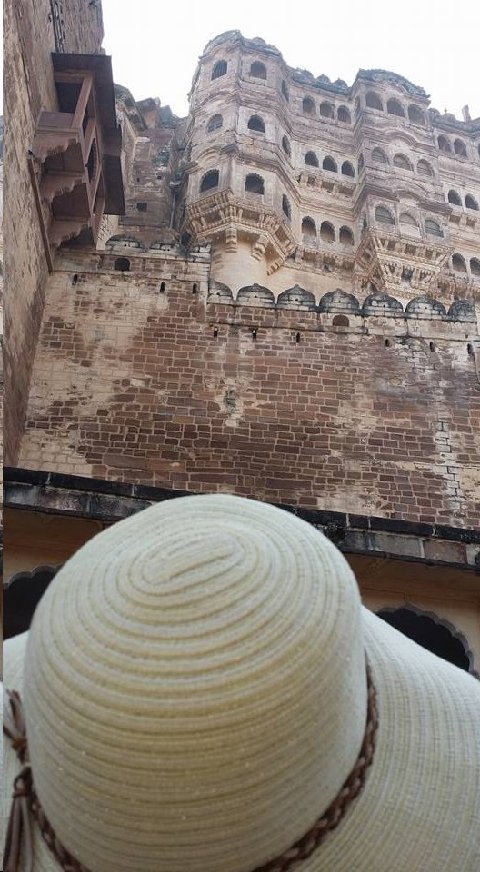
Above: TIMDT gazes at palace residence of Mehrangarh Fort. Jodhpur, Rajesthan, India. 08 January 2015.
Lonely Planet: Driven from their homeland of Kannau, east of Agra, by Afghans serving Mohammed Ghori, the Rathore Rajputs fled west around AD 1200 to the region around Pali, 50 miles which grew Jodha's city: Jodhpur.southeast of Jodhpur. They prospered to such a degree that in 1381 they managed to oust the Pratiharas of Mandore, 6 miles north of present-day Jodhpur. In 1459 the Rathore leader Rao Jodha chose a nearby rocky ridge as the site for a new fortress of staggering proportions, Mehrangarh, around.

Above: Maui, TIMDT, Spago, Heat, and Opium smoking Marwari (The Admiral at right). Mehrangarh Fort. Jodhpur, Rajesthan, India. 08 January 2015.
The Margaret Taylor Dance Troupe in India - 2016.
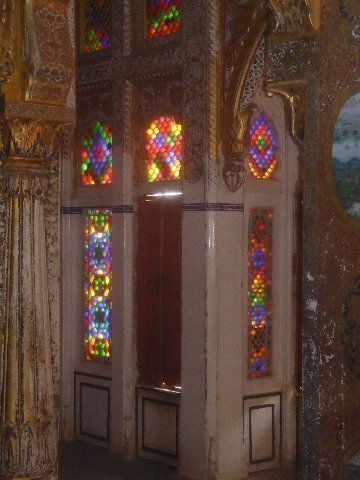
Above: Stained Glass. Mehrangarh Fort. Jodhpur, Rajesthan, India. 08 January 2015.
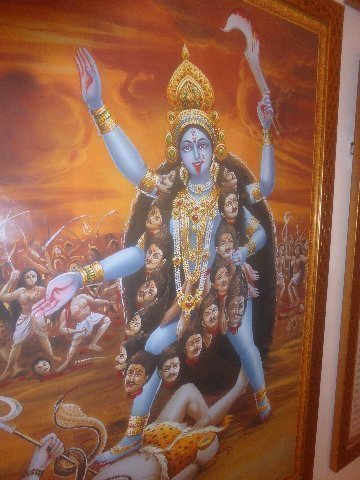
Above: Kali, incarnation of Hindu goddess Devi. Painting. Mehrangarh Fort. Jodhpur, Rajesthan, India. 08 January 2015
Mehrangarh Fort, Jodhpur is a pilgrimage destination for worshipers of the Hindu goddess Devi.
Kali Defeats the Demons
The Gods waged war with the demons. The Gods were losing badly and were about to go down in defeat. The following is a description of this event as described by Elizabeth Harding in her seminal book Kali, the Black Goddess of Dakshineswar.
When the Gods lay exhausted after warring with the demons, the evil-natured demon king Mahishasura took the opportunity to assemble an army and declare himself Lord of Heaven, Ruler of the Universe.
This blasphemy reached Vishnu's ears and, in anger, he shot forth a terrible light from his forehead. Shiva, too, was angry. ascended from his lofty state of meditation and beamed a sharp ray of blinding light in the same direction as Vishnu. Brahma, Indra and the other mighty Gods did likewise, each issuing forth piercing rays of light. All the Gods' rays joined at one point and, slowly, the blazing concentration of light took shape in the form of a woman.
The light of Shiva formed her face; Yama gave her hair and Vishnu her arms. From the light of Chandra, the moon God, her two breasts were formed. Indra modeled her waist and Varuna her thighs. Earth gave her hips and Brahma gave her feet. The light from the fire God, Agni, fashioned her three eyes. Thus, all gods contributed their power to manifest the auspicious Devi, the great Mother Goddess ("Devi" is derived from the Sanskrit root word "div" which means "to shine" - the Shining One).
As soon as the Devi was fully formed, the Immortals prayed to her and worshiped her with praise, ornaments and weapons. Shiva gave her a trident drawn forth from his own, Vishnu a powerful discus, and Indra, the king of the Gods, gave her a thunderbolt identical to his own. Surya, the sun God, bestowed his rays on all the pores of her skin, and Varuna, God of the ocean, gave her a divine crest jewel, earrings, bracelets and a garland of unfading lotuses.
"Victory to the Mother," shouted the Gods as they watched the demon battalions approach with the beating of drums, battle cries, and the blowing of conches. Since the
Devi was of enormous size and highly visible, the demons marched straight toward her, attacking from all sides with arrows, clubs, swords, and spears.
Unperturbed, the Devi roared loudly and laughed a frightening, defiant laugh. Again. And again. And then her ten arms rotated, alternately smashing weapons of the demons and hurling them back at her attackers. With great ease, she picked up dozens of demons at once, killing them with her sword. Some demons she didn't even bother to pick up. She stupefied them with the tremendous noise of her bell and then crushed them with her mace.
The demon Raktabija gave the fierce Mother Goddess a fair amount of troubles. He possessed a special magical power which allowed him to create new demons from his own blood. Whenever the Goddess wounded him, each drop of blood that spilled to the ground sprouted another demon full of strength and brutality. But in the end the Mother outwitted him. She picked up Raktabija and lifted him high into the air to avoid spilling his blood on the ground, and then, gnashing him between her teeth, she drank his blood and swallowed him whole.
Other demons, too, tried to confuse the Goddess with their magical powers. Whenever they were threatened by the Devi, they changed their form and color. But, who can escape the great Mother? Bound by her noose and spitting blood, these demons were soon caught by the Devi. And like a child pulling a toy train, she dragged them over the battlefield where scores of demons already lay split into two by the sharp slashes of her sword.
Snatching some elephants with one hand, the Devi flung them into her mouth and, together with the demon drivers, she furiously ground them up with her teeth. She seized one demon by the hair and another by the neck. One she crushed by the weight of her foot and another she crushed with her body.
The Mother's terrible presence filled even the sky. Black clouds gathered and terrifying lightning lit up the ghastly shapes on the ground. There were demons without arms, without legs, and demons torn asunder in the middle of their trunks.
When Mahishasura, the king of the demons, saw his army devastated by the blows of the terrible Mother Goddess, his fury knew no bounds. He expanded his body to take on the fierce shape of a giant buffalo. Intoxicated with his own strength and valor, he roared and charged toward the Devi.
"Roar, roar, O fool," shouted the Goddess. "Roar for a moment. When you are slain by me, the gods will soon roar in this very place."
The earth began to tremble under the stomping feet of the Goddess. Mahishasura fought with all his might but could not conquer the Devi. So he appealed to her sense of justice, complaining that she fought in an unfair way. The Devi, he claimed, received help from so many fierce Goddesses - Durga, Kali, Chamunda, Ambika, and others - and he, Mahishasura, had to fight all by himself.
"I am all alone in the world here," thundered the Devi. "Who else is there besides me? See, O vile one, these Goddesses are but my different powers which again enter into my own self. I stand alone. Don't back off; defend yourself."
The savage fight continued, and the great demon attacked the Mother Goddess with showers of arrows. He hurled discuses, swinging his clubs and mace. To no avail. The Devi killed him with her spear, releasing the soul from its evil-natured body and mind.
Dust clouds carried the stench of singed skin and rotting flesh to the blood-red horizon. The demons had been killed, and their blood flowed, accumulating here and there in small pools around the carcasses of elephants and horses. Only some headless torsos of demons who refused to give up life still fought the Devi. The battle shrieks had died and the only cries now were those of jackals and hyenas. There was nothing left to kill, but the blood-intoxicated Mother in the form of Kali continued the carnage - smashing and slashing dead demons all over again.
The Gods, who had begun to celebrate victory, became filled with fear. Who was going to stop her? There was only one who could: Shiva, the great God. Besmeared with ashes, the third God of the Hindu Trinity went to the battlefield and lay down motionless among the corpses while the rest of the Gods watched from a safe distance.
The intoxicated Kali staggered across corpses until, suddenly, she found herself standing on top of a beautiful male body - nude and besmeared with white ashes. Awed, she stood still for a moment, looked down at him, and saw straight into the eyes of her husband Shiva. When she realized that she was touching her divine husband with her feet - an unthinkably disrespectful act for a Hindu wife - Kali stretched out her tongue in shame and the destruction came to an end.
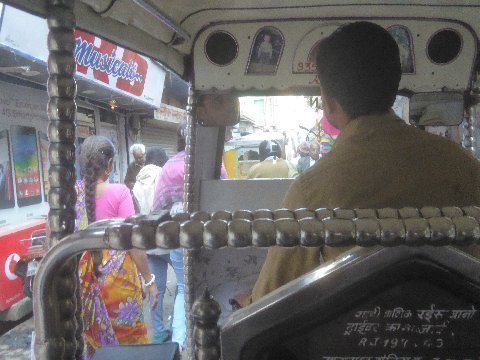
Above: Jodhpur street from tuk tuk (autorickshaw). Jodhpur, Rajasthan. 08 January 2015.
Mr. Toad's Wild Ride. Rabbit warren streets... 23 near misses between the fort and lunch spot, Raas Haveli hotel and restaurant.
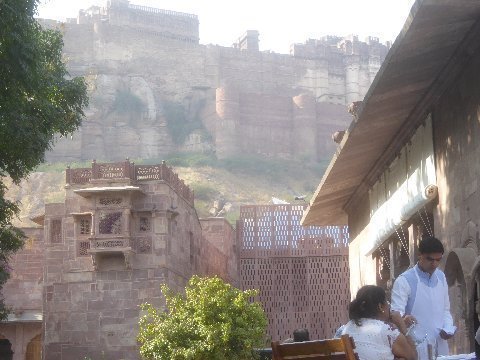
Above: Mehrangarh Fort. Jodhpur, Rajesthan, India. 08 January 2015.
From Raas Haveli Restaurant/Hotel, our lunch spot.
Mehrangarh is one of the most magnificent forts in India. The battlements are 20 feet to 120 feet high, and as the building materials were chiseled from the rock on which the fort stands, the structure merges with its base. The fort is still run by the Jodhpur royal family.
The size and scope of the fort is staggering. Inside the residences, the fort has been turned into a museum.
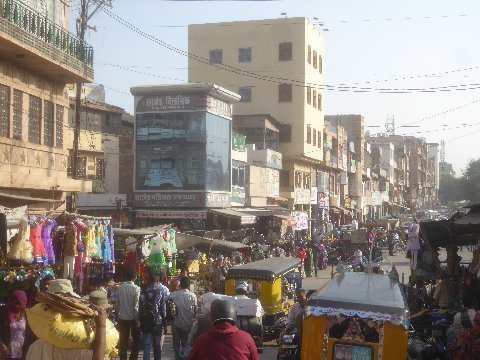
Above: Sardar Market Girdikot. Jodhpur, India. 08 January 2015.
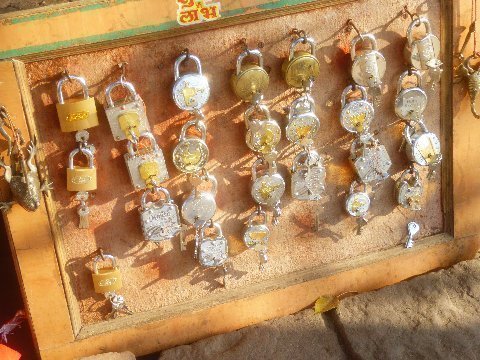
Above: Locks for sale. Sardar Market Girdikot. Jodhpur, India. 08 January 2015.
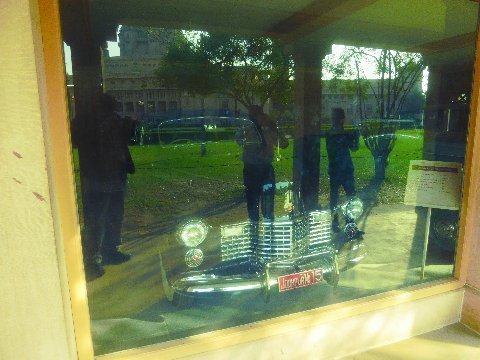
Above: Vintage 1939 Cadillac from collection of Maharaja Gaj Singhji of Jodhpur. Umaid Bhavan Palace. Jodhpur, India. 08 January 2015.
Window reflects the Umaid Bhavan Palace.
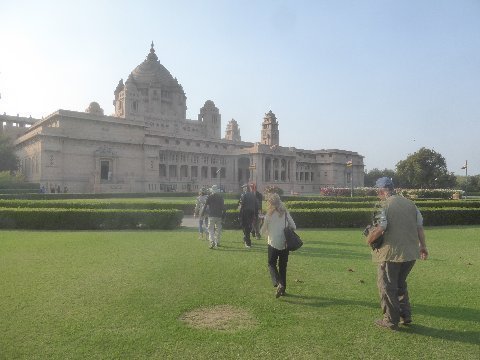
Above: Umaid Bhavan Palace of Maharaja of Jodhpur. Jodhpur, India. 08 January 2016.
Members of the Margaret Taylor Dance Troupe return to Palace (hotel) from the Maharaja's car collection museum.
The current royal incumbent, Gaj Singh II (known as Bapji), still lives in part of this building. Construction commenced in 1929. The building was completed in 1942. It is India's newest maharaja palace.
The 365 room edifice was designed by the British architect Henry Lanchester for Maharaja Umaid Singh. It took more than 3000 workers 15 years to complete. The building is mortarless and incorporates 100 wagon loads of Makrana marble and Burmese teak in the interior. The story goes that the construction began as a royal job-creation program during a time of severe drought. Much of the building has been turned into a five star hotel, now run by Taj Hotels.
Addendum:
Nice pictures Steve. Wish you had also included Goa in your schedule.
We will be there Jan 21-27.
Cheers...
Scout,
Mumbai, India
Sorry to have missed you. Staying north this time.
Beautiful pictures of the birds!
Thanks, Manhattan,
Park City, UT
Stunning! Fabulous "Bird Art." Thanks for sharing on this ultra cold, but blue-sky, day in Wisconsin
Music in the Mountains
Fond du Lac, WI

Above: Grrr, Z, and Rudy, Jr. 07 December 2016. Salt Lake City, UT
Thy (sic) hire guano wallahs from Massapequa to clean up.
Jack Aroon, Mahwah, NJ
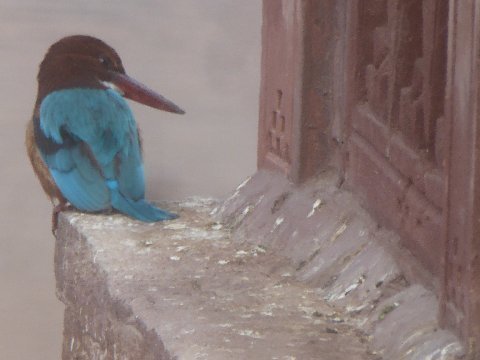
Above: Kingfisher. On outer wall of Jaswant Thada, royal memorial to Maharaja Jaswant Singh. Jodhpur, India. 08 January 2015.
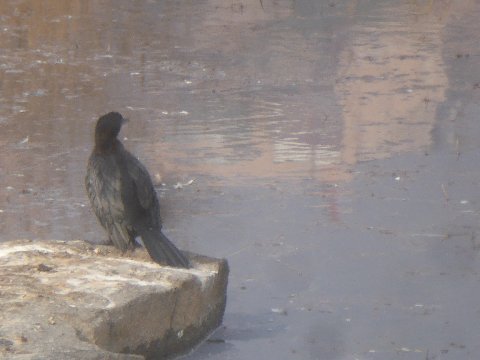
Above: Cormorant. Pond near memorial to Maharaja Jaswant Singh. Jodhpur, India. 08 January 2015.
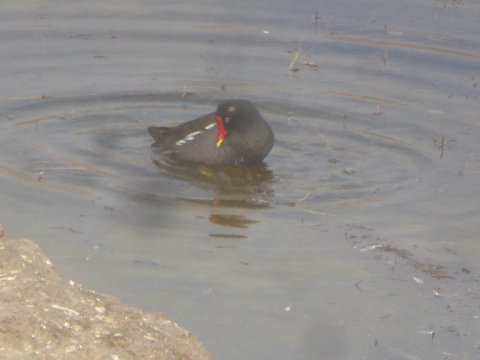
Above: Indian Moorhen. Pond near royal memorial to Maharaja Jaswant Singh. Jodhpur, India. 08 January 2015.
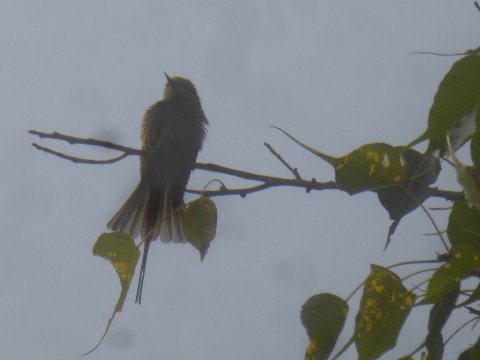
Above: Green Bee Eater. Pond near royal memorial to Maharaja Jaswant Singh. Jodhpur, India. 08 January 2015.
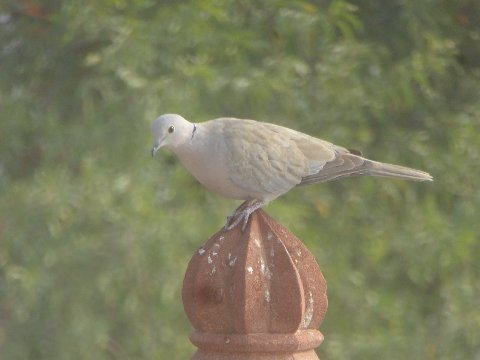
Above: Eurasian Collard Dove. Near royal memorial to Maharaja Jaswant Singh. Jodhpur, India. 08 January 2015.
Transit day by coach. Jodhpur to Jawai Leopard Camp. Sumerpur, Rajasthan, India.
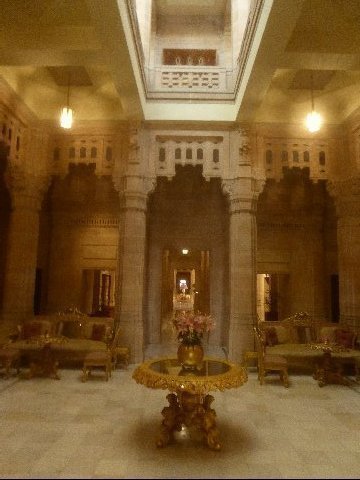
Above: Atrium. Umaid Bhavan Palace Hotel. Jodhpur, India. 09 January 2016.
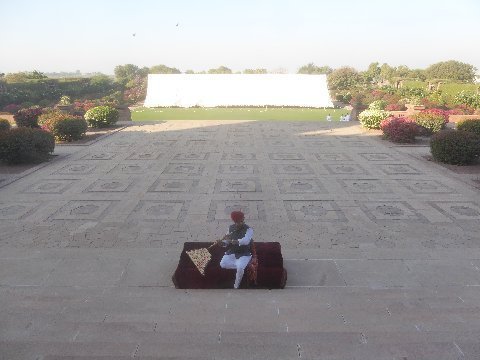
Above: Flutist. View from breakfast terrace. Umaid Bhavan Palace Hotel. Jodhpur, India. 09 January 2016.
Haunting and beautiful breakfast atmospherics with the background flute music.
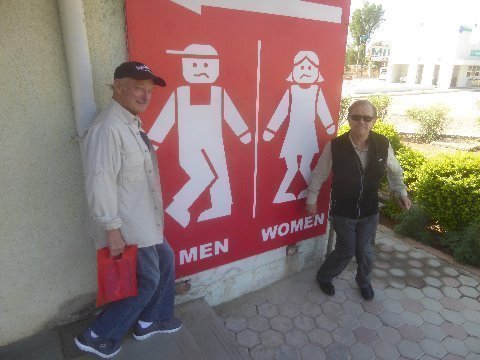
Above: Montage and 'Cake pose in front of rest stop restroom sign on NH (national highway) 8 between Jodhpur and Udaipur, Rajasthan, India. 09 January 2015.
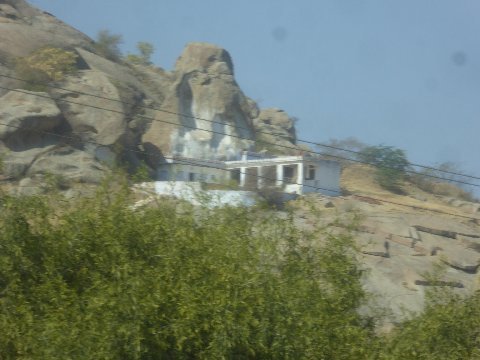
Above: Hindu Temple on granite rock. Sumerpur, Rajasthan, India. 09 January 2016.
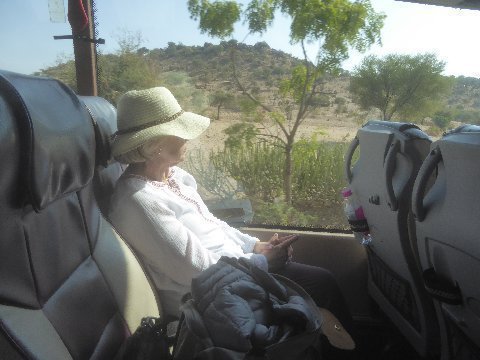
Above: TIMDT in coach seat. Near Sumerpur, Rajasthan, India. 09 January 2016.
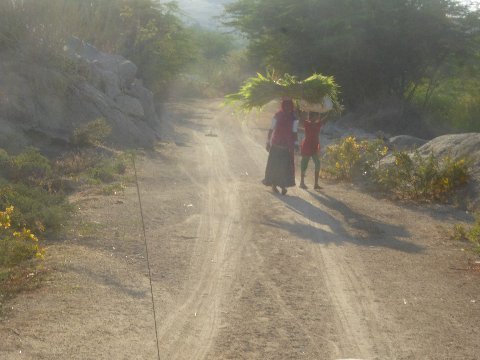
Above: Rajasthani village woman and child. Sumerpur, Rajasthan, India. 09 January 2016.
Addendum:
Stunning! Fabulous "Bird Art." Thanks for sharing on this ultra cold, but blue-sky, day in Wisconsin
Music in the Mountains
Fond du Lac, WI
Beautiful pictures of the birds! Thanks, Manhattan
Wildlife shots captured on entry (Nilgai and Stonechat) to Jawai Leopard Camp and later, after checking into the camp, on our first safari outing.
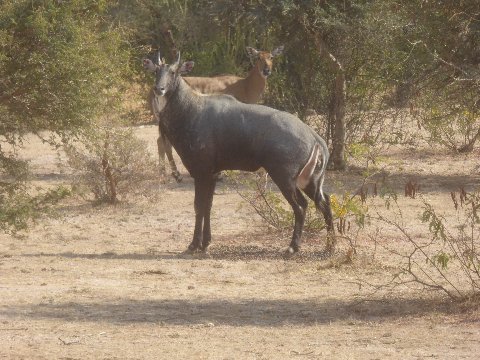
Above: Nilgai (Blue Bull). Jawai Leopard Camp. Sumerpur, Rajasthan, India. 09 January 2016.
Foreground, bull. Behind, cow.
In 1973 friend and Citibank boss AG took me on a blue bull hunt in Haryana. Around mid-night, five or six of us were riding in a cart pulled by a tractor. Someone said, "Stop! There's a blue bull!" In the moonless night we thought we saw the outlines of a nilgai, but, were unsure. Still, all five of us began firing away from the cart at the wraithlike form. We drove over to the site of the "apparition" after the barrage and found nothing. False alarm. It sounds funny now... and it was funny at the time. We continued to ride around until pre-dawn, but, found no prey to shoot.
We alit from the cart at dawn, switched to shotguns, and began looking for birds. I was with AJ when we came upon a tree loaded with dove. "Shoot the tree," said AJ. "What,?" I replied? "The whole tree?" "Yes!" exclaimed AJ.. I fired and about a dozen doves, of four times that many, dropped to the ground. "Isn't this irresponsible to kill so many birds in this manner," I righteously asked. AJ: "No... of course not. We'll take the birds to the villagers and they will all be gratefully consumed."
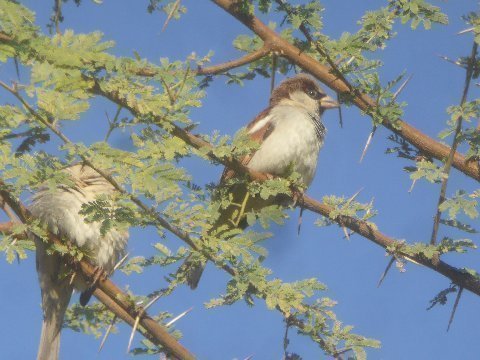
Above: Common Stonechat (?). Jawai Leopard Camp. Sumerpur, Rajasthan, India. 09 January 2016.
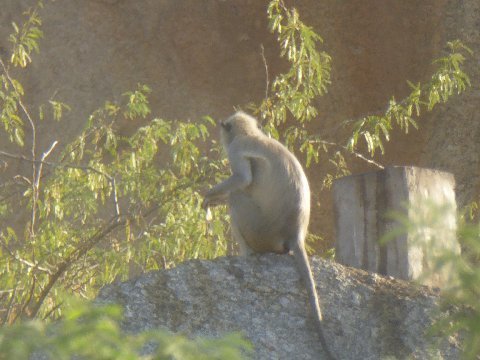
Above: Lemur. Jawai Leopard Camp. Sumerpur, Rajasthan, India. 09 January 2016.
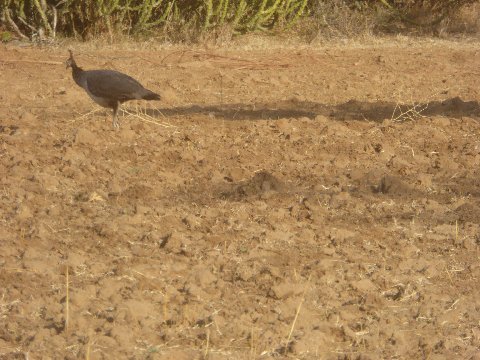
Above: Grey Francolin. Jawai Leopard Camp. Sumerpur, Rajasthan, India. 09 January 2016.
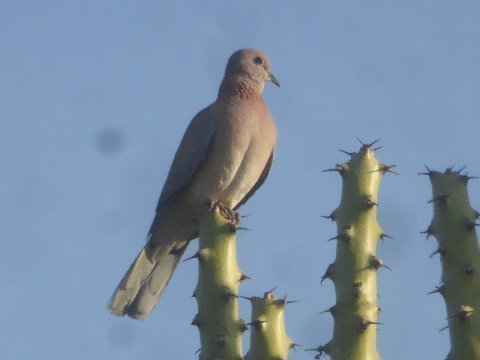
Above: Eurasian Collared Dove. Jawai Leopard Camp. Sumerpur, Rajasthan, India. 09 January 2016.
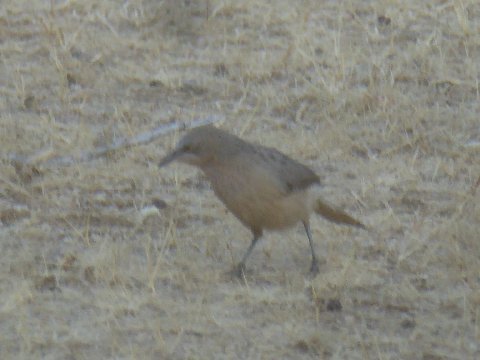
Above: Grey Babbler. Jawai Leopard Camp. Sumerpur, Rajasthan, India. 09 January 2016.
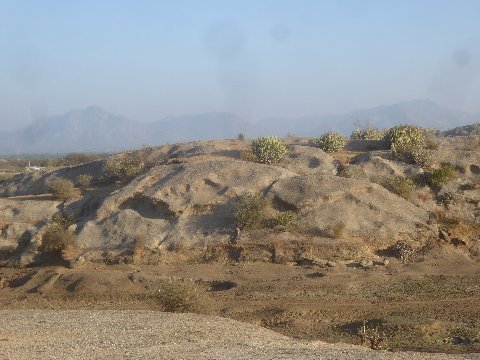
Above: The site of our first leopard sighting. Jawai Leopard Camp. Sumerpur, Rajasthan, India. 09 January 2016.
I didn't catch Nigel at this very spot. While seated in the Maruti safari vehicle with excellent high powered binoculars provided by the camp, I listened to the guides. "See that round rock? Go to the flat rock above it. See the euphobia bush above the flat rock? Look to the left of the bush. Nigel is lying down, only head visible, at the base of the bush.
Nada. I couldn't see anything. This sighting, only 1% spotted the leopard.
Then, dusk coming on, the guides chattered by radio amongst themselves and started driving down an unimproved jeep track leading to the right of the spot where Nigel was first sighted. The Marutis rounded a corner and began a decent down a hill towards a large rock facing, increasingly ill defined in the waning light.
Varun, the head guide, turned a high powered beam on the rock. There was Nigel, two hundred feet away... walking slowly from our left to our right, along the base of the rock face. While seated in the Maruti safari car, I was able to get a clear, close-up view of Nigel through the binoculars. Nigel lay down, then got up again and continued walking. He seemed to be unfazed by the beam. Finally he walked out of site.
Because it was dark... and because of the distance... I didn't think I would be able to get an image with either of my two devices... a Panasonic Lumix small camera and my Samsung Galaxy Note 3. Wow! Fulfilled! A leopard sighting our first outing.
Addendum:
Hi Steve
Thanks for keeping me on your mailing list.
I am just sending you the link to a program that I watched on an Indian channel called NDTV. This is about how the world economy is confronted with a global recession situation and also some very intriguing insights into the global economy, particularly chinese, indian.
The new buzz word in global economy I believe is FANG and not BRIC any more. It’s no more about the countries but corporations that are dominating the global economy many of which are not even listed stocks.
Happy Travels.
Mohan, TravelScope India
Delhi, India
Much appreciated. Helps in understanding the challenges and opportunities of this dynamic country.
Thanks for sharing your magnificent trip.
LaDoc and LaPsy,
Los Angeles, CA
Unbelievable Steve! In my 91 years, how little I have known about India's lore!
Thanks,
Manhattan,
Park City, UT
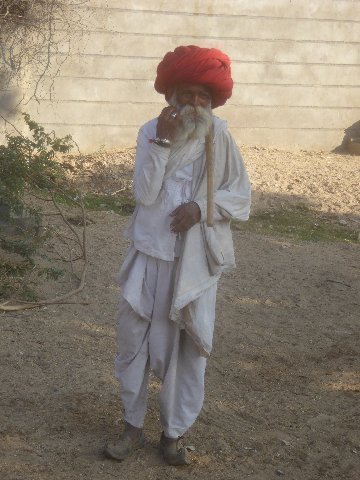
Above: Marwari cattle herd. Sumerpur, Rajasthan, India. 10 January 2016.
We surmised that this gentlemen was younger than he looked. We asked him. He said he was fifty five. These people have been working the cattle in this area for centuries, in the same manner. One wonders if the "new India" will also result in the extinction of their ways. The young men we noticed helping with the cattle were all dressed win western clothes.
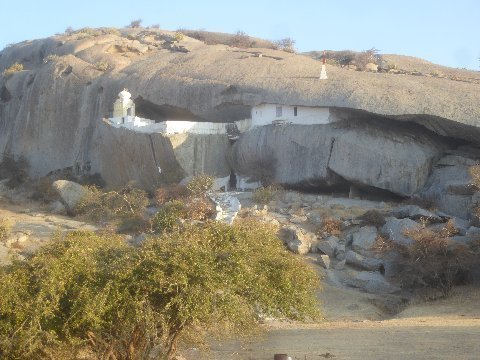
Above: Hindu Temple in granite outcrop. Sumerpur, Rajasthan, India. 10 January 2016.
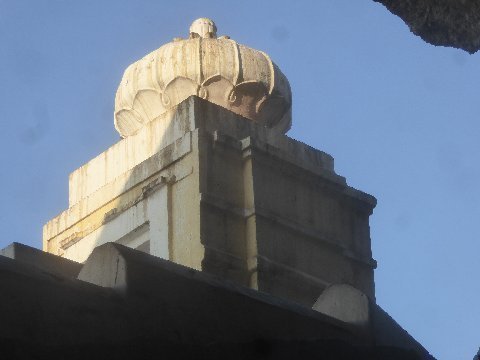
Above: Hindu Temple in granite outcrop. Sumerpur, Rajasthan, India. 10 January 2016.
Hinduism has no founder or central authority and it isn't a proselytizing religion.
Hindus believe that earthly life is cyclical: you are born again and again, the quality of these rebirths being a righteous life and fulfilling your karma (moral code of behavior, social duty( will enhance your chances of being reborn into a higher caste and better circumstances.
Alternatively, if enough bad karma has accumulated, rebirth may take animal form. But it's only as a human that you can gain sufficient self-knowledge to escape the cycle of reincarnation and achieve moksha (liberation).
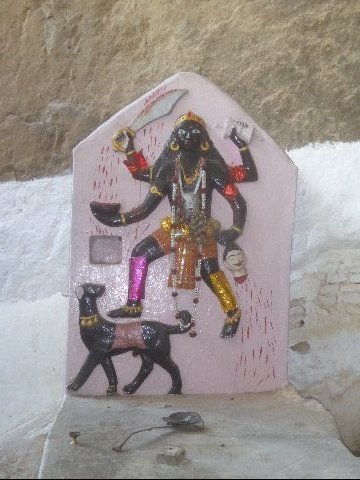
Above: Hindu Temple idol (Devi or one of her incarnations?) in granite outcrop. Sumerpur, Rajasthan, India. 10 January 2016.
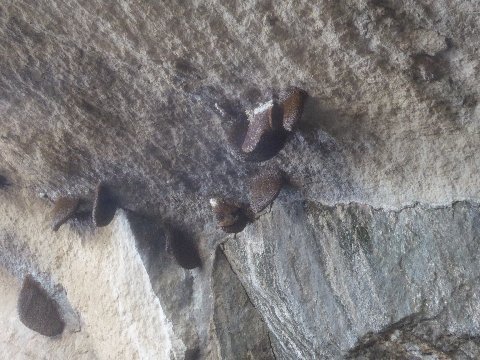
Above: Beehives. Hindu Temple in granite outcrop. Sumerpur, Rajasthan, India. 10 January 2016.
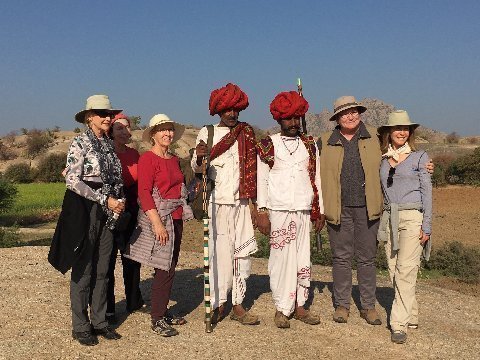
Above: Maui, Comic Mom, TIMDT, two Marwari cattle herds,Liz, and Spago. Jawai Leopard Camp. Sumerpur, Rajasthan, India. 10 January 2016.
Members of the Margaret Taylor Dance Troupe in India.
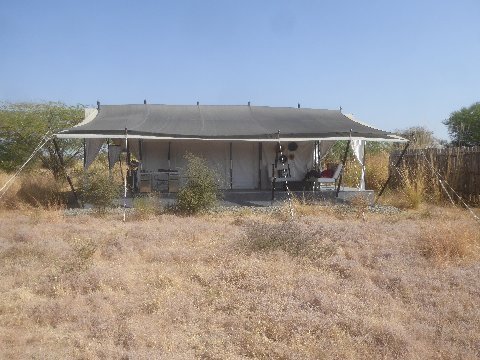
Above. Our tent. Jawai Leopard Camp. Sumerpur, Rajasthan, India. 10 January 2016.
TIMDT can be barely discerned sitting in the divan at right.
Tent had it all. Ample hot water, electricity, internet, space heaters, high thread count, white cotton sheets and duvets.
The camp is dismantled ever year and packed a way for four months during the monsoon season when the area is flooded.
Addendum:

Above: The Bishop, Jumbo, and TIMDT. Amber, India. 01 January 2015. New Year's day.
Hat tip: B1B
Above: The Bishop and Cat. Samod Palace Hotel. 30 December 2015.
Hat tip: FeeBee
Hi Steve,
We're enjoying the travel diary and look forward to the re-cap of your adventures in India and especially appreciate all the great photos, but, it may be time for you to upgrade to the Samsung Note 5...it has an exceptional camera. Keep the notes coming our way! The trip is fascinating! Take care and hugs to Margaret!
Magnolia,
Miami, FL
A serious wildlife photog needs even better than that. The lumix I have is pretty good, but I've been lazy, using only the auto selection. I couldn't figure out how to disable the flash for dusk shots I find it very difficult,also, to spot the animal at a distance through the camera, once I have seen it through the binoculars. Sometimes, by the time you think you have a bead on it, it gets up and moves. The leopard experience has given me some incentive to go the next step with a real SLR and telephoto.
Thank you for the wonderful description of the Safari experience at Jawai. Sounds like a minute to minute account of your Safari.
Mohan,
Travelscope, India
Gurgaon, India
Somehow Grey Eurasian Collared doves have naturalized in Utah. I have fifty or so that live in the trees around our home. They are about the size of domesticated and Feral Rock Doves, also known throughout the world as pigeons.
I enjoy the Eurasian doves. They coo a lot when I am out working in the yard.
Great trip reports.
Regards,
Delhi PJs
Riverton, UT
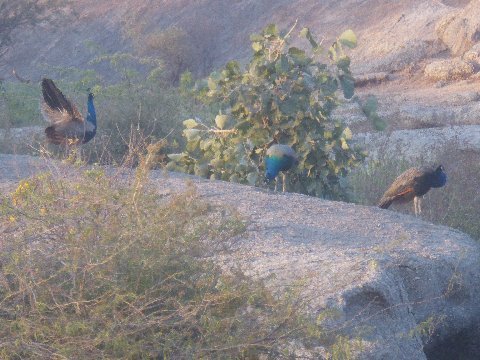
Above: Peacocks and Peahen. Jawai Leopard Camp. Sumerpur, Rajasthan, India. 10 January 2016.
Peacocks and peahens were teaming in large numbers around a nearby Hindu temple.
We left the camp at 7:00 AM to arrive near the above peacock pictured place 20 minutes later. A Maruti carrying other hotel guests was already at this location when we arrived. We were in a different location from where we saw Nigel last night. Our guides had been advised by the trackers hired by Jawai, that Nigel had shifted to this spot.
We saw that the people in the previously arrived Maruti had their glasses trained on a spot in the distance. I raised my glasses... and.... THERE was Nigel, laying down, facing me. It was a stroke of luck that he appeared in the narrowly defined field I selected to view when I first trained the binoculars.
I whispered to my Maruti mates... 1%, Heat, the Admiral, and JD (guide) that I had a sighting. Almost immediately, Nigel arose, and walked about 20 feet into a cave. My sighting lasted about 30 seconds. I would be the only member of The Margaret Taylor Dance Troupe to have a leopard sighting that morning. Heat - diplomatically - said I was making too much noise with my enthusiastic whispering and might have scared him away. I resolved to do a better job of being quiet next outing.
We learned, on returning to the camp, that our neighbors, who were present when we arrived, had been on the scene for a half hour... and had a sighting of Nigel throughout the whole time they were there. We resolved to leave earlier the next morning.
Still, we were two for two in leopard sighting outings. Last night, when all participants caught a glimpse, and this morning with just Mwah (sic) being the leopard sighter.
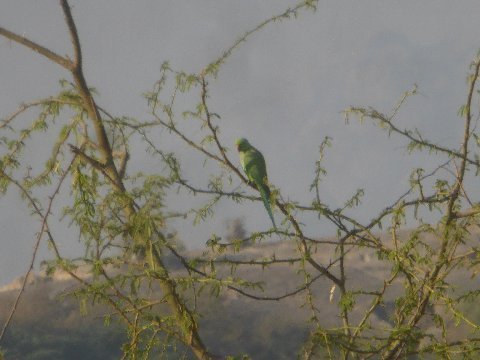
Above: Indian Ring Necked Parakeet. Jawai Leopard Camp. Sumerpur, Rajasthan, India. 10 January 2016.
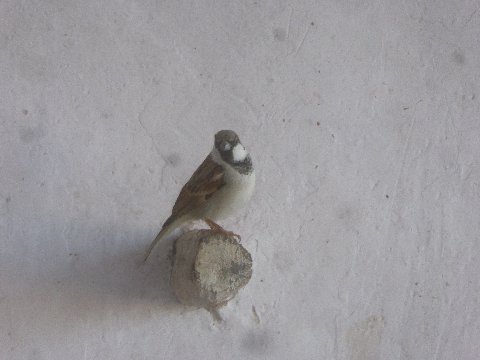
Above: Variable Wheater. Hindu temple. Sumerpur, Rajasthan, India. 10 January 2016.
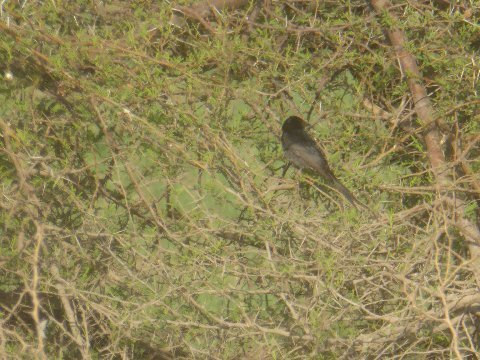
Above: Black Drongo. Jawai Leopard Camp. Sumerpur, Rajasthan, India. 10 January 2016.
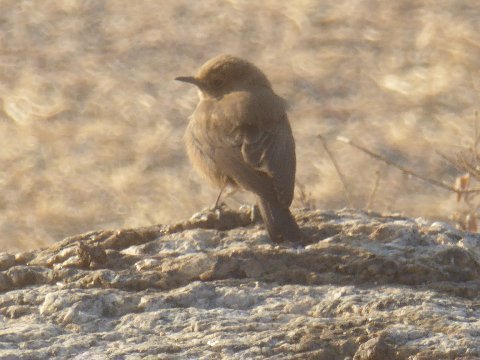
Above: Common Stonechat. Jawai Leopard Camp. Sumerpur, Rajasthan, India. 10 January 2016.
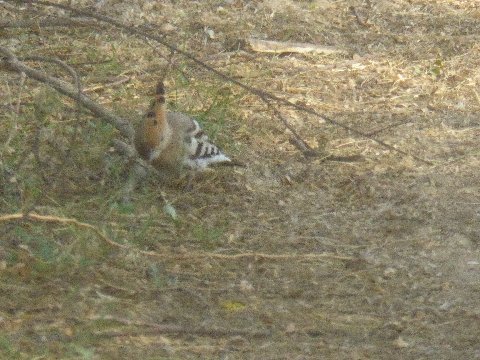
Above: Common Hoopoe. Sumerpur, Rajasthan, India. 10 January 2016.

Above: Green Bee Eater. Sumerpur, Rajasthan, India. 10 January 2016.
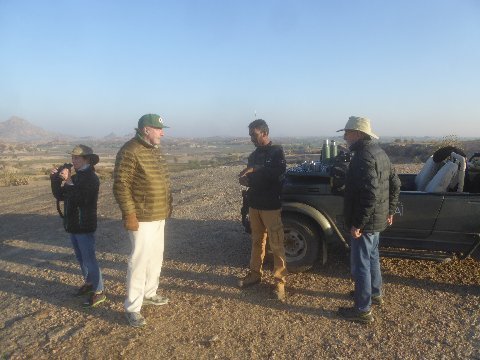
Above: Heat, 1%, JD (guide) and The Admiral. Jawai Leopard Camp, Sumerpur, Rajasthan, India. 10 January 2016.
Post Bishop Nigel sighting coffee break on granite bluff.
Bishop feeling a bit bad that only he sighted Nigel and that his blustery whispers might have scared the cat away.
Addendum:

Above: Skiing the Daly Chutes at Deer Valley with Drums. 09 January 2016.
Image by FeeBee.
The kids started ski classes today. It was a bit crazy when we got there, I guess because it was a Friday afternoon and that is when most kids who are in school can go.
Anyway, there was no where to park close so we followed some other parents and parked in the regular drop off area. We got everything inside and had to wait in line to complete the registration. Then because the boys are older, they were sent to a room upstairs with about 50 other kids. The parents had to help the kids get dressed so I helped the boys get ready and then had to stand in line again to get them signed in and assigned to an instructor. Once that was done, I had to take Leah down to another room and get her signed in. They dress her age group so I was able to leave to go move the van.
I ran to the post office to pick up your mail and when I got back I was able to find a close parking spot. I went through the lodge to try to get some pictures and just happened to get there as Z was coming down the hill with his instructor. I wasn't able to get my phone out in time to get a picture of him skiing but did catch him on the magic carpet (third picture: he has the blue helmet just above the yellow fence).
I was standing on the upper deck behind the lodge then and heard Roy coming out with her instructor (second picture below). She was sobbing and asking for me. I thought it best to not reveal myself because I knew if she saw me she would never do it. It took probably 15 or 20 minutes before her instructor and another one were able to convince her to put on her skis but once they did they got her on the magic carpet (first picture) and away she went.
I kept watching from the deck for awhile to try to catch them skiing but couldn't see them so I went inside to get warm. Hopefully next time I'll be able to sneak out and get some photos.
Portland



Note: I inadvertently omitted from yesterday's picto diary a description of an evening sighting of Nigel on our third outing, PM 10 January 2016. For a long time the leopard was visible, head only, in the rocks, at the left base of a euphobia bush. Nigel was difficult to see, but his two ears and head outline could clearly be discerned. Just before dark he stood up and started to walk to the right, giving us a full view for only a few seconds. We didn't sight him again, elsewhere,, in the dark, as we did last night.
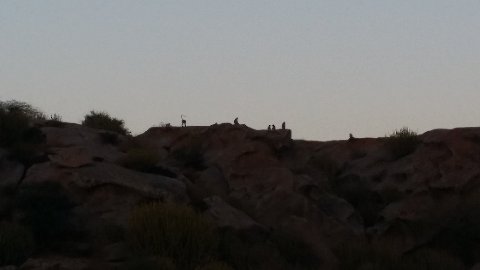
Above: Langurs on the ridge awaiting the sunrise. Jawai Leopard Camp. Sumerpur, Rajasthan, India. 11 December 2015.
Dawn image captured while waiting quietly in the Maruti for Nigel to make his appearance in the rocks below.
The guides and spotters know that Nigel went into a cave at this spot last night... and, that he will come out at dawn today. Ergo. There is a high likelihood we'll have a leopard sighting.
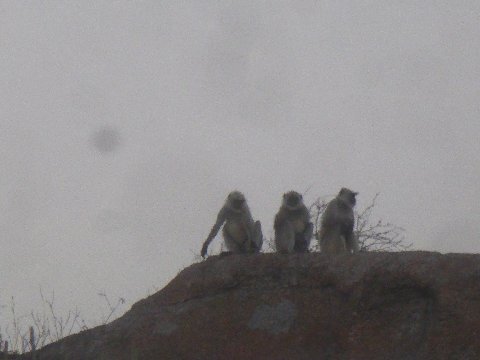
Above: 30x telephoto, with my dust filled Leica lens, of langurs on the ridge. Jawai Leopard Camp. Sumerpur, Rajasthan, India. 11 January 2016.
Hear no evil. See no evil. Do no evil.
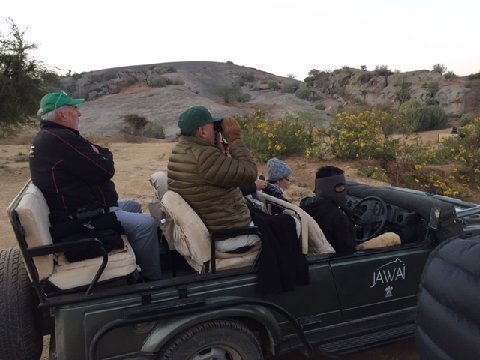
Above: Bishop, 1% and Heat, and naturalist guide JD wait in the Maruti for Nigel to appear. Jawai Leopard Camp, Sumerpur, Rajasthan, India. 11 January 2016.
Hat tip: Shock
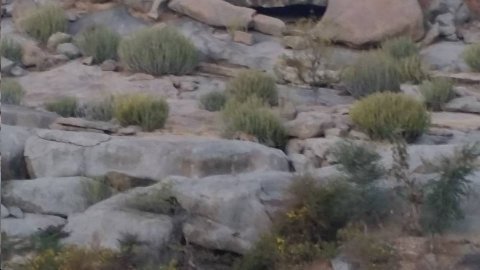
Above: Nigel. Leopard. Sumerpur. Jawai Leopard Camp. Rajasthan, India. 11 January 2016.
Not a great pic, but my pic! Sophisticated wild life camera, Samsung Galaxy Note 3.
Nigel is walking to the right on the downward slanted rock, just below image center. In front of green euphobia bush.
We are about 200 feet distant from Nigel. I had a very good look at him through the field glasses. Guides report that game watchers often get much closer to other leopards, but, that Nigel is a recent arrival to the area and still a bit skittish when near humans in Marutis.
I wanted to use my lumix and get a telephoto, but, I couldn't figure out how to disable the flash which automatically goes off in the dawn light. I never said I was a real wild life photographer... though after opportunities to get shots like this, I should look into getting a decent SLR and telephoto lens oriented towards wildlife shots.
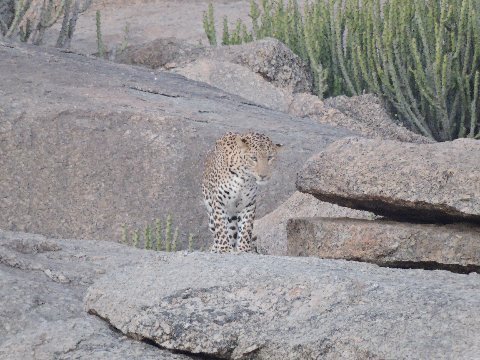
Above: Nigel. Samurpur, Jawai Leopard Camp, Rajasthan, India. 11 January 2015.
Hat tip: Image taker Maui, using telephoto, seated in the adjacent Maruti safari car.
Leopard sightings, all of Nigel, are four for four. Sightings on each of my four outings.
Nigel is nice... but, are there any other leopards around?
I think on tonight's safari outing I'll push for trying for another leopard... even if the location is not pin pointed and the odds of a sighting are reduced.
Addendum:
Very cool pictures of the kids skiing.
Mr. Z3,
Ojai, CA
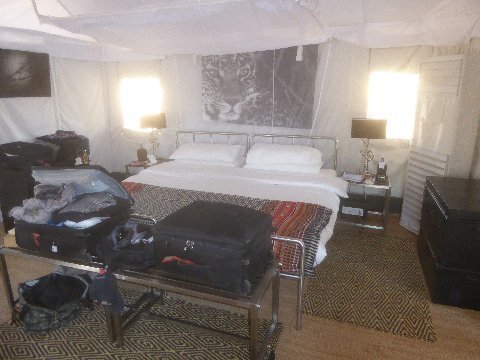
Above: Inside our tent. Jawai Leopard Camp. Sumerpur, Rajasthan, India. 11 January 2015.
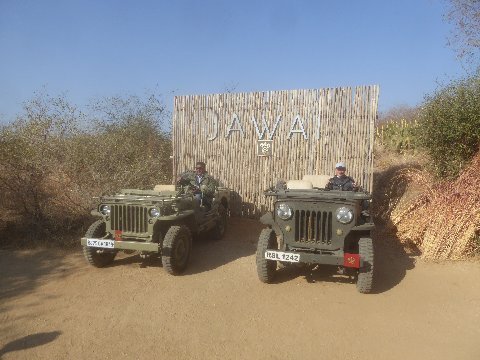
Above: Ajay and Montage at the wheel of vintage jeeps. Jawai Leopard Camp. Sumerpur, Rajasthan, India. 11 January 2015.
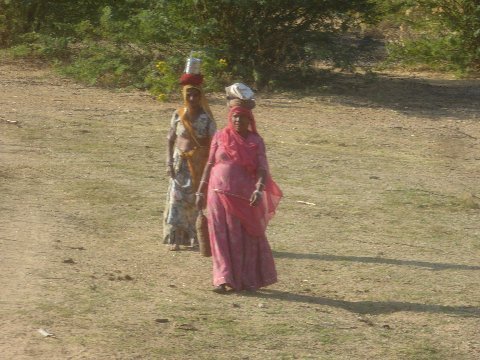
Above: Village People. Jawai Leopard Camp. Sumerpur, Rajasthan, India. 11 January 2015.
No hunched over women of a certain age with osteoporosis here?
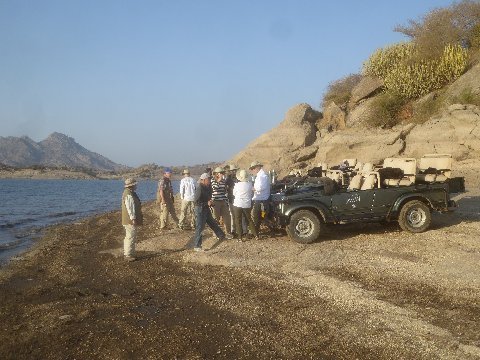
Above: Members of the Margaret Taylor Dance Troupe taking a tea break. Jawai Lake. Jawai Leopard Camp. Sumerpur, Rajasthan, India. 11 January 2015.
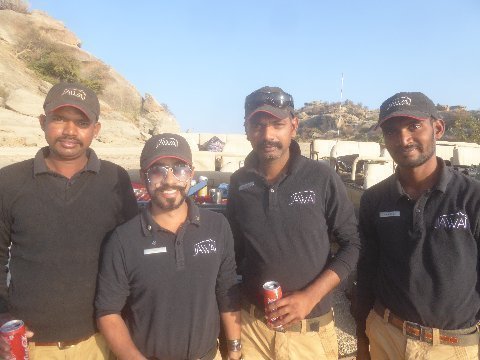
Above: Chigan, Varun, SB, JD. Jawai wildlife guides. Jawai Leopard Camp. Sumerpur, Rajasthan, India. 11 January 2015.
Varun is the supervisor of the guide service. He's a full time professional working for Jawai Leopard Camp. He comes out of the hospitality industry and was trained at Oberoi.
Chigan is a resourceful local discovered by Varun. Chagan is apprenticing to be a guide. He's already a great driver. These guys take the Marutis places only accessible by experienced four wheel drivers. I had more than a few sphincter moments while riding with the able Chigan at the wheel.
JD is a PhD student working on something having to do with crocodiles. His mentor is at the University of North Dakota. His job as a naturalist guide is part time. JD is the only Muslim of the group. He says he likes India and wants to stay here because of the compatibility amongst his Muslim and non-Muslim friends. "I celebrate Hindu and Christian holidays with my Hindu and Christian friends... and they respect my holiday, Ramadan," he says.
SB I didn't go with, so, I didn't get his story.
All of these guys were highly competent... knowledgeable. Rarely did we ask a question about leopards, birds, the geography or topography of the area without getting a satisfactory answer.

Above: People of burden? Sumerpur, Rajasthan, India. 11 January 2015.
Jawai is not just a leopard camp. It is a trip into village life that has been extant muc in the same way for 1000 generations.
Change is afoot. The kids have cell phones. They know what's going on in the outside world. Most are reluctant to adopt the patterns of their parents and ancestors. This "progress" can render some of them vulnerable. Uneducated and illiterate, they go to the city, find menial, low paying work, borrow money, and end up as defacto indentured servants with no future. The film "Slumdog Millionaire" captured this phenomenon.
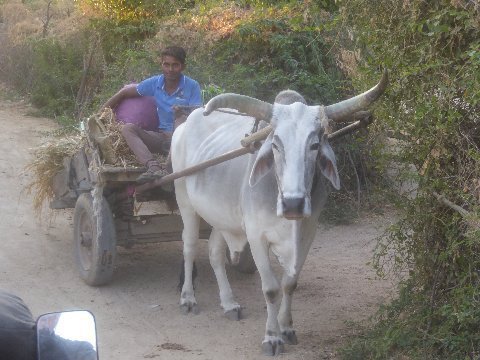
Above: Ox and cart. Jawai Leopard Camp. Sumerpur, Rajasthan, India. 11 January 2015.
"It depends on whose ox is being gored."
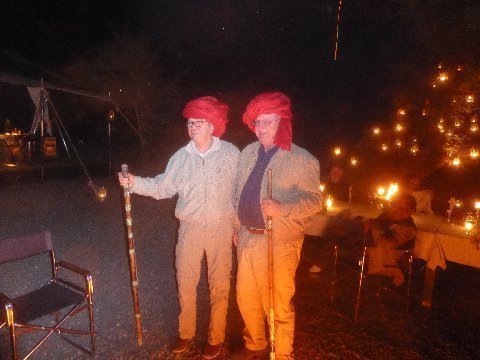
Above: 'Cake and Shock awarded turbines and cowherd staffs. Inducted as honorary citizens of Sumerpur, Rajasthan, India. 11 January 2016.
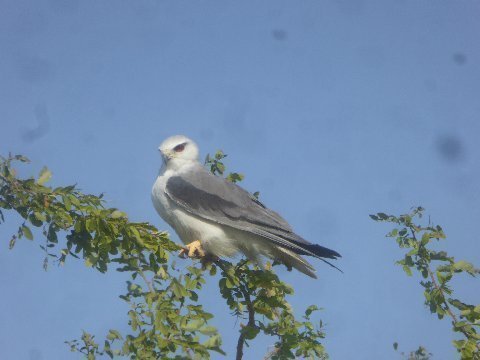
Above: Black-winged Kite. Jawai Leopard Camp. Sumerpur, Rajasthan, India. 11 January 2015.
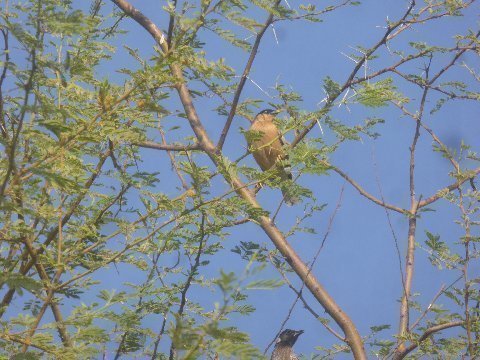
Above: Bhramani Starling. Jawai Leopard Camp. Sumerpur, Rajasthan, India. 11 January 2015.
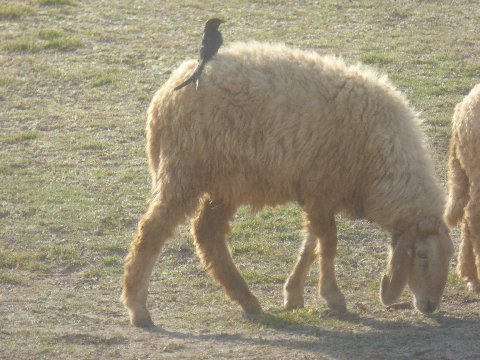
Above: Black Drongo. Jawai Leopard Camp. Sumerpur, Rajasthan, India. 11 January 2015.
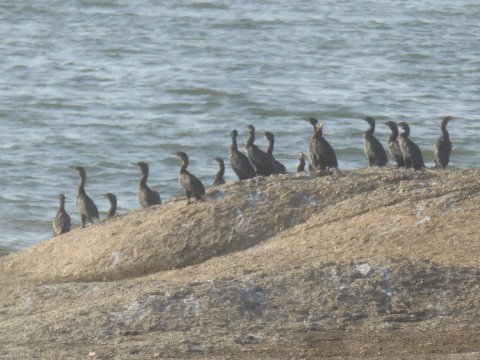
Above: Cormorants at Jawai Lake. Jawai Leopard Camp. Sumerpur, Rajasthan, India. 11 January 2015.
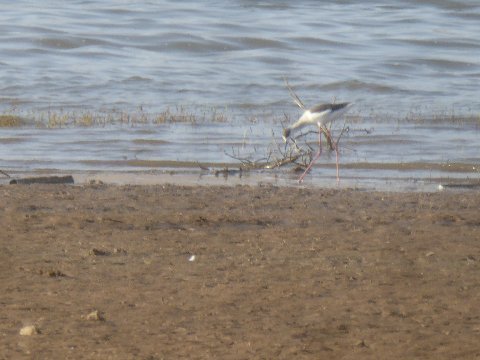
Above: Black winged Stilt. Jawai Lake. Jawai Leopard Camp. Sumerpur, Rajasthan, India. 11 January 2015.
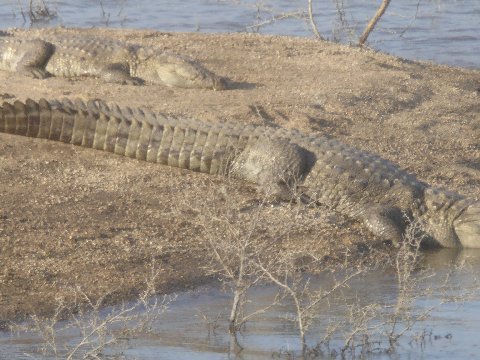
Above: Grandaddy Croc and averaged sized croc. Jawai Lake. Jawai Leopard Camp. Sumerpur, Rajasthan, India. 11 January 2015.
I didn't get the full image. When our Maruti rose on a granite outcrop close to the croc spot, grandpa was spooked and started for the water before I could get the whole image. I include the image of the truncated croc to show how large this animal was.
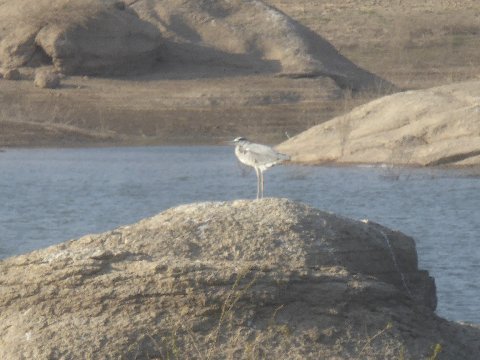
Above: Grey Heron. Jawai Lake. Jawai Leopard Camp. Sumerpur, Rajasthan, India. 11 January 2015.
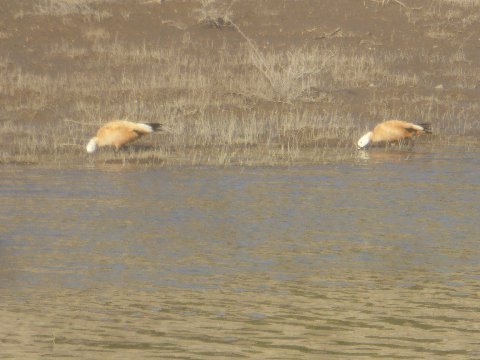
Above: Bhramani Ducks. Jawai Lake. Jawai Leopard Camp. Sumerpur, Rajasthan, India. 11 January 2015.

Above: Common Teal (left) and Red Wattled Lapwing. Jawai Lake. Jawai Leopard Camp. Sumerpur, Rajasthan, India. 11 January 2015.
A rare sighting. The only other time I've seen a Common Teal was three years ago in the stream near the North Forty field in Park City, UT.
Also, thanks to hyper spotter Varun, head of the naturalist guides, who was riding shotgun in our Maruti, driven by Chagan.

Above: Red Wattled Lapwing. Jawai Lake. Jawai Leopard Camp. Sumerpur, Rajasthan, India. 11 January 2015.
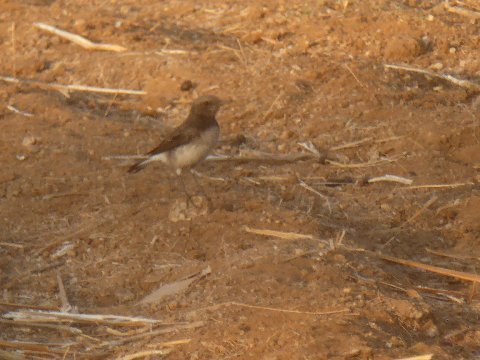
Above: Variable Wheater. Sumerpur, Rajasthan, India. 11 January 2016.
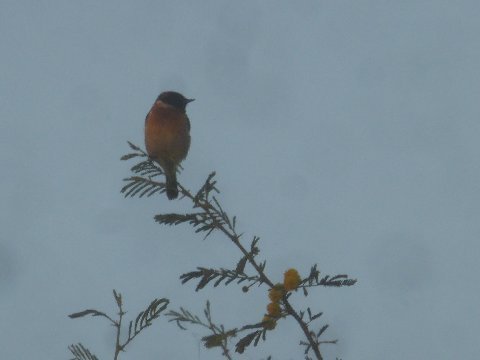
Above: Indian Robin. Sumerpur, Rajasthan, India. 11 January 2016.
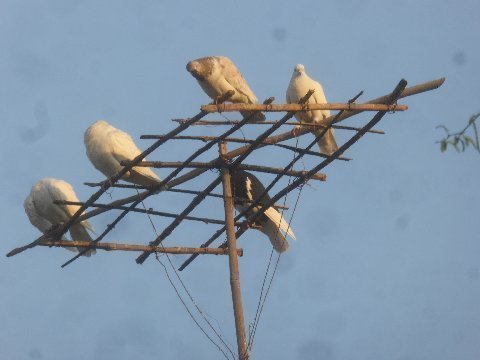
Above: White Pigeons. Sumerpur, Rajasthan, India. 11 January 2015.
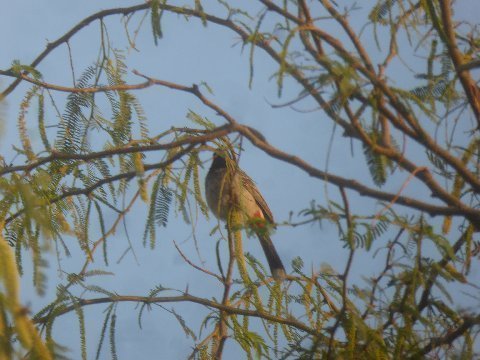
Above: Red Vented Bulbul. Sumerpur, Rajasthan, India. 11 January 2015.
Addendum:
Wow. Great pic!!
Bronx Girl,
Pelham, NY
Spectacular Leopard shot by Maui
mib
Hope you are keeping a life list?
Nathans,
Massapeaqua, NY
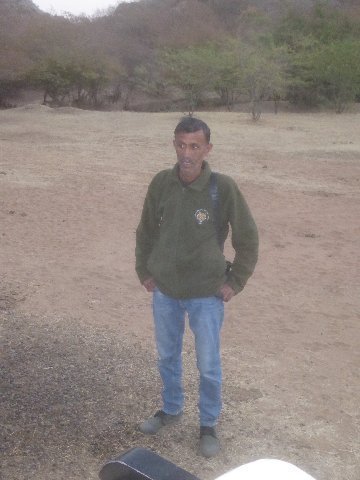
Above: Tracker
"Turn around, Steve," said Varun. "Look at the sunset!"
Varun knew where to stop. The sun set bordered by the granite outcrop on the left, as we looked back, and the billion year old Aravali mountains and Jawai Lake on the right. Could there be a more perfect sunset image than this special place in the Rajasthani desert?
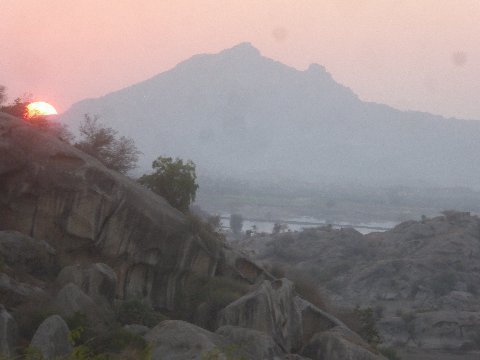
Above: Sunset, Rajasthani desert.
In the waning light, Chagan nudged the Maruti safari vehicle forward, through the valley, along the side of the side of the granite domes on the right. Looking left we could see farmland... wheat and canola. TIMDT and Mwah (sic) marveled at how the leopards and mankind could share the same area. There are 6000 leopards in India, plus or minus, and unlike tigers, which are restricted to certain preserve habitats, leopards range the entire sub continent.

Above: Farmland adjacent to granite outcrops.
We arrived adjacent to the final granite dome in a somber dusk. Time to see Nagani was running out. Chagan parked the Maruti on a granite platform and we waited quietly for a final look.

Above: Four granite outcrops and wildlife guides, Varun and Chagan, in Maruti. Looking towards the fourth granite outcrop in the distance.
"Monkey's," I whispered. "There (I pointed up)... leumurs... running up to the summit!" There were a lot of them. And, they were screaming. Their cries reverberated against the massive stone outcrop, back to our "jeep." They must have been spooked by something.
"There!" whispered Varun. "A wild boar!" A very large, dark, boar snorted and made its way through the bushes one hundred feet ahead... now stopping to hide behind a tree... now, snorting and moving. "There!" whispered Varun, again... but, pointing, this time, to the boar's left. Discernable in the growing dusk was leopard Nagani... stalking the boar. Slowly, deliberately, one front paw forward... stop.... the other front paw forward... stop. Slinking... prowling... preying.
Could this be true? At the end of a leopard safari hunt we were seeing the leopard sighting of a lifetime? A leopard stalking its prey?
Nagani stopped. The lemurs were still screaming... no longer discernable up on the granite outcrop above in the growing dark. The boar, spooked by something, trotted up the hill a bit.. and stopped again. But Nagani didn't follow. She apparently gave up the hunt and began walking from our left to our right, through an open area, into the brush on a rise to our right.
Chagan repositioned the Maruti in the direction of where Nagani was last seen and both Varun and Chagan began searching the now dark area with high powered, hand held lights.
There! No one needed say a thing. There! Fifty feet away. Nagani, head and shoulders fully visible, lying down, facing the light, licking her paws. Occasionally she would turn her head left, then right, and her eyes would flash like a disembodied wraith's orbs in a haunted house.
Chagan eased the Maruti closer... using gravity to advance the vehicle down the slight incline where we were positioned. Now 35 feet away!
For 20 minutes we watched as Nagani alternately licked her paws, looked left, looked right, looked straight, stood up. walked left... lay down again. In the process I took an image with my highly sophisticated wild life camera... the Samsung Galaxy Note III.
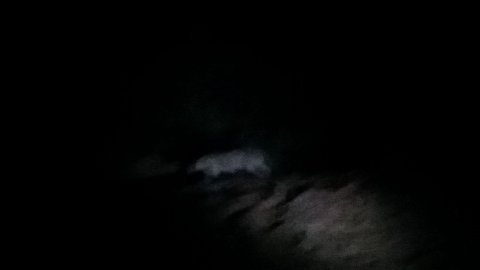
Above: Negani!
Finally, Nagani stood and walked back to a position out of our sight and we, elated on our leopard sighting high, returned to the camp.
"Why didn't Nagani take the boar,?" I asked Varun. "She was licking her paws which signified that she had recently eaten. Instinct caused her to stalk the boar... but, when push came to shove she decided that taking on the boar, a doable but difficult effort for a leopard, could wait for another day."
Serendipity strikes again. Once again rewarded for taking the alternate path.
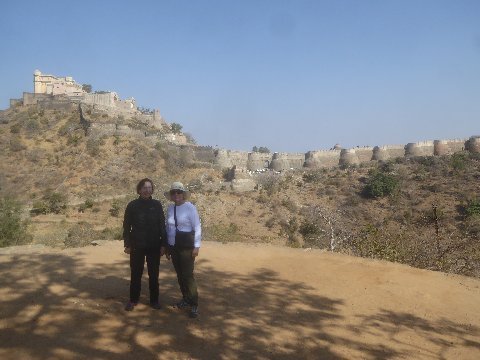
Above: Comic Mom and TIMDT pose at Kumbhalgarh Fort. Kumbhalgarh, Rajasthan, India. 12 January 2016.
The fort was constructed almost 2000 years ago and was dormant for 1500 years. It was rebuilt during the 15th century and enlarged through the 19th century. It is the birthplace of Maharana Pratap, the great king and warrior of Mewar.
Pratap Singh, (1540 to 1597) was the ruler of Mewar, a region in present day Rajasthan. he is widely regarded as a fearless warrior and ingenious strategist, who successfully fought the Mughals and safeguarded his people. In Indian popular culture, he is hailed as an inspirational figure for exemplifying gallantry and resourcefulness.
Kumbhalgarh separated Mewar and Marwar from each other and was used as a place of refuge for the rulers of Mewar at times of danger. The fort remained impregnable to direct assault and fell only once, due to a shortage of drinking water, to the combined forces of Mughal Emperor Akbar, Raja Man Singh of Amber, Raja Udai Singh of Marwar, and Mirzas in Gujarat. Even then, the fort was only occupied for two days, before being recaptured by the Merwaris.
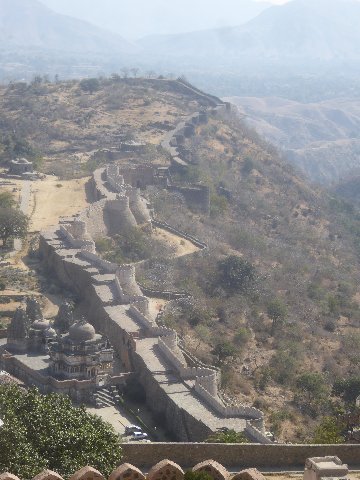
Above: The walls of the fort of Kumbhalgarh. Kumbhalgarh, Rajasthan, India. 12 January 2016.
Image captured from atop Kumbhalgarh fort. Our bus could not make it through a gate about 2km from the fort. Some of us decided to walk the distance. A safari car was hired to take the others. Between the walk to the fort and climbing to the top of the fort I estimate that we covered about 500 vertical feet. I was glad for the exercise.
The walls extend over 38 km, claimed to be the second-longest continuous wall after The Great Wall of China.
"The Great Wall of India?"
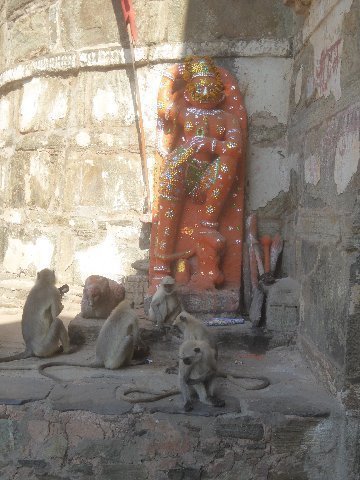
Above: Lemurs scrounge from offerings at Hanuman idol. End of mountain road. Kumbhalgarh, Rajasthan, India. 12 January 2016.
Hunuman is a Hindu god and an ardent devotee of the god Rama. He is a central character in the Hindu epic Ramayana. A monkey, Hunuman participated in Rama's war against the demon king Ravana.
In an ancient Hindu text, Rama describes Hunuman's qualities:
Ablest sentence maker
Knower of all Vedas and scriptures.
Scholar in nine schools of grammars.
Possessing faultless speech and facial features.
Hanuman is worshipped by villagers as a boundary guardian, by Shiva ascetics as a Yogi, and by wrestlers for his strength. There are numerous temples for Hanuman, and his images are usually installed at all temples where images of avatars of Vishnu are installed. Hanuman temples are believed to keep the area and surroundings free of demons.
Hunuman idols are found on mountain roads (as pictured above) because it is believed that he protects people from accidents.
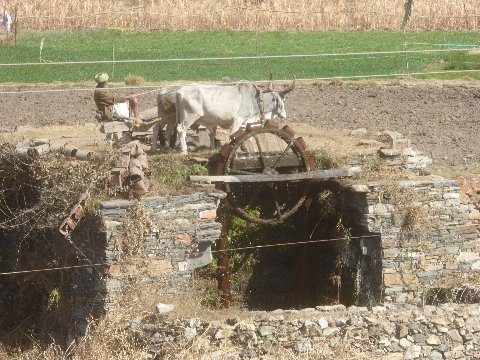
Above: "Persian Wheel." Road from Kumbhalgarh to Udaipur. Rajasthan, India. 12 January 2016.
The Persian Wheel, operated by draught animals, is used to lift water from open wells.
The "Persian Well" was probably invented in ancient India. But, with its use also in Iran (Persia) it came to be called the Persian wheel. The device is mentioned in Indian texts that go back as far as third century BCE.
Seeing a device used 1800 years ago and still used in common practice today is sobering... one more example of the contrast of extremes that is India today... another example of India's constant assault on the senses... one of the reasons why India, as a travel destination, is so compelling, and worth returning to year after year.
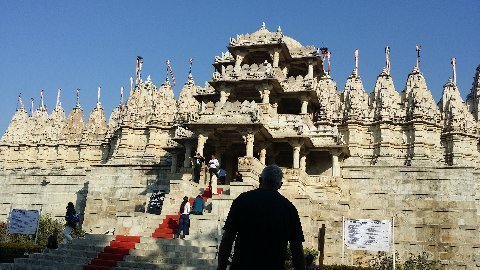
Above: Bishop surveys Chaumukha Mandir. Ranakpur, Rajasthan, India. 12 January 2016.
All marble Jain temple built in the 15th century. 1444 individually engraved pillars. One of the most important centers of Jainism in India.
Jainism is one of four religions birthed in India. 0.6% of the Indian population is Jain... 6 or 7 million.
Jainism came about in the 6th century BC, about the time of Buddah. Buddism is also a religion founded in India. There is no founder, per se, of Jainism. Guru Rishabha was the first of 24 revered gurus... but the religion only took hold as a result of the teachings of all 24 gurus (called Tritankaras).
Jainism prescribes a path of non-injury towards all living beings. Practitioners believe non-violence and self-control are the means to liberation. Jains must observe five major vows: not lying, not stealing, chastity, truth telling, and non attachment.
Self discipline and asceticism ar major focuses of Jainism. "The function of souls is to help one another," is the motto of Jainism.
Jainism rejects the idea of a creator or destroyer god and postulates an eternal universe.
A disproportionate number of top business figures in India and abroad are Jains.
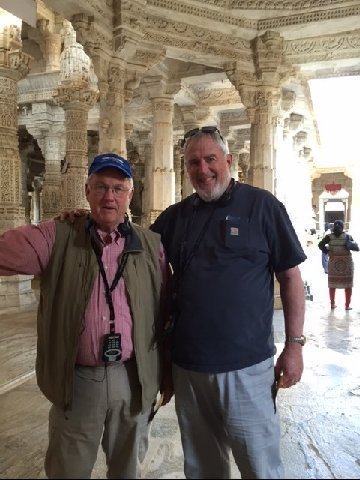
Above: Shock and Awe... er, Bishop. Chaumukha Mandir. Ranakpur, Rajasthan, India. 12 January 2016.
Note behind us a few of the individually carved 1444 marble pillars.
When you think you've seen everything in India, something new, like this temple of staggering, complex workmanship pops up.
We visited a Jain temple in Calcutta a year ago, and another, in Chandni Chowk, a couple of weeks ago.
Addendum:
The pictures taken by Mom reminding me when Max was first on the slopes it was a great event; in fact I still look at the photos and smile deleted all are enjoying as much as I did -Max is a freshman at the University of Arizona time flies 😇
Mr. Z3,
Ojai, Ca
beautiful wild life thanks for sharing
LaDoc and LaPsy,
Los Angeles, CA
Steve,
You must have some powerful ju-ju to make a leopard pose for you. Remember our trip in southeastern Africa in Kreuger National Park when our lead South African guide, Rikis (sp?) declined to join us on our game viewing expedition and, with YOUR presence, we saw a leopard lying on a tree branch posing for us? Rikis couldn’t believe it- he said that he had seen all of the African “Big Five” except a leopard, even though he had been out there 15 times.
Gotta’ be your charm. Thanks for the shots,
Ahn Rhee, Larkspur, CA
Congrats....reads like a novel.
Bronx Girl, Pelham, NY
Thanks Steve! A truly exciting read!
Manhattan, Park City, UT
So impressive! Your decision, Nagani, and your reporting. Thanks
Espresso, Washington, D.C.
great shots Steve love the Robin composition.
Brand, Venice, CA
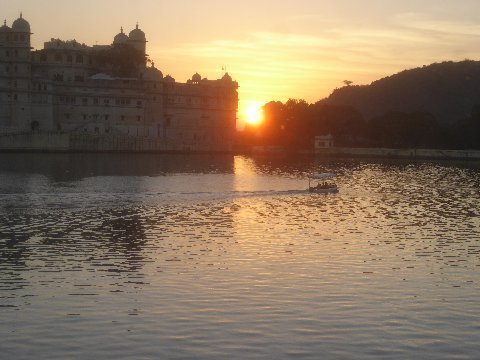
Above: Sunrise over City Palace. Udaipur, Rajasthan, India. 13 January 2016.
Image taken from our hotel room. Lake Palace Hotel.
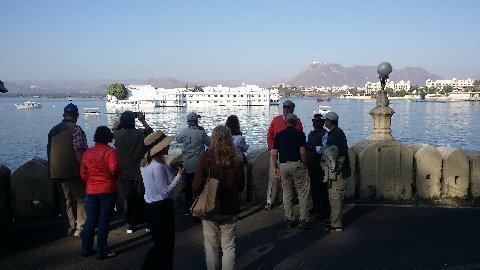
Above: Margaret Taylor Dance Group observes Lake Palace Hotel. Udaipur, Rajasthan, India. 13 January 2016.
Image taken from City Palace.
Summer residence of Maharana of Jaipur.
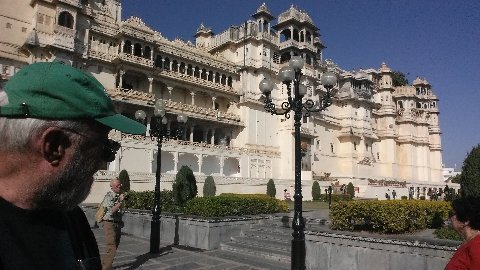
Above: Bishop observes City Palace. Udaipur, Rajasthan, India. 13 January 2016.
The palace has been built over a period of 400 years with construction starting in 1559 by Maharana Udai Singh II. Udaipur was the historic capital of the former kingdom of Mewar in the Rajputna Agency. The palace is the largest royal palace in Rajasthan... it is replete with history.
Rajput kingdoms... there were some 29 of them... retained their independence through the Mughal periods and the British periods... though, to do so, they had to intermarry with the Mughals and make various cooperative agreements with the British.
At the time of Indian independence, 1947, the new government had to persuade the kingdom rulers (maharajas and maharanas) to join the new union. In return for giving up their titles and most of their property, they were offered a "privy purse." They would be able to keep their status amongst the people and would be given a guaranteed income to retain their lifestyle.
All Rajput kingdoms eventually went along with the deal... especially those whose fortunes improved... not all kingdoms were in good financial shape at the time of independence.
The privy purse was halted by Indira Gandhi, via constitutional amendment, in 1971. Some savvy ex rulers had anticipated losing their government benefit and had converted their remaining holdings into foundations which would be exempt from government sequester. Some of the properties were converted into hotels.
In many of the former kingdoms, the ruler tradition continues, albeit with the maharaja having no political power. The Rajput people have a strong sense of tradition and many of them revere their royal families.... not unlike the queen's role in the UK today.
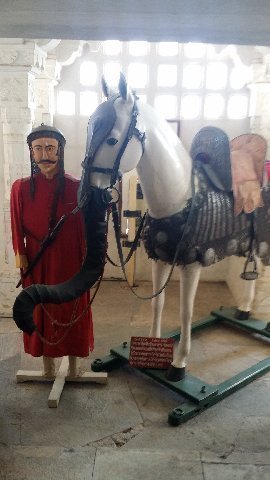
Above: Soldier and horse representation at City Palace Museum. City Palace, Udaipur, Rajesthan, India. 13 January 2015.
Rajput army leaders put dummy elephant trunks on horses. In battle, the elephants would not attack what they perceived to be other elephants.
Rajput kingdoms fought mainly against one another. As a group, they were never defeated militarily by outside powers, including the Mughals and British.
Rajput army units were seconded by the Maharajas to the British war efforts in WWI and WWII. The units fought with distinction.
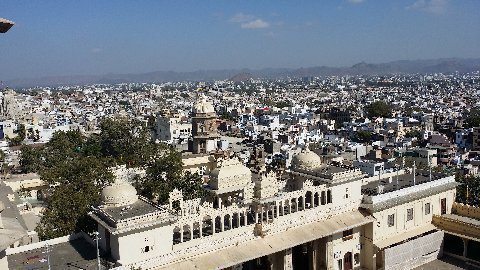
Above: Udaipur, Rajasthan, India. 13 January 2016.
Image captured from City Palace.
3.3MM population. 62% literacy rate.
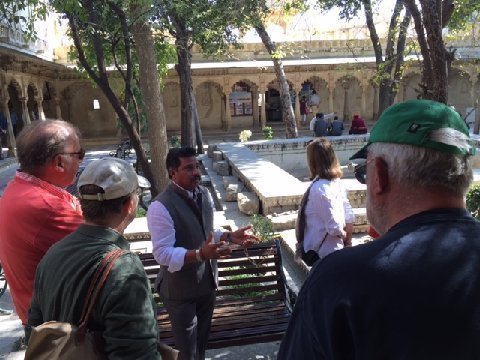
Above: Ajay our adept escort/guide, explains to members of the Margaret Taylor Dance Troupe the significance of an inner courtyard at City Palace. Udaipur, Rajesthan, India.
Image hat tip: Shock
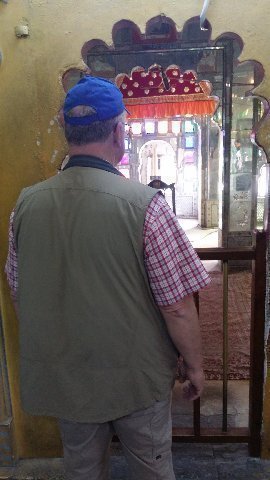
Above: Shock. City Palace. Udaipur, Rajasthan, India. 13 January 2016.
Ghost of Ani
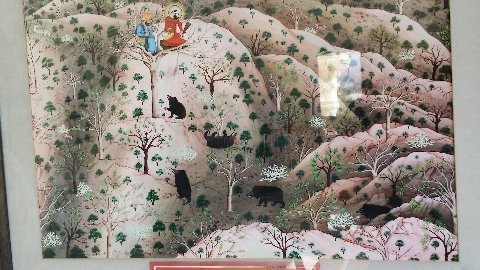
Above: Maharana Fateh Singh-ji shoots a bear. Painting. City Palace. Udaipur, 13 January 2016.
1916 painting shows five bears but it is one bear... shown in each of five positions as the Maharana shot it in a hunting expedition.
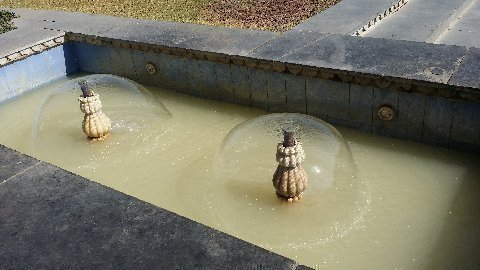
Above: Fountain, City Palace. Udaipur, Rajasthan, India. 13 January 2016.
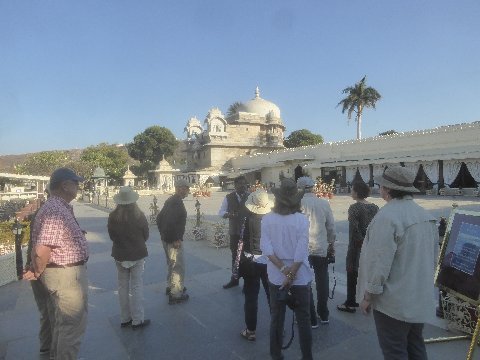
Above: Margaret Taylor Dance Group at Jagmandir Palace. Udaipur, Rajasthan, India. 13 January 2016.
Shah Jahan, Mughal emperor and builder of the Taj Mahal, lived with his wife Mumtaz for seven years in the domed palace section seen in image center. Unhappy with Shah Jehan's selection of Mumtaz to be his wife, Shah Jehan's father, Jehangir, Mughal emperor, said, "if you want to stay with me here at the Agra Red Fort, you have to give up Mumtaz. If you want to stay married to Mumtaz, leave." Shah Jahan, ever devoted to Mumtaz, left Agra in exile.
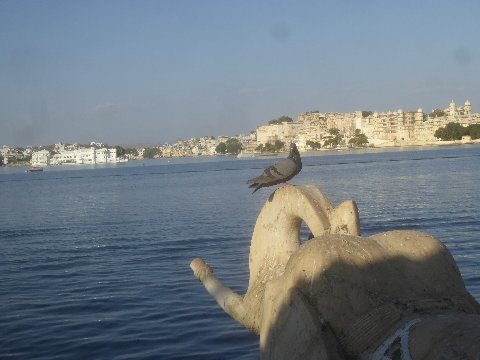
Above: Lake Palace and City Palace. Udaipur, Rajasthan, India. 13 January 2016.
Image captured from Jagmandir Palace.
This spectacular setting has been called "The Venice of India." Udaipur has been frequently ranked at the top of various lists as the worlds top tourist destination.
Udaipur's Lake Palace, City Palace, and Monsoon Palace were all used as settings for the James Bond film, "Octopussy."

Above: Oberoi Udaivilas Hotel. Udaipur, Rajasthan, India. 13 January 2016.
Number One rated hotel in the world. 2015. Conde Nast.
TIMDT has stayed at the Oberoi before.
A stay this time at the Oberoi would have been nice, but, I wanted to stay at Lake Palace Hotel on this trip because of its long and storied history
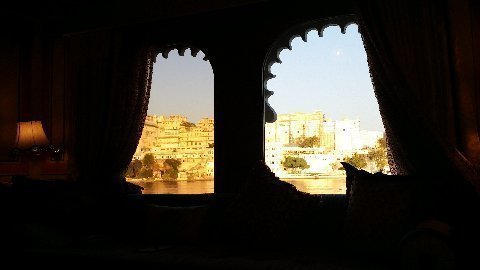
Above: City Palace. Udaipur, Rajasthan, India. 13 January 2016.
Image captured from our hotel room at Lake Palace Hotel.
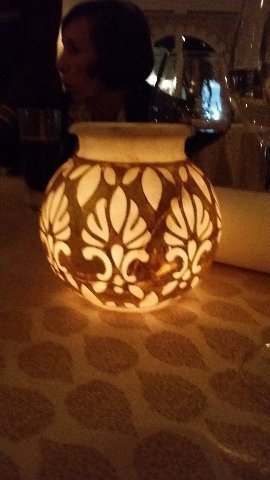
Above: Marble candle holder. Dinner. Lake Palace Hotel. Udaipur, Rajasthan, India. 13 January 2016.
Addendum:
Thank you for sharing this great trip to India with me. Imagine my surprise to learn about Jainism. Here here for the Jains something for us atheist to believe in.
The Plumber,
San Angelo, TX
Steve
Thanks for sharing your beautifull trip!
Say hello to Margareth
Regards from Brazil !
Claudia,
Sao Paulo, Brazil
Those don’t look like lemurs to me. I would judge them to be a species of monkey. It makes sense since Hanuman is the “Monkey God.”(Did you really live in India or are you making that up too?)
Jack Aroon, Mahwah, NJ
Right. Langurs. Tks. Also saw rarer capped langurs while in Kaziranga a couple of weeks ago.
My first cousin, Dr. Benjamin Z. Freed, is a Professor of Anthropology at Eastern Kentucky State University, in Lexington, KY.His doctoral dissertation involved a three-year sojourn in Madagascar, studying lemurs. Lemurs are not monkeys – langurs are.
Jack Aroon, Mahwah, NJ
Saw lemurs during visit to Madagascar in 1998. Thanks for straightening me out.
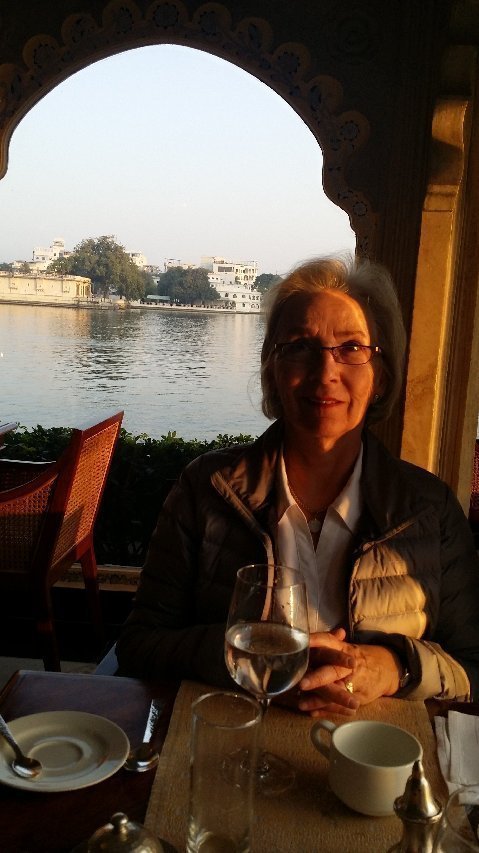
Above: TIMDT at breakfast. Lake Palace Hotel. Udaipur, India. 14 January 2016.
Maharani.
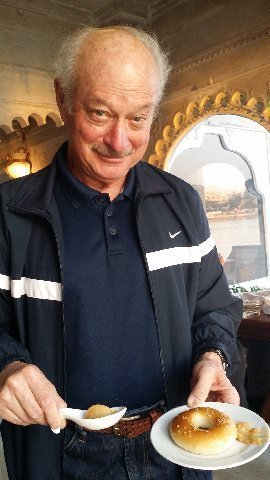
Above: Montage. Lake Palace Hotel bagel. Udaipur, India. 14 January 2016.
Kreg Van Strehlen, Wasatch Bagel owner. Eat your heart out. LSDM move to Udaipur? Bagels not up to snuff, but, better coffee at Lake Palace.

Above: 1% and Bishop. Lake Palace Hotel. Udaipur, Rajasthan, India. 14 January 2016.
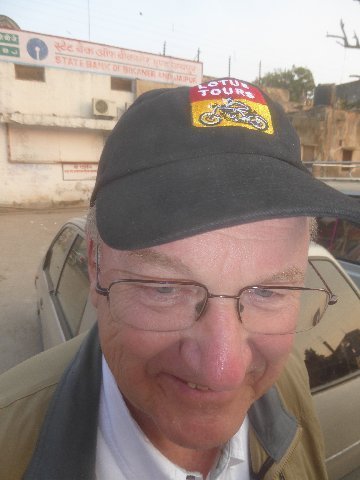
Above: Shock channels a bygone, glorious era. Shahpura, Rajasthan, India. 14 January 2016.
Lotus Tours.
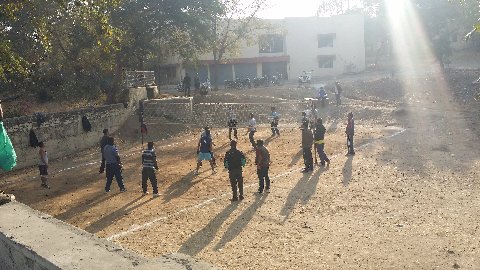
Above: Pick up volleyball. Udaipur, Rajasthan, India. 14 January 2016.
Addendum:
Ah, I have similar glowing memories of staying on the shore of Lake Udaipur in 1997 with Patrick Moffat and Clement Salvadori. Touring Rajasthan on Indian Enfield 500 Bullets with all the friendly people in ever floating colorful saris amid camels, elephants, water buffalo and hundreds of sacred cows! It was a magical place in a magical era only two decades ago! Thanks for the brilliant memories!
Isetta, Chicago, IL
These photos pull at me. I would have loved to see Udaipur and stay at the Lake Palace.
Bronx Girl, Pelham, NY
Those kingfishers are very well and diversely attired.
Bronx Girl, Pelham, NY
We arrived at Shahpura Bagh, coming from Udaipur by road, around 2:00 PM.
Shahpura Bagh is a beautiful heritage property located in rural Rajasthan between Jaipur and Udaipur. It is a garden estate surrounded by lakes and comprises two residences with light and airy suites and rooms.
The hotel is run by descendants of the former Raja... ruler of Shahpura Bagh. At time of Indian independence, the ruler of Shahpura was one of the first independent entities to sign up for the government plan and privy purse.
After lunch at the estate/hotel, we walked through the nearby "non-touristy" town of Shahpura. Also, I noted lottsa (sic) birds... including my first sighting of a pied Kingfisher.
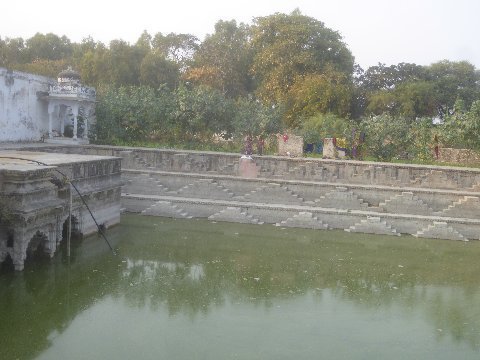
Above: Stepwell. Shahpura, Rajasthan, India. 14 January 2016.
Common in western India, stepwells are ponds in which water may be reached by descending a set of steps.
In the dry Indian west desert the level of the water table fluctuated from month to month... hence, the construction allowing descent to the water, whatever its level.
Many stepwells in India have architectural significance. Some have a bullock powered water wheel to raise the water to ground level.
Notwithstanding all my time in India to date, this is the first time I have seen a stepwell.
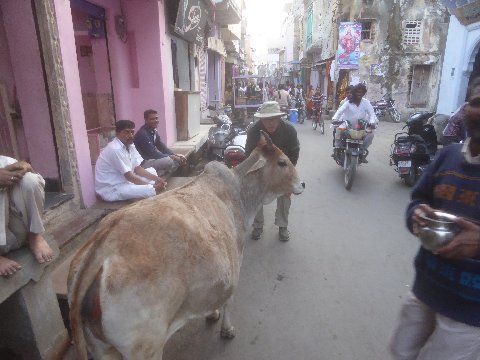
Above: 'Cake and cow. Shahpura, Rajasthan, India. 14 January 2016.
I overheard 'Cake saying to the cow, "you talkin' to me??? you talkin' to me?"
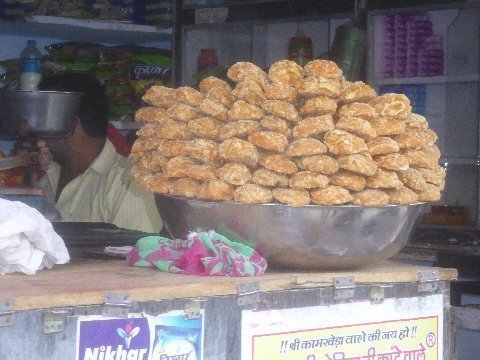
Above: Molasses. Shahpura, Rajasthan, India. 14 January 2016.
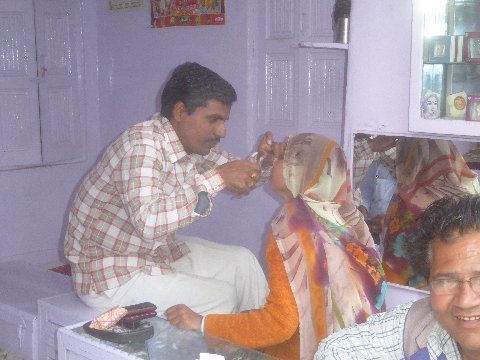
Above: Installation of gold nose ring. Shahpura, Rajasthan, India. 14 January 2016.
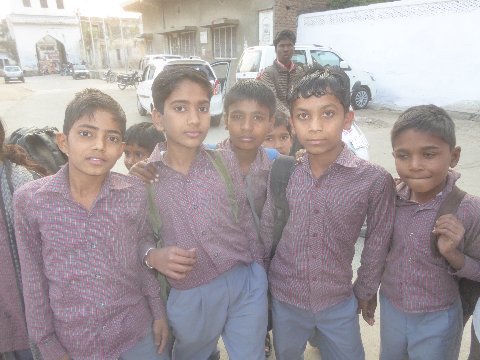
Above: School boys. Shahpura, Rajasthan, India. 14 January 2016.
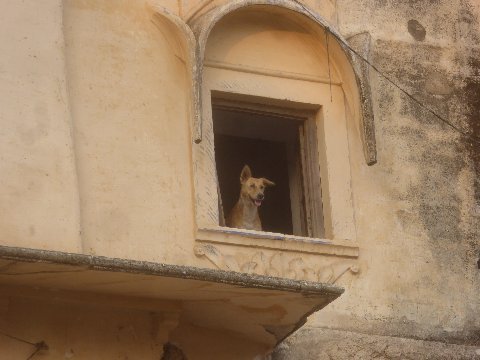
Above: Shahpura Palace. Shahpura, Rajasthan, India. 14 January 2016.
How much is that doggie in the window?
The ruling family lived in this fort until around the turn of the 20th century whereupon they moved to their new residence, now our hotel, at Shahpura Bagh.
The fort was ceded to the government at time of independence. It has been poorly maintained since, though there is a school and government offices inside. The private school is run by a foundation established by descendants of the former ruling family and owners of Shahpura Bagh.
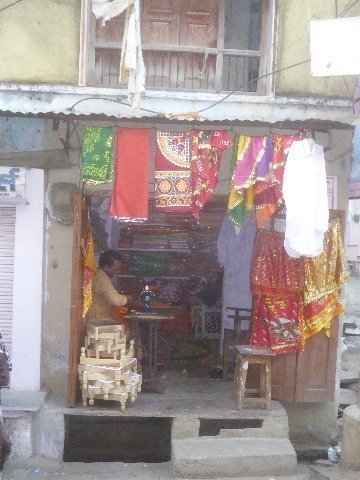
Above: Mr. Guzman, a Muslim, sews Hindu temple flags and Hindu wedding ceremony decorations. Shahpura, India, Rajasthan. 14 January 2016.
Here is an image that illustrates the multicultural successes of India.... a Muslim earning a living producing articles for Hindu worship and celebration.
One member of the Margaret Taylor Dance Troupe wondered why the United States could not emulate India in this regard... say, a Christian bakery baking a wedding cake for a gay couple.
Yet, if it is anything, India is a land of contradictions. Despite seeming cooperative communal relations in India at the village and community level, there are fault lines of communal antagonism at the national level. The BJP has many members who support a Hindu nationalist platform - India for Hindus. Prime Minister Modi, known first for his progressive attitudes towards building the Indian economy, often remains silent when some, not all, fellow BHP party members, Hindu nationalists, agitate. Some Indians I know are worried that the rise of the BJP political party may lead to exacerbated communal tension.

Above: Gulab Jamun. Shahpura, Rajasthan, India. 14 January 2016.
Gulab jamun is a milk-solids-based dessert popular in India and other south Asian countries. It is made from milk solids, traditionally from feshly curdled milk.
Milk solids are prepared by heating milk over a low flame for a long time until most of the water content has evaporated.
These milk solids are kneaded into a dough, sometimes with a pinch of flour, and then shaped into small balls and deep-fried at a low temperature. The balls are then soaked in a light sugary syrup flavored with green cardamom, rose water and saffron.
This is my favorite Indian desert. When Drums was only two, he hand his Mom and Dad joined TIMDT and Mwah (sic) at Salt Lake City's Bombay Palace for dinner. He tried gulab jamun and really liked it. The next time he joined us for dinner at Bombay Palace, the Sikh waiter asked if we would like any desert. Drums, sans prompting, said, "gulab jamun!" The nonplussed waiter couldn't believe his ears.
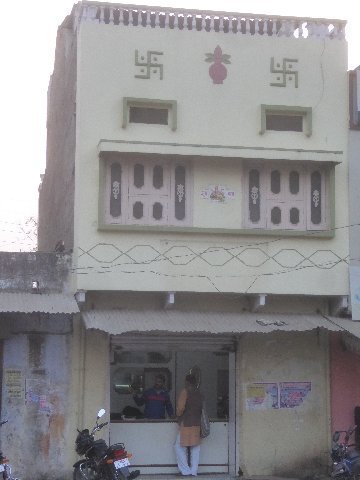
Above: Building with swastikas. Shahpura, Rajesthan, India. 14 January 2016.
The swastika is symbolic of the four steps in Hindu belief. Birth, life, death, and reincarnation. The cyclical process repeats again and again for all beings. Karma.. or one,s actions during the "life phase", good or bad, determines how a being will be reincarnated. Bad deeds (bad karma) might lead to return as an animal. Good deeds (good karma) may lead to a return to a higher station or caste. The cycle repeats itself millions of times until Nirvana, or liberation from the cycle of rebirth, and return to the creator, is reached.
Unlike most religions, Hinduism is not a "revealed" religion. There is no founder. It has been made alive by people living their daily lives over the centuries. There are texts that have been accepted to provide a framework for the religion as it has evolved: the Vedas, the Epics including Bhaghavad Gita etc.
Despite the myriad of Hindu gods and goddesses, Hinduism is claimed by some to be mono-theistic. There is but one ultimate creator of the universe... a divine feminine creative essence... not a tangible being - Shakti. Hindus believe that Shakti is both responsible for creation and the agent of all change. Shakti is "cosmic existence" and "liberation." In Hinduism, Shakti is a mysterious spiritual force.
According to Ajay, our Rajput escort/guide, early practitioners of Hinduism wanted symbols to attach to their religion. Christianity has a cross. Islam, a crescent. Buddahism an idol of Buddah himself... and so on.
That "symbol" was "Om" - O Ah MMM. The voiced "OM," from deep within the diaphragm to exit seconds later from the mouth, symbolized the creation. The three sounds of OM took on the form of three tangible Gods: Brahama the creator, Vishnu the protector, and Shiva, the destroyer, representing the cycle of life also represented by the swastika.
Other gods, and different incarnations of principally Vishnu (Rama, Krishna) were conceived to represent different aspects of daily life. Appeals to Haunuman, the monkey god, for example, can result in safe travels during a journey.
There are three paths to Nirvana, according to Ajay. Education, Karma (good deeds) and devotion (worship). Education is important because a knowledgeable man will not do wrong. A knowledgeable man will be good - have good karma.. he will worship... and his reincarnation process will lead, ultimately, to nirvana... being at one with the creator.
One can begin to see how Hinduism plays out in the lives of the people.
The presence of education is manifest throughout India today. You cannot pass through a town or city without seeing evidence of schools, school children, signs advertising this or that educational opportunity... computer programming appears a lot on street side bill boards.
Educating the Indian population is a daunting task. On the one hand, some 500 million Indians remain illiterate and outside of the education process. Yet, over three hundred million Indians can be classified as middle class... defined as the ability to spend $10 to $100 a day.
This dichotomy of illiteracy co-existing with thirst for education is, again, another of India's many contradictions.
There are 800 million cell phone owners in India... the potential for exponential increase of information dissemination and education coming through these devices is staggering. One senses that via this young, education obsessed, cell phone owning population, India is on the cusp of a growth spurt that will increase the standard of living and quality of life for millions... on a scale never before seen in history.
Another area where Hinduism may impact: Indians seem to be happy no matter what their current station in life.
I'll never forget the nearly naked kid in Calcutta I saw over 40 years ago. He was sitting under a manually operated water pump in a public area, pumping water over his head and body... purloining a shower from the pump. He had a small aluminum dish by his side, likely his only possession other than the rag partially covering his body. I was in the back seat of my car.. I had a driver... and looked at the kid as we slowly drove by. He looked at me and broke into the widest grin showing a perfect set of pearly white teeth.
Here was a kid with nothing, I thought, and yet he exhibits what seemed like a consummate happiness. Why is he not resentful? Why does he not project that he is miserable? He has nothing. I think, though he wouldn't express it this way, that his ingrained sense that life is a repetitive cycle... that good deeds (karma) in this life will lead to a better station in a new life, helps moderate his expectations in this life. And so it goes for the rest of the society?
Does Hinduism seems to lead to acceptance... to a form of passiveness or non-aggressiveness? Though India has a strong armed force, she has never, unlike say China, tried to flex her influence internationally, or around her borders, as other great powers are wont to do. America has the Monroe Doctrine. America has a military presence throughout the world. China tries to define a sphere of influence beyond its coastline sparring with the Philippines for a disputed, otherwise inconsequential, island chain. Does Hinduism infuse the Indian state with a passive-ism or acceptance of life as it is that militates against projecting a great power status?
Pearl Buck, in her great novel, "Come My Beloved," captured the essence of the Indian spirit, for which I have used very awkward, if not inappropriate, terms such as acceptance or passiveness:
David went into the house, touched, as he so often was, by the warmth and humanity of an Indian. There was no distance to overcome, the least kindness overwhelmed these people, the most habitual gentleness was enough to win their adoration. they were ready to love Yet they were not childish. It was simply that they had lived so long and in such misery that their hearts were worn bare and their nerves quivered.
Come my Beloved, Pearl Buck
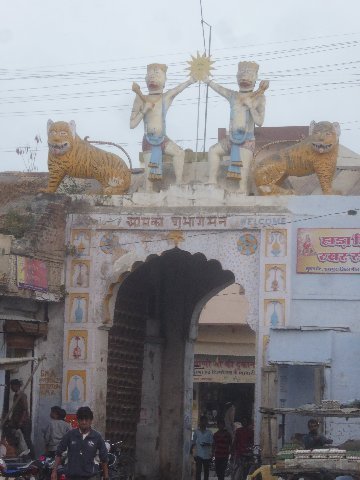
Above: Entry gate to Shahpura downtown. Shahpura, Rajasthan, India. 14 January 2016.
Gate shows crest of ruling family of Shahpura, former rulers of Shahpura, and current owners of Shahpura Bagh, our country estate hotel.
Addendum:
Enjoying the trip to India through your emails. Miss not being with you all, but could not have missed the big shoot out in Phoenix Monday night. The Tide is not dead as some had said earlier in the season, had the stronger will to win Monday night.
Our best to all,
Mezzanine, Miami, FL
Roll Tide.
Steve Margaret is just as gorgeous now as she was when we first met her years ago
Hamilton & Cally, Sydney, Australia
THE ONE PLACE I WANTED TO GO TO AND NEVER GOT THERE IS THE LAKE PALACE. It looks great. Enjoy
Bridge,
Palm Beach, FL
Ahhhhh. TIMDT is looking fine this morning.
Steel,
Pensacola, FL
Thanks for your continued sharing of your travels in India with the now famous MTDT. Fascinating stuff, Steve.
Steel,
Pensacola, FL

Above: Roy, right, with buddies at Primary. 14 January 2016.
Image by Portland.
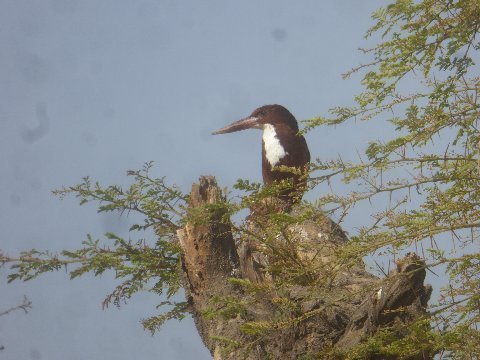
Above: White Breasted Kingfisher. Rest stop. National Highway 8. Rajasthan, India.
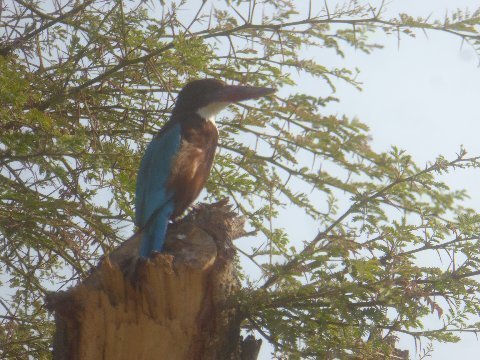
Above: White Breasted King Fisher (same bird as prior image). National Route 8, Rajasthan, India. 14 January 2016.
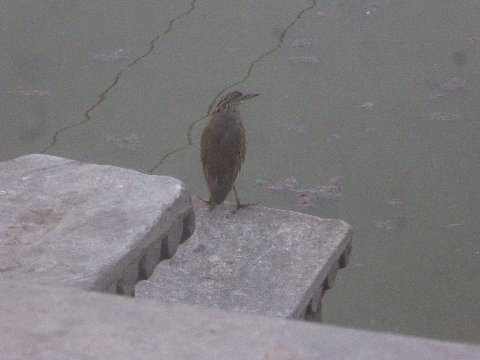
Above: Pond Heron. Shahpura, Rajasthan, India. 14 January 2016.
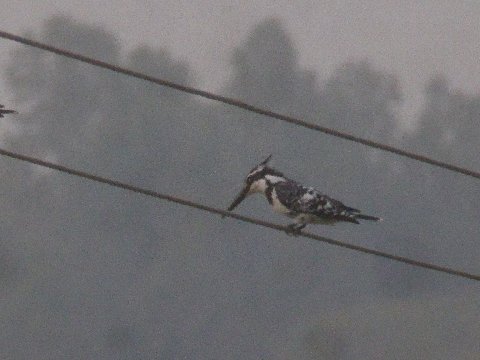
Above: Pied Kingfisher. Shahpura, Rajasthan, India. 14 January 2016.
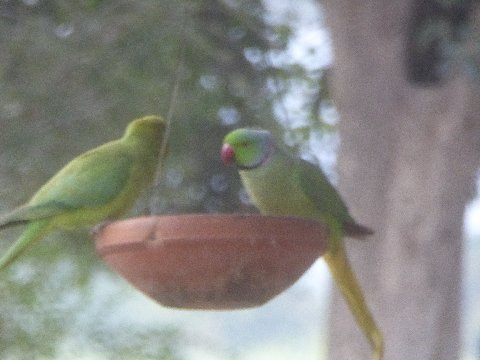
Above: Indian Ring Neck Parrots. Shahpura Bagh, Shahpura, Rajasthan, India. 14 January 2016.
The Margaret Taylor Dance Troupe visited Sardarpura Village, eight miles from Shahpura, this morning.
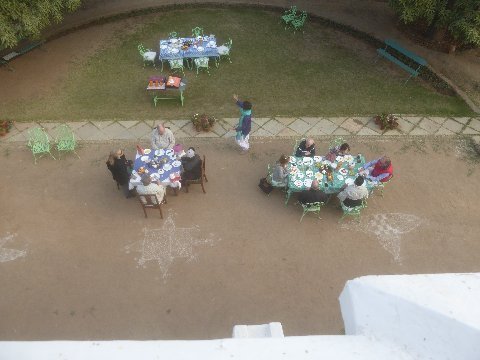
Above: Breakfast. The Margaret Taylor Dance Troupe. Shahpura Bagh. Shahpura, Rajesthan, India. 15 January 2016.
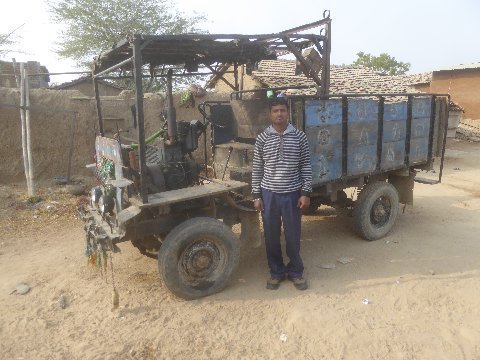
Above: Uh... truck? Sardarpura village. Rajesthan, India. 15 January 2016.
Contrived contraption. Single cylinder, low RPM, high torque, industrial engine (thumper) used for water pumps, among others.
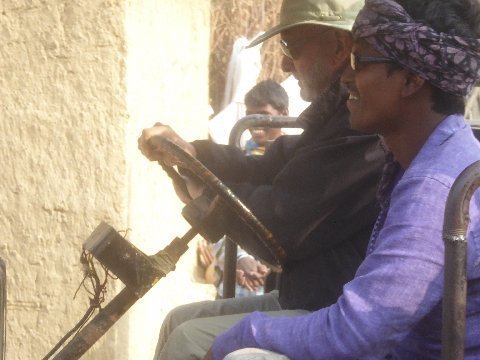
Above: Admiral, with friend, drives Sardarpura village truck. Sardarpura village. Rajesthan, India. 15 January 2016.
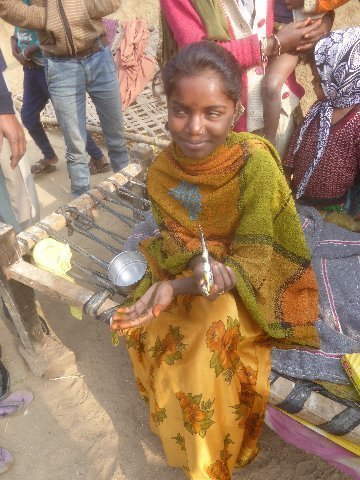
Above: Henna girl. Sardarpura village. Rajesthan, India. 15 January 2016.
Henna girl, holding brush with which she painted a design on the back of my right hand.
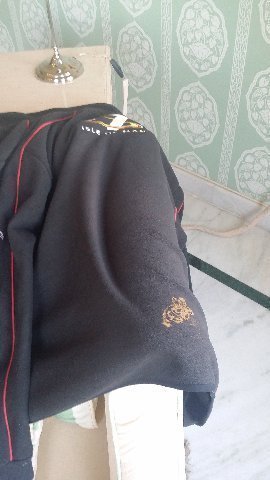
Above: Henna design on back of my jacket. Raj Mahal Palace Hotel. Jaipur Rajesthan, India. [16] January 2016.
After Henna girl painted the design on the back of my hand, I immediately forgot about it. Ten or so minutes later I looked at the design and it was smudged.... hardly discernable. I thought, wow, what happened? Was Henna girl using invisible ink? A few minutes later, Click (new name for Heat) said, "Steve, what's that on the back of your jacket?" Inadvertently, unwittingly, I had clasped my two hands behind my back and imprinted the fresh henna design onto the back of my fleece.
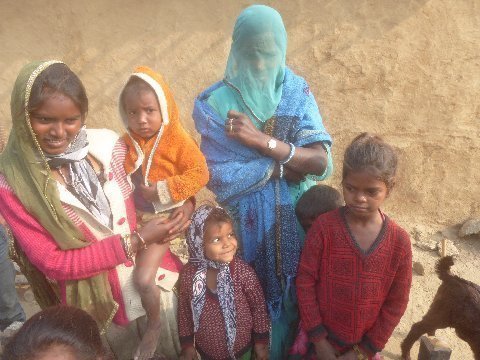
Above: Village people. Sardarpura village. Rajesthan, India. 15 January 2016.
We are accustomed to seeing some Muslim women cover their face.
In Rajasthan, some Hindu women also cover their face, as seen in this image.
Per Ajay, a Hindu woman who comes to live in a new village by marriage will cover her face. If she is in her own village, she won't cover her face. The tradition derives from the period when Muslims invaded India around 800 AD. Then, Muslim invaders wantonly ravished the Hindu women. Hindu elders had Hindu women cover their faces to make them less vulnerable to harassment. The veil tradition has carried on in Rajasthan village life notwithstanding much improved communal relations between Muslims and HIndus today.
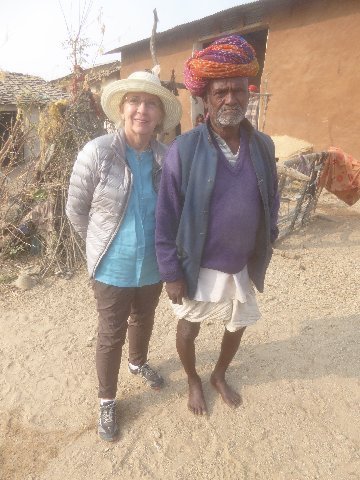
Above: TIMDT and village elder. Sardarpura village. Rajesthan, India. 15 January 2016.
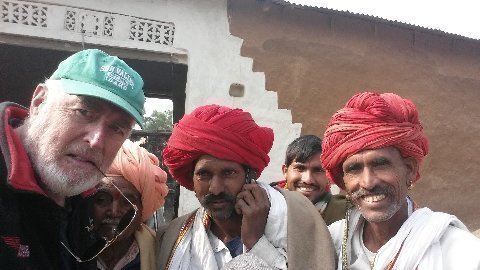
Above: The Bishop and sheepherder brothers. Sardarpura village. Rajesthan, India. 15 January 2016.
The man on the right is father to one of the employees at Shahpura Bagh. I didn't get a picture of the young man, who was neatly attired in western clothing, and who accompanied us on the visit to his village. As India's economy improves, more young people will seek opportunity outside of the village. One wonders how long the village farming lifestyle will last.
The two brothers looked like they were doing pretty well for themselves. They showed us the courtyard of their residence where a hundred or show sheep were standing. They, their wives and daughters were wearing "a ton" of gold and silver jewelry. Cell phones are de rigueur. One brother is using the phone as the above image is captured.
Notwithstanding the seeming timelessness of Indian village life, change is afoot.
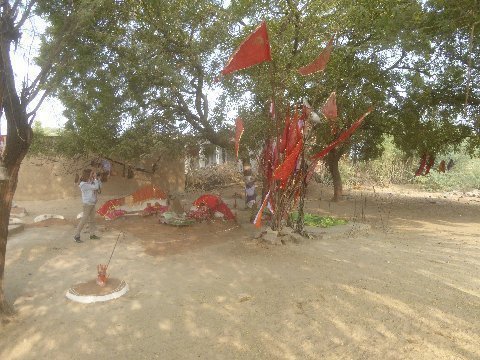
Above: Worship spot. Sardarpura village. Rajesthan, India. 15 January 2016.
The red flags are Hindu ornaments. The green cloths are Muslim ornaments. Members of both faiths live in the village.
This is another example of the seeming success of multiculturalism in India. Will communal cooperation continue with the rise to power of the BJP, a political party with strains of Hindu nationalist - India for Hindus - thinking?
Tribalism seems to be gaining purchase in the world today. Scotland's yearn for independence, Catalonia's agitation in Spain, and Islamic movements in Africa are contemporary tribal stirrings that come to mind.
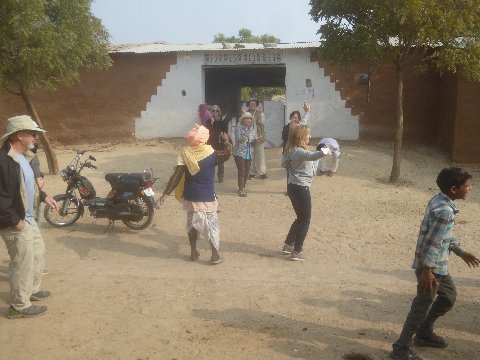
Above: Spago and village elder boogy. Sardarpura village. Rajesthan, India. 15 January 2016.
One of the industrial engine, contrived trucks drove up to near this spot blaring rhythmical Indian music through a loud speaker. Caught up in the moment, former show dancer, Spago, started to boogy. She was joined by the village elder.
Members of the Margaret Taylor Dance Troupe, in the background of the image, clap to the rhythm.
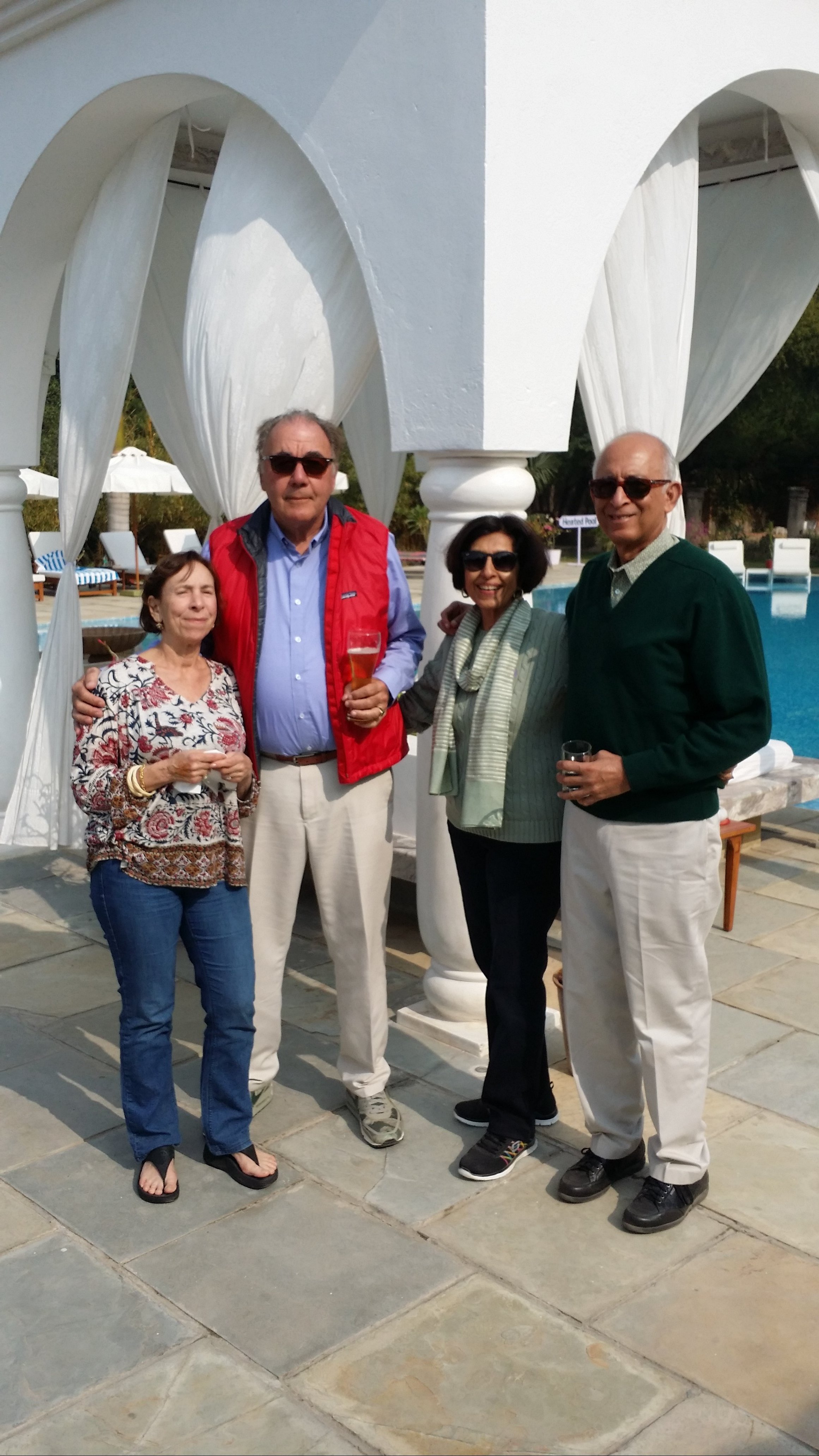
Above: Comic Mom, Maharaja (new nick name for 1%), Diction, and Zubin. At lunch. Shahpura Bagh, Rajasthan, India. 15 January 2016.
Members of the Margaret Taylor Dance Troupe traveling in India.
Addendum:
Steve,
Great diary today! Very informative.
Country Boy,
Greenwich, CT
finally got to see picto on a big screen! great especially the hindu information. thanks Steve.
Brand,
Venice, CA
Great pictures what an adventure.
LaDoc and LaPsy,
Los Angeles, CA
How the World Loved the Swastika until Hitler Stole It - BBC
http://www.bbc.com/news/magazine-29644591
Mrs. Driggs
Salt Lake City, UT
Steve,
Thanks for the travelogue. It brings back fond memories of my various visits there.
In the economic dual between India and China, I have a feeling that India will emerge the winner, after a good deal of time, since the Indian way of life, permitting all of the clamor of a democracy to be open for all to see, will eventually yield a greater economy than China’s closed shop set-up.
Your opinion?
“Hello” to Margaret,
Ahn Rhee, Larkspur, CA
I agree.
I think, in the case of the Indian usage, you would refer to the symbol as a fylfot rather than a swastika, although the terms have become interchangeable over time.
Jack Aroon, Mahwah, NJ
Today the Margaret Taylor Dance Group traveled by bus from Shahpura, Rajasthan to Jaipur, Rajasthan.
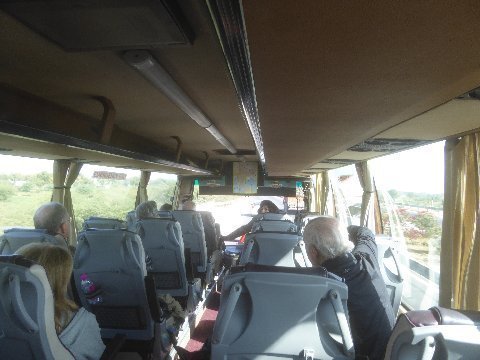
Above: Diction, at front of bus on right, using bus mike, gives a presentation on Zoroastrianism. 16 January 2016.
Diction and her husband Zubin are Parsees, residents of Mumbai. Zubin was the manager of the New Delhi branch of Citibank when I was assigned there as a Sundries officer in 1972. They are very close friends of Maharaja (formerly 1%) and Comic Mom. They have joined the Margaret Taylor Dance Troupe for four days.
Zoroastrianism is arguably the world's oldest monotheistic religion. It is centered on the teachings of the prophet Zoroaster and focuses worship on the one god, Ahura Mazda. The religion teaches that there are two competing principles representing good and evil. Humans are involved in a struggle between the two forces, holding off chaos and destruction through active goodness.
Traditionally, Zoroastrians do not accept converts. One must be born into the religion in order to participate, and marriage within the Zoroastrian community is strongly encouraged, although not required. According to Diction, in the Mumbai Parsee community, children of mixed marriages are only allowed to continue in the religion if the father is Parsee.
The prophet Zarrathustra, later referred to by the Grees as Zoroaster, founded Zoroastrianism between the 16th and 10th centuries BC. He is said to have lived in northern or eastern Iran, Afghanistan or southern Russia.
Zoroastrianism was started amidst the polytheistic background, precursor of Hinduism, of the Indo-Iranian area. Zoroaster probably elevated an already existing god into the role of supreme creator. Thus, the two beliefs share some similarities such as agents of order and chaos.
The overriding ethical principle of Zoroastrianism is Humata, Hukhta, Huveshta, “to think good, to speak good, to act good.” This is the divine expectation of humans, and only through goodness will chaos be kept at bay.
Ahura Mazda is strongly associated with both fire and the Sun. Zoroastrian temples keep a fire burning at all times to represent Ahura Mazda’s eternal power. Fire is also recognized as powerful purifier and is respected for that reason. The most holy temple fires take up to a year to consecrate, and many have been burning for years or even centuries. Visitors to fire temples bring an offering of wood, which is placed in the fire by a masked priest. The mask prevents the fire from being desecrated by his breath. The visitor is then anointed with ash from the fire.
Zoroastrians believe that when a person dies, the soul is divinely judged. The good move on to the “best of existences” while the wicked are punished in torment. As the end of the world approaches, the dead will be resurrected into new bodies. The world will burn but only the wicked will suffer any pain. The fires will purify creation and eliminate wickedness. The evil force will either be destroyed or made powerless, and everyone will live in paradise except perhaps the extremely wicked, which some sources believe will continue to suffer endlessly.
Unlike Hindus, Zoroastrians do not cremate their dead, believing that doing such pollutes the pure fire emblematic of their worship. Rather they put their dead on "towers of silence," sacred heights where corpses are consumed by carrion.
The Mumbai community of Parsees is about sixty thousand strong, and is the largest group of Parsees in the world. The religion is dwindling. It is not a proselyting religion. Many children of adherents today intermarry and lose interest in the faith.
Parsees reached India in 700 or 800 AD fleeing eastern Iran due to persecution from rising Islam.
Parsees have contributed to India disproportionate to their numbers. Many Indian business leaders are Parsee, including the Tata family. Zubin Mehta is a Mumbai Parsee, as was Freddie Mercury.
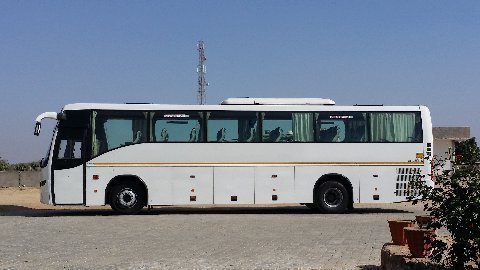
Above: Volvo bus used by the Margaret Taylor Dance Troupe on its tour of India. 16 January 2016.
Note communication tower at rear of the bus. Such towers are now ubiquitous in India and are indicative of the country's full scale charge into the modern era. Cellular technology, voice and data, have allowed countries such as India to leap frog land line technology. When TIMDT and Mwah (sic) lived in India in the early 1970's, obtaining a home telephone could entail a four or five year wait. And, once in possession of a telephone in those days, long distance calls had to be scheduled in advance.
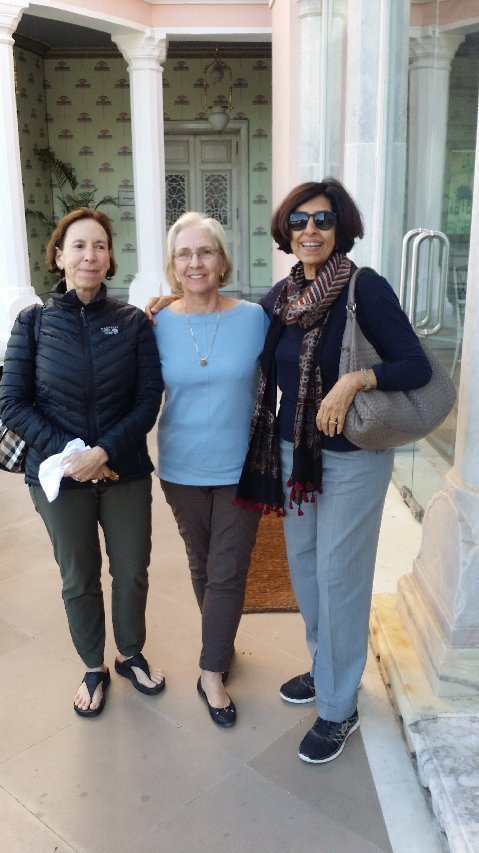
Above: Comic Mom, TIMDT and Diction. Sujan Rajmahal Palace Hotel. Jaipur, Rajasthan, India. 16 January 2016.
Ladies and their husbands, members of the Margaret Taylor Dance Troupe, are vacationing in India... princesses remembering times past as Citibank wives living in India.
Diction and husband Zubin, divide their time between homes in Mumbai and Pune. Comic Mom and husband Maharaja have residences in New York City and Park City, UT... they spend a good deal of time in Los Angeles, home to both their children and their families. TIMDT and husband Bishop reside in Park City, UT.
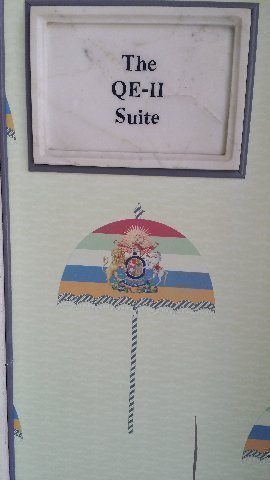
Above: Sign at entrance of QE II Suite, Raj Mahal Palace Hotel. Jaipur, Rajasthan, India. 16 January 2016.
Queen Elizabeth II stayed in this suite during a visit in the 1950's as a guest of the Maharaja of Jaipur. Jackie Kennedy also stayed in the QE II suite.
Now, TIMDT and Mwah (sic) follow suite as residents of the QE II suite.
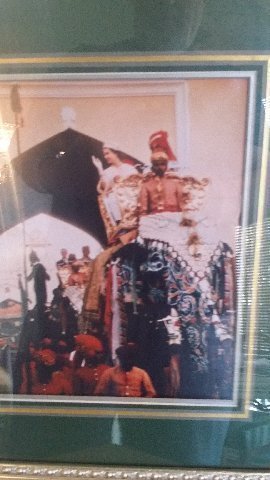
Above: Image of Queen Elizabeth II riding elephant during her visit to Jaipur in late 1950's. Sujan Raj Mahal Palace hotel. Jaipur, Rajasthan, India. 16 January 2016.
The above photograph is in our hotel suite.
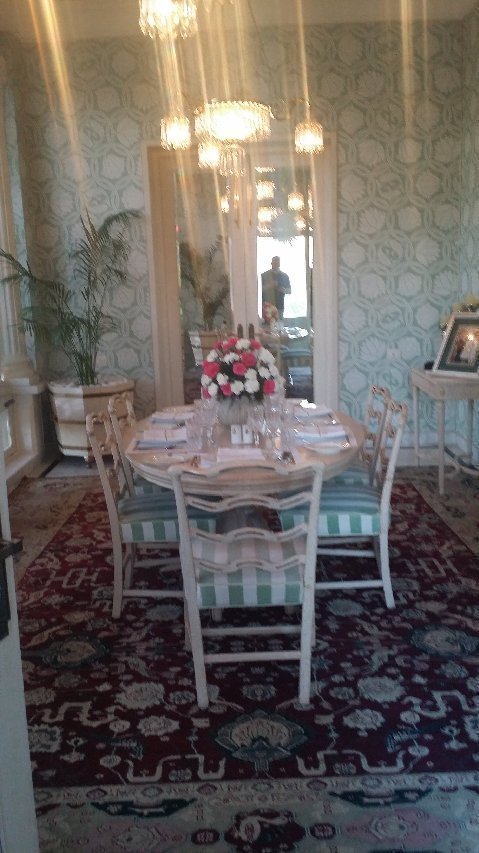
Above: Dining room. QE II suite. Sujan Raj Mahal Hotel. Jaipur, Rajasthan, India. 16 January 2016.
Note ghostly apparition at rear of image.
The Raj Mahal Palace, an adjunct, guest palace of the Maharaja of Jaipur, as been converted into a hotel, just within the last year, by the Sujan Group, the same group which owns the Leopard Camp where we stayed a week ago.
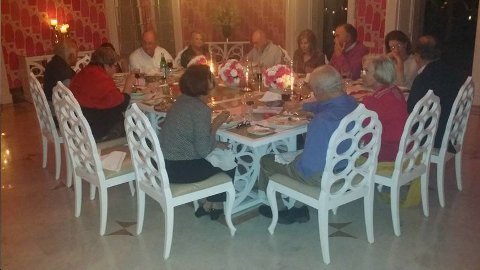
Above: Margaret Taylor Dance Group dines at Raj Mahal Palace Hotel. Jaipur, Rajesthan, India . 16 January 2016. Maharaja auxiliary palace, recently converted to a hotel by Sujan Group, was guest house for Queen Elizabeth and Jackie Kennedy among others.
Addendum:
As usual, great account.
We miss being part of the fun. Best to all.
Basketball
Pelham, NY
just great Steve--so much depth.
Brand,
Venice, CA
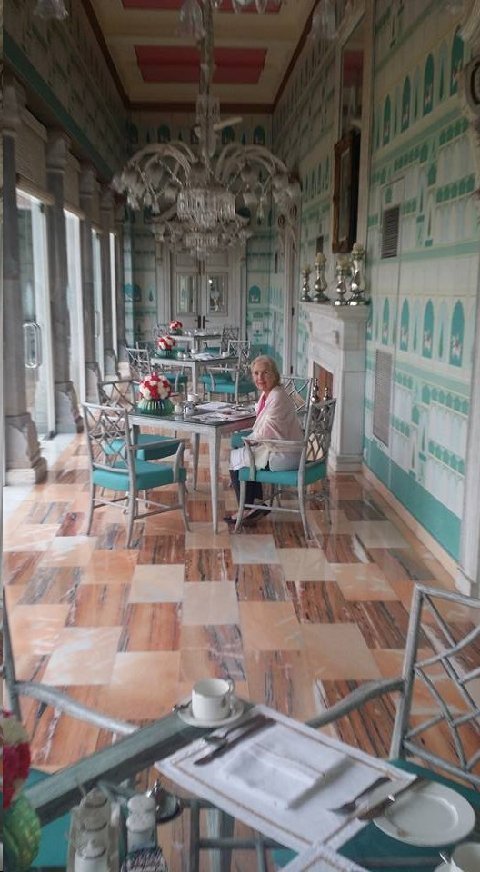
Above: Maharani TIMDT at breakfast. Raj Mahal Palace Hotel. Jaipur, Rajasthan, India 17 January 2016.
The Raj Mahal Palace hotel has been open for less than a year. It's on many of the "hot hotels in the world" lists and is considered by many as a destination in itself.
The building was built in 1729 by the Maharaja of Jaipur as a garden retreat for his wife, on what was then the outskirts of the Pink City. In 1821, it became the official home of the British Resident who continued to live there right up until Indian Independence in 1947.
In 1958, Maharaja Sawai Man Singh II - renowned for his prowess on the polo field and his beautiful third wife, Gayatri Devi - decided to use Raj Mahal Palace as their private home, away from their formal residence, City Palace. Here, they entertained friends from the Queen and Prince Philip to Jackie Kennedy and Lee Radzwill. Now, the hotel's 15 suites and rooms are named after illustrious guests of the past.
The hotel is managed by Sujan Group, the same people who managed our leopard camp and other highly polished safari camps within Rajasthan. Wi-Fi is excellent and free all over the hotel. Laundry is free.
I asked Rajput 'stached Prakeet, the manager, if he knew the Prakeet who managed the leopard camp. He said he did... and, that both he and the other Prakeet had their wives working with them at their respective Sujan properties.
The hotel is a boutique hotel. There is a high attention to service and detail. Bed sheets are actually ironed as part of the turn down service.
Gayatri Devi, became world famous. Her husband's liberating influence and her strong character took her well beyond the traditionally limited activities of a Maharani. She is the author of the widely acclaimed biography, "A Princess Remembers," where she talks about her early life as the daughter of the Maharaja of Cooch Behar, and her life as the Maharani of Jaipur, from the height of Jaipur's power as a princely state, to its de-recognition at independence. By a landslide, she was elected a member of Indian Parliament after independence. Gayatri Devi was listed in Vogue as one of the most beautiful women in the world.
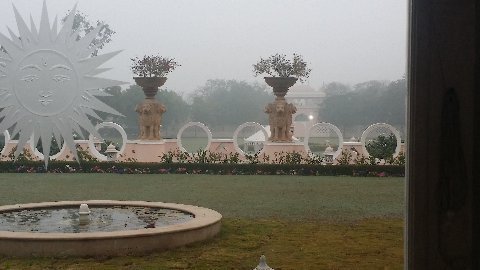
Above: Gardens, looking out from breakfast. Raj Mahal Palace Hotel, Jaipur, Rajasthan, India. 17 January 2016.
The two pillars holding the floral arrangements are replica sculptures of four Indian lions standing back to back.. A graphic representation of the sculpture, first introduced by emperor Ashoka in the third century BC, was adopted as the official emblem of India in 1950.
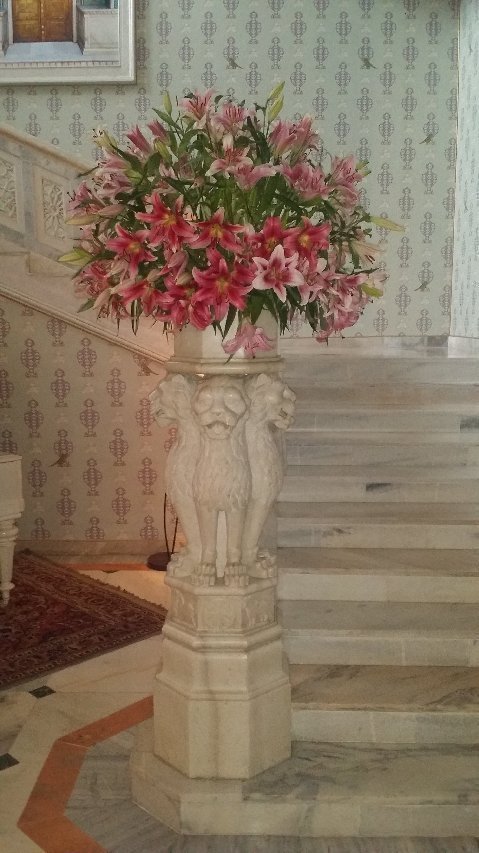
Above: Marble Ashoka Lions sculpture and floral arrangement. Raj Mahal Palace Hotel. Rajasthan, India. 17 January 2016.
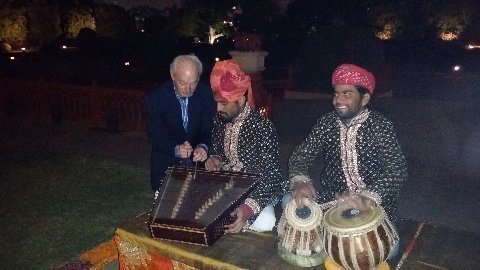
Above: Montage plays the santoor, accompanied by tabla. Rambagh Palace Hotel, Jaipur, Rajasthan, India. 17 January 2016.
Followed by dinner. TIMDT has stayed at the Rambagh Palace Hotel, run by the Taj group, on previous occasions. She wanted us to see it and, therefore, scheduled our dinner there.
Traveling with the Margaret Taylor Dance Troupe in India.
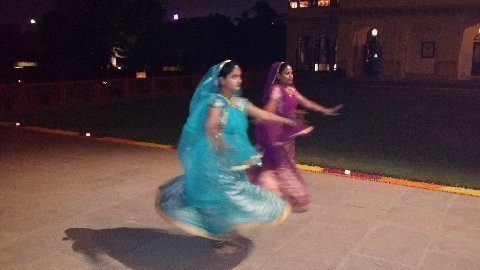
Above: Rajasthani Folk Dancers. Rambagh Palace Hotel, Jaipur, India. 17 January 2016.
Addendum:
Steve
I have enjoyed all of your dairy entries from ur epic trip immensely.
Thanks for sharing.
Trevor
Miami, FL
Steve thanks for your photos and the in depth dialogue.
The Monk,
Salina, UT
After arrival in Delhi by bus from Jaipur, and check in at the Gurgaon Oberoi Hotel, two Citibank alumni couples, broke off from The Margaret Taylor Dance Group to join Indian Citibank alumni friends for dinner at the home of Rana Talwar in New Delhi.
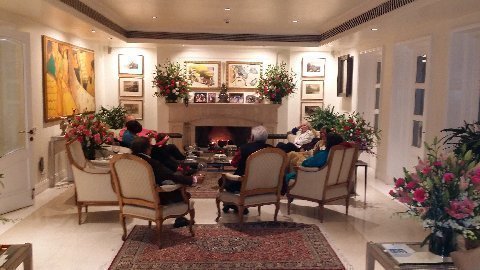
Above: Former India Citibankers enjoy cocktails and dinner hosted by Rana Talwar at his home. New Delhi, India. 18 January 2016.
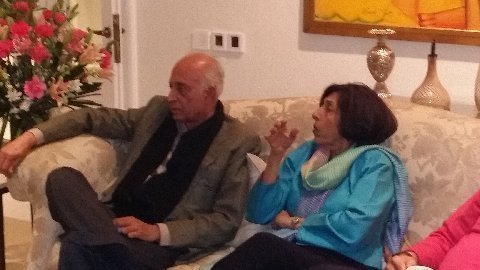
Above: Mehli and Saker Mistri.
Former India Citibankers enjoy cocktails and dinner hosted by Rana Talwar at his home. New Delhi, India. 18 January 2016.
Mistris enjoying dividing time between two homes, one in Pune and the other in Mumbai. Mehli works on the violin with his Japanese instructor and Saker edits a book about participants in Teach for India, headed by their daughter.

Above: Margaret Taylor, Royina Grewal, Mehli Mistri, Mandira Gauba, Rana Talwar.
Former India Citibankers enjoy cocktails and dinner hosted by Rana Talwar at his home. New Delhi, India. 18 January 2016
Rana says: There is an aspirational quality about India today.
Mandira says: There is a sense of potential amongst the young. Young Indians believe that if they get an education and work hard they can achieve anything they want.
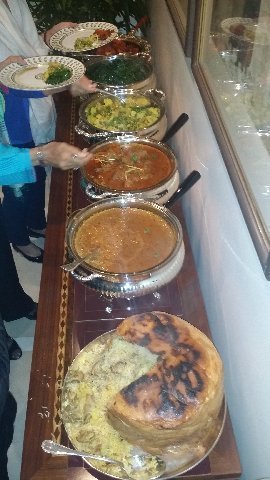
Above: Fare at Rana's.
Former India Citibankers enjoy cocktails and dinner hosted by Rana Talwar at his home. New Delhi, India. 18 January 2016.
Check out that biryani!
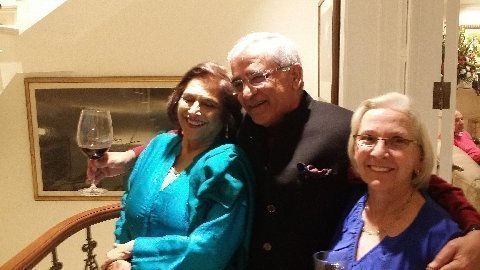
Above: Royina Grewal, Rana Talwar, Margaret Taylor.
Royina. Author of recently published novel, "Babur - Conqueror of Hindustan."
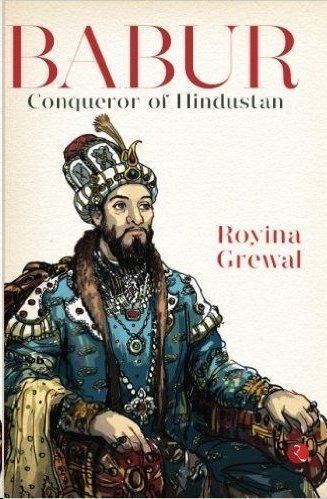
Margaret: Leading her 8th trip to India in last 10 years. Usually takes her cronies, but, this time boys, including her list junkie husband, accompany.
Former India Citibankers enjoy cocktails and dinner hosted by Rana Talwar at his home. New Delhi, India. 18 January 2016.
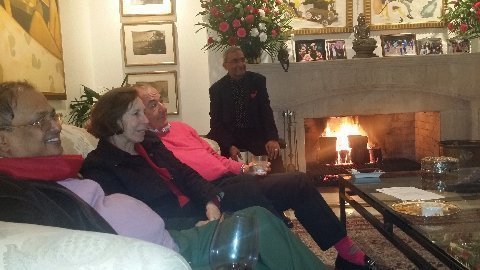
Above: Jerry Rao, Vickie Callen, Mike Callen, Chita Gauba.
Jerry: Building housing for a burgeoning India.
Vickie: Grand parenting in LA. Recharging in home town, New York City, and skiing in Park City.
Mike: Studying Italian, golfing with MJ, skiing, and otherwise working hard to stay on top of events.
Chita and Mandira: Vancouver residents move to Muscat, Oman where Chita takes position as CEO of a trading company.
Former India Citibankers enjoy cocktails and dinner hosted by Rana Talwar at his home. New Delhi, India. 18 January 2016.
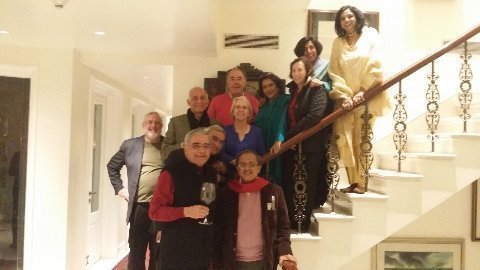
Above: (front) Rana Talwar, Jerry Rao. Chita Gauba (behind Rana). Left to right: Steve Taylor, Mehli Mistri, Mike Callen, Margaret Taylor, Royina Grewal, Vickie Callen, Saker Mistri, Mandira Gauba. Talwar residence. New Delhi, India. 18 January 2016.
19 January 2016.
Day in transit from New Delhi to Bagdogra, West Bengal by air, then to Glenburn Tea Estate, Darjeeling, West Bengal, by ground. Stop off at Sinclair Hotel, Siliguri, for lunch. No images taken.
Addendum:
I so envy this journey you are on!
A gorgeous photo of Margaret in a beautiful room. Love to both of you and to Vickie and Mike too?
Mary Rose
Atlanta, GA
Steve,
Many thanks for the great picto-diary and photos of the Indian trip. Interesting and informative. Delighted you're catching up with "old" friends and colleagues.
Cheers,
DFT,
Sydney, Australia
Similar to the Best Westerns we usually stay at on the road 😇.
Mr. Z3,
Ojai, CA
The Margaret Taylor Dance Troupe spent the day in Darjeeling, city name of which also defines the 87 tea estates surrounding the area. Darjeeling tea is known as the champagne of teas.
I was in Darjeeling riding a Royal Enfield Bullet motorcycle in 2009. Our group, then, didn't spend any time in the city. We had lunch and rode on to Bhutan. I was looking forward to getting a closer look this time.
Tomorrow we'll look at Glenburn's tea operation.
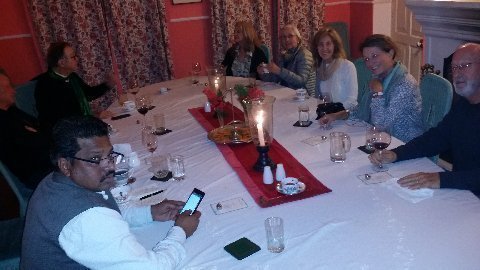
Above: Members of the Margaret Taylor Dance Troupe in India dine at Glenburn Tea Estate. Glenburn Tea Estate, Darjeeling, West Bengal, India. 19 January 2016 (last night).
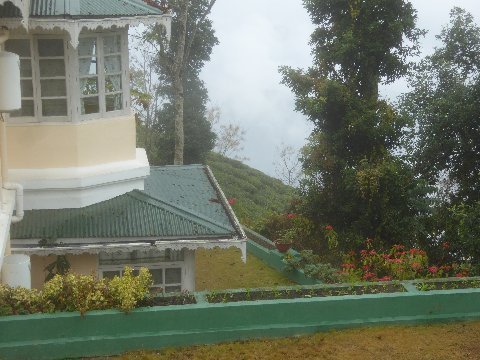
Above: Glenburn Tea Estate. West Bengal, India. 20 January 2016.
Early morning image shows tea plants - the famed Darjeeling tea - behind one of the estate's buildings.
Beyond fog. Doesn't look hopeful to see the visible when clear Himalayan peaks today.
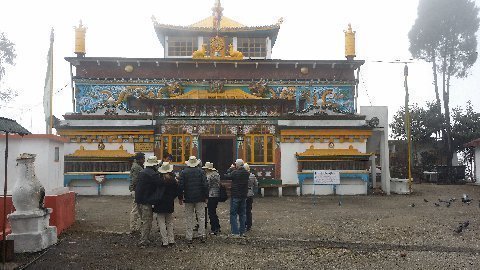
Above: Members of the Margaret Taylor Dance Troupe listen to guide Naresh talk about Yiga Choeling Buddist Monestary, established 1850. Ghoom, West Bengal, India. 20 January 2016.
Its cold! 39 degrees with a bit of wind. Occasionally, but rarely, it snows and freezes at this level... and that ends the tea crop.
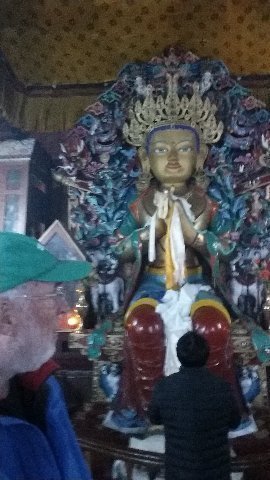
Above: The Bishop contemplates the Buddha at Yiga Choeling Buddhist Monastery, established in 1850. Ghoom, West Bengal, India. 20 January 2016.
The Bishop has now completed his January 2016 pilgrimage.. that of visiting a temple in India of each of the four religions founded in India: Hinduism, Sikhism, Jainism, and Buddhism.
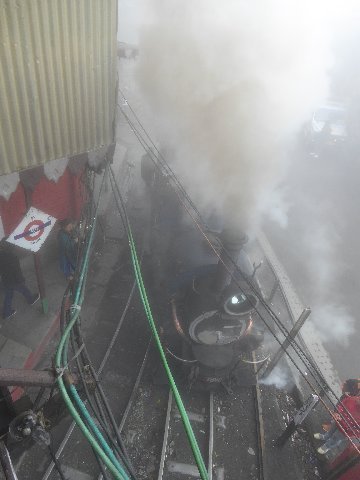
Above: Locomotive from Darjeeling Hill Railway. Darjeeling, West Bengal, India. 20 January 2016.
Huff puff. Smoke from the chugging engine engulfed me, standing on a bridge above, seconds after I captured this image.
There are 70 locomotives existing for this vintage railway, first built in the mid 19th century to ferry tea production out of the Himalayan foothills to Siliguri in the northern West Bengal low lands. 14 of the locomotives are operative and seven of them are in excellent condition. The railway is now run as a tourist attraction between Ghoom and Darjeeling. It was designated a UNESCO World Heritage Site in 2007.
Note the green hoses in the image. They are all over the city. They make up a make-shift, jury rigged water supply conduit supplement for an overloaded city water system, adequate for 50 years ago when Darjeeling's population was a third of what it is today - 130 thousand.
Darjeeling water is only available for two hours a day. Most homes have large plastic tanks that are filled when the water is on enabling a constant supply during the day.
Perhaps Jerry Brown should take a look at Darjeeling's resourcefulness in solving its water problems?
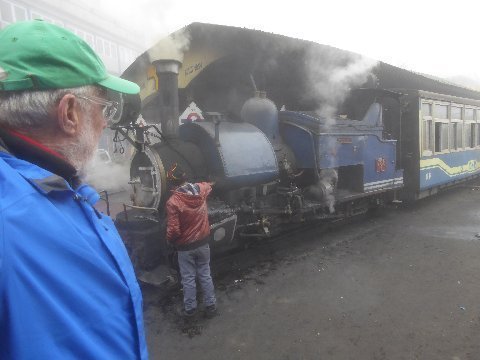
Above: Bishop examines locomotive of Darjeeling Hill Railway as railway employee pours oil, out of a used water bottle, on the works. Darjeeling Hill Railway, Darjeeling, West Bengal, India. 20 January 2016.
The control around the train at Ghoom station was non existent enabling us to get right up close to see the engine workings. I enjoyed looking... but, this experience would have been a gear-head's delight.
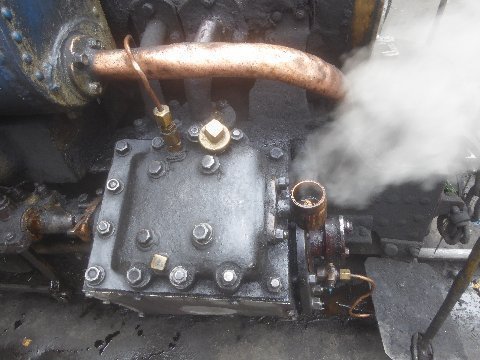
Above: Antique locomotive works. Darjeeling Hill Railway, Darjeeling, West Bengal, India. 20 January 2016.
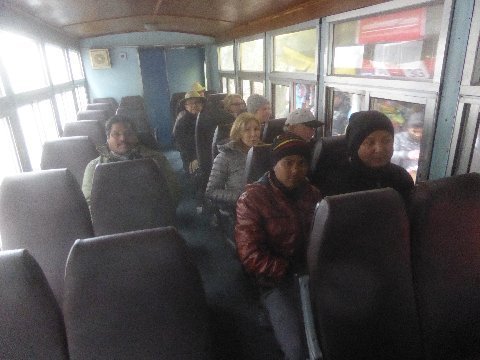
Above: Passenger car and passengers. Darjeeling Hill Railway, Darjeeling, West Bengal, India. 20 January 2016
Members of the Margaret Taylor Dance Troupe on rail car. Two railroad crew sit at the front of the car. The brakeman, turning a large wheel, is sitting in front, just out of the image.
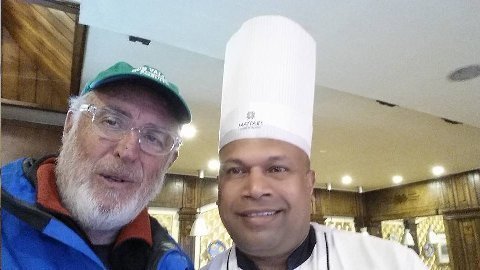
Above: The Bishop and Chef Kailash Barik, Senior Sous Chef, Lunch. Mayfair Hotel. Darjeeling, West Bengal, India. 20 January 2016.
The food - Chef Kailash did an excellent job - kept coming and coming. I was full just after the first five appetizers... then the main courses started coming. He said he'd been working at Mayfair for 19 years.
He came out to say hello to our table. He proudly gave me his card. Is he looking for another job? Based on what we consumed at Mayfair: Hire.
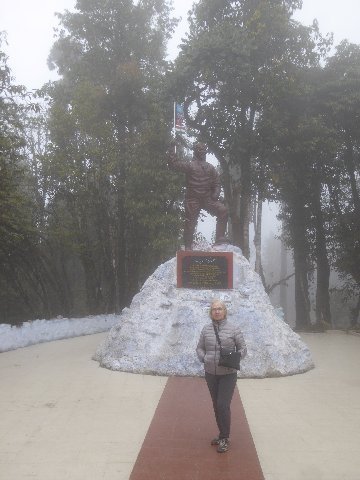
Above: TIMDT stands in front of statue of Tenzing Norgay, first person, along with Sir Edmund Hillary, to scale Everest in 1953. Himalayan Mountaineering Institute. Darjeeling, West Bengal, India. 20 January 2016.
Himalayan Mountaineering Institute is a spectacular museum.
Most fascinating to me was a thirty foot long, 15 foot wide diorama showing, in relief, the Himalayan range from the Kokhoram Mountains in Pakistan/Afghanistan to the eastern end of the range near the borders of Myanmar, China, and India.
Push this button and you could see, illuminated, the flow of the Brahmaputra River. Push that button and you could see lights track the flow of the Indus river far to the west. Of course, you could pinpoint the tallest of the Himalayan peaks using the diorama push buttons. The Tibetan Plateau could be seen on the diorama behind the range.
By looking at the diorama exhibit you could get a real sense of the continental collision of the sub continent with the main Asian continent which formed the Himalayan range only 10 million years ago.
Norgay's remains were cremated near this statue after his death in 1986. A cremation memorial marks that spot.
Darjeeling was a major hang out place for mountaineers. After his climb, and enjoying his fame, Norgay spent a lot of time hanging out with fellow Sherpas and climbers at the museum in Darjeeling.
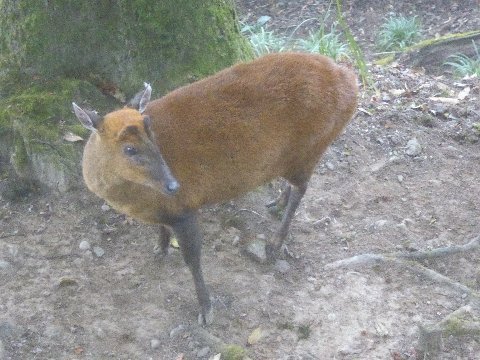
Above: Barking Deer. Padmaja Naidu. Himalayan Zoological Park. Darjeeling, India. 20 January 2016.
Himalayan animals I hadn't seen previously, zoo or otherwise.
Also known as muntjacs, barking deer are the oldest known deer, thought to have begun appearing 15 to 35 million years ago. Remains have been found in Miocene deposts in France, Germany and Poland.
Unlike most other species of deer, barking deer are fighters. They can be vicious protecting their territory using teeth and antlers to fight. Maybe that's one reason they have been around for so long.
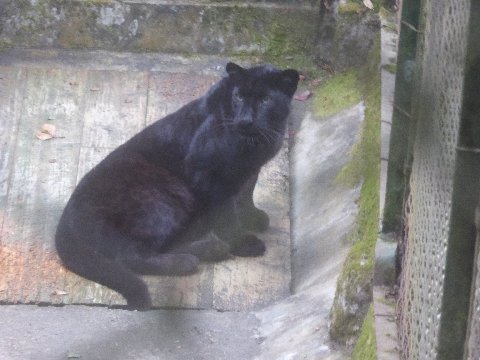
Above: Black Leopard. Padmaja Naidu. Himalayan Zoological Park. Darjeeling, India. 20 January 2016.
A black panther is typically a melanistic color variant of any of several species of larger cat. Melanism in leopards is conferred by a recessive gene.
The typical markings are hidden by the excess black pigment melanin giving an effect similar to that of printed silk.
The leopard inhabits densely forested area and is distributed in southwestern China, Myanmar, northeast India, and Nepal.
I felt bad seeing this magnificent animal caged. On the other hand, most animals in zoos have a 1/3 longer life span than those that live in the wild. And, its important for humans to be able to see these animals as it enhances understanding of wildlife and their role in the ecosystem.
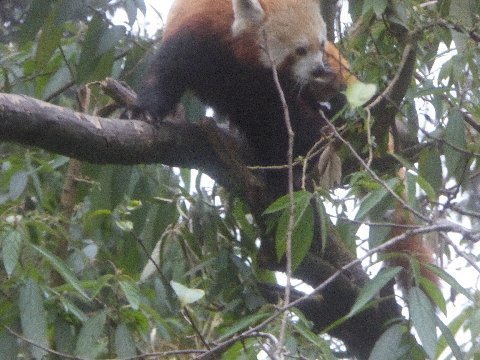
Above: Red Panda. Padmaja Naidu. Himalayan Zoological Park. Darjeeling, India. 20 January 2016.
Endangered animal residing in eastern Himalayas and southwestern China. Wild population estimated at less than 10 thousand mature individuals.
Solitary, nocturnal animal.
Threatened by habitat loss, fragmentation, poaching and inbreeding depression.
It is not closely related to the giant panda. Closest relations are weasels, skinks and raccoons.
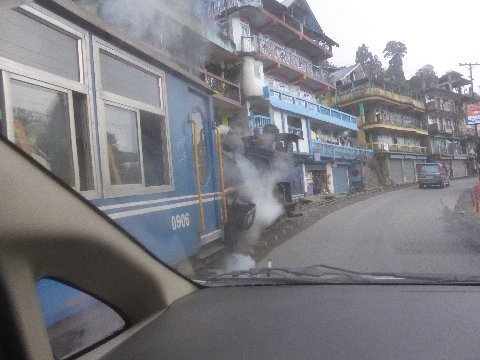
Above: Locomotive and passenger car of Darjeeling Hill Railway as it leaves Darjeeling for Ghoom. Darjeeling, West Bengal India. 20 January 2016.
Image captured from our car as we drive back to the Glenburn Tea Estate.
When I was in Darjeeling in 2009 I didn't see the train, but I remembered the tracks. The narrow gauge tracks cross the road diagonally two or three times as the road exists the city, direction Ghoom. A motorcyclist has to pay very careful attention situations like this as the front motorcycle wheel could slip going over the track and the bike and rider go down.
Funny... these tracks are my most vivid memory of my short experience in Darjeeling in 2009.

Above: Bishop surveys Glenburn Tea Estate, Darjeeling, West Bengal, India. 21 January 2016. Darjeeling... the champagne of teas.
Darjeeling? Opt for first flush pick... but, Autumn pluck is not bad. Avoid Monsoon pluck if you can... too many leaves... too little taste.
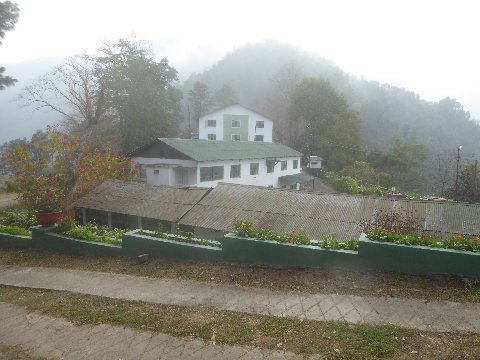
Above: "Factory." Glenburn Tea Estate. Darjeeling, West Bengal, India. 21 January 2016.
Tea is dried in blowers to less than 35% moisture content. Manually broken down by workers to leaf bits after drying. Rolled in automated rollers.
Members of the Margaret Taylor Dance Troupe begin a tour of Glenburn's processing operations.
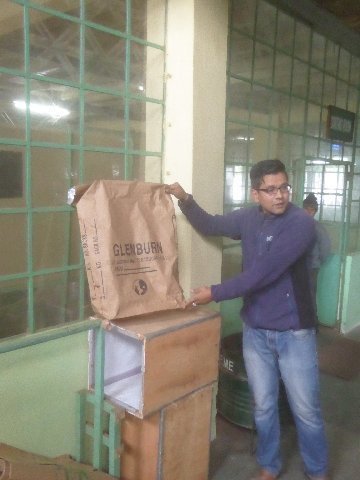
Above: Ranjan. Guide at Glenburn tea processing operation. Glenburn Tea Estate, Darjeeling, West Bengal, India. 21 January 2016.
There is no tea plucking during the winter months. Therefore, we don't see the plucking and processing in operation. Ranjan, here, shows a tea packing sack.
Tea is sent to Glenburn operation in Kolkata in bags as shown for retail packaging. Big paper bags are lined with foil.
Ranjan is 5th generation Nepali tea worker. Likely being groomed for senior management. He was very knowledgeable and effective in his communications.
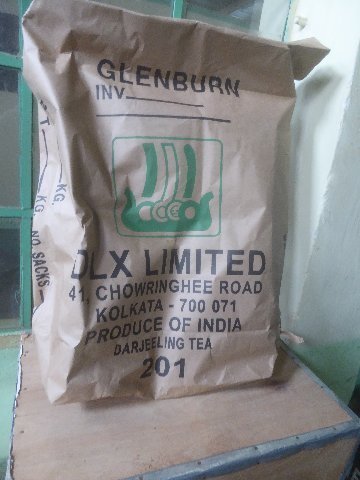
Above: Glenbun tea packing sack. Reverse side.
Four pluckings.... 1st blush, 2nd blush, Monsoon, and Autumn.
Black tea. 1st blush has best taste, then Autumn. Avoid Monsoon... too many leaves because of the wet and taste diluted.
Darjeeling should not be consumed after 18 months of picking... looses taste.
Green tea comes from the same bush as black tea. Green tea leaves are not dried. They are steamed. They stay green and don't go black/brown. There is more residual moisture in the green tea leaf than in the dried black tea leaf. There is also more caffeine.
All of the 87 Darjeeling tea estates produce 9MM kilograms of tea annually. 50MM kilograms of tea are sold annually under the Darjeeling name. There is little done in the tea business to thwart misuse of the Darjeeling name. The only way to safely get Darjeeling tea... and not a blend, or an outright substitution of an inferior tea, is to order directly from the plantation. Most plantations are now set up for online sales.
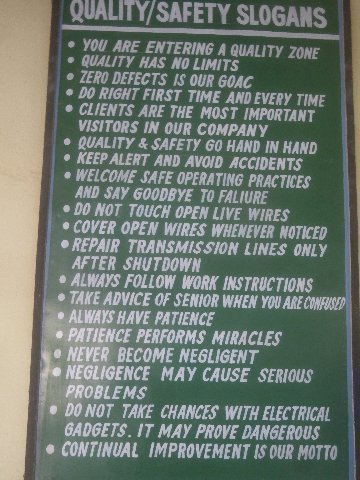
Above: Quality/Safety Slogans. "Factory." Glenburn Tea Estate. Darjeeling, West Bengal, India.
Good advice generally!
Pickers, mostly women, make only about $2.00 a day for 8 hours of work. Picking beyond quota - a level which Ranjun says is not hard to achieve - merits extra pay. Ranjan points out that the men are kept busy with other functions... maintenance, building, heavy lifting etc.
In addition, workers are provided housing, basic food staples, free private education for their children, blankets, wood fuel etc.
Most workers are from fourth or fifth generation Nepali families who migrated east from Nepal to work for tea operations started by the Brits and the Scots in the middle of the 19th century.
Ranjan noted that as India's economy grows, more of today's generation doesn't want to stay, working on the estate. They leave for big city jobs. Tea planters will have to look for other sources of labor to produce their four annual crops.

Above: Poinsettia trees. Glenburn Tea Estates. Darjeeling, West Bengal, India. 21 January 2016.
I thought poinsettias were grown in pots and sold at Costco at Christmas time. You live and learn.
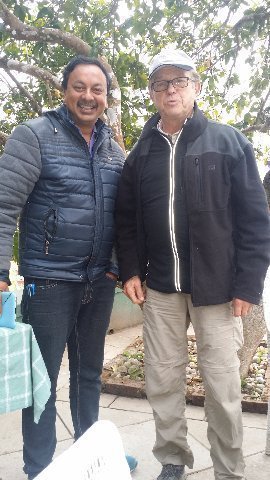
Parveez and 'Cake. Glenburn Tea Estate. Darjeeling, West Bengal, India. 21 January 2016.
Parveez is GM of Glenburn. Raised and university educated in Assam after which he went to the tea business there. He was recruited to Darjeeling by owners of Glenburn from a GM job in Assam which produced 10x volume of Glenburn. Why come? "Darjeeling is the champagne of teas," he said. Kind of like running Astin Martin as opposed to Ford?
Addendum:
You really do a great job on filling in a lot of the background. I am most impressed by your dedication and intellectual curiosity. C u in PC hopefully on the slopes.
Comic Mom,
Park City, UT
I dig Maharaja’s (aka 1%) pink socks!
1911 ACP
Salt Lake City, UT
beautiful Steve and speaking of moonbeam the coastal commission here in so cal wants to fire its conservationist lawyer head and replace him with a board of developers that are brown's cronies i have no doubt mr linda ronstadt has a piece of the gazzilion dollars bullet train to nowhere also.
Brand,
Venice, CA
Fascinating trip. I and sorry I missed it. Great sense of adventure!
Bridge,
Palm Springs, FL
Very interesting perspective ! always individuals that think or feel they are above regulations and eventually they believe it - The Clintons are a prime example of those narcissistic individuals - many years ago I was enticed to Arkansas to put together an SBA deal, once I received the real details I got out of town is quickly as I could -
Mr. Z3
Ojai, CA
good one . smog--when i was at usc there were days i could not see across the street.
Brand,
Venice, CA
PM at Glenburn Tea Estate, 21 January 2016, some members of the Margaret Taylor Dance Troupe traveling in India, took a walk around the tea estate. The hour long walk/hike encompassed homes of the workers, tea bushes, and more than a few good bird shots (sent under separate cover - especially the green magpie!).

Above: Foundation of logs. Worker residence. Glenburn Tea Estate. Darjeeling, West Bengal, India. 21 January 2016.
I wonder if a municipal building permit was obtained?
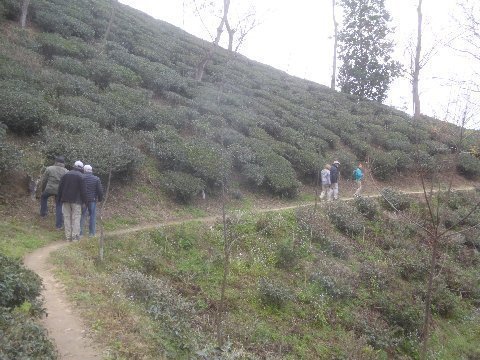
Above: Margaret Taylor Dance Troupe walking through the Darjeeling tea bushes, led by Lilima. Glenburn Tea Estate. Darjeeling, West Bengal, India. 21 January 206.
Glenburn is at 7000 feet of elevation. About the same as Park City. It snows only occasionally, but tea growth can be disrupted by freeze... occasionally happens, not often.
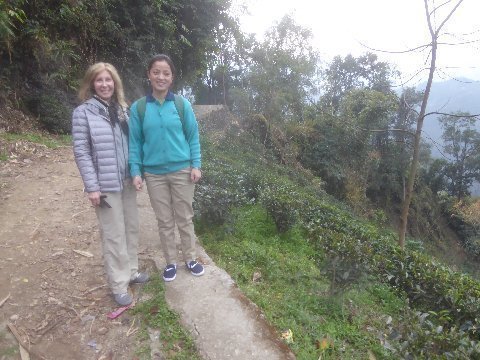
Above: Spago and Lilima, our hiking guide. Glenburn Tea Estate. Darjeeling, West Bengal, India. 21 January 2016.
Lilima guided some members of the Margaret Taylor Dance Troupe on an hour long walk/hike (we covered about 200 vertical feet of descent and ascent... not bad) around the tea estate.
Lilima is a fifth generation Nepali resident of Glenburn.
Lilima was educated at the plantation's expense at a Catholic School where she studied exclusively in English. She went to a public high school in Darjeeling where she studied in Nepali and Hindi, as well as English.
Lilima has a bright, eye contact, smile She spoke English well, albeit accented,...even well enough to banter a bit. Many who speak English otherwise well don't have a good sense of the colloquialisms, double entendre, and non-verbal communication of Americans. Take the Japanese, as a group of English speakers (strugglers?) for one. Lilima was a communicator advanced beyond basic English knowledge.
She acknowledged that many of the young people do not want to stay and work the tea plantation. She, however, said that she had a pretty good job at the plantation and, for now, was happy there. Most girls who stay on the tea plantation marry, in arranged marriages, at the age of 17. They go on to do as their mother's did... move in with the husband's family and work the tea fields.
Lilima said she was 26, and had no interest in marrying in the traditional way. She was proud of her Catholic education. She said she was quite happy in her current job though it was clear that he education accomplishment, poise, level of world awareness was such that she would have opportunity in "the big city," should she want to take the chance.
Likely, engaging with foreign visitors, as she is doing with us, is a deliberate part of her effort to broaden her horizons.
There are 700 or so employees of the tea picking and processing business. The boutique hotel employs 52. You always get coddled staying in Indian hotels. Hotel labor costs are low and excellent service is ubiquitous.
There are two spins on running a tea plantation the way it is done here.. ie. a multigenerational history of tea workers being supported by the company. Meager wages, but basics... home, rice, blankets, and schooling provided. Ie. slave labor?
On the other hand, India's economy burgeons, well educated children of tea workers, whose education was paid for by the tea plantation, see opportunity, and "leave the farm."
The tea plantation must now look to different sources of labor and/or technology to continue tea production. Capitalism. Isn't this the way its supposed to work? Rising tide raises all boats?
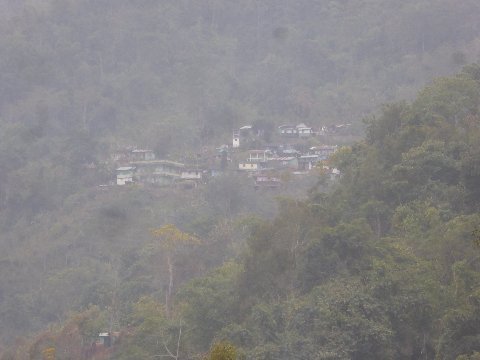
Above: Village where Lilima lives. Glenburn Tea Estate. West Bengal, India. 21 January 2016.
Image captured, telephoto, I would estimate to be two kilometers distant with a 500 foot vertical climb/descent from the spot where the image is captured... from the spot in the tea bushes where Lilima stands with members of the Margaret Taylor Dance Troupe traveling in India.
Lilima affirmed that she walked two and from work at the tea plantation headquarters.
Struggle. That's the first word that came to mind when I had heard Lilima's story. Lilima was raised in the poorest of families, but, took advantage of company offered schooling opportunities to get a solid education. She was putting her learning to work as a guide of international visitors, building her knowledge of the world, AND, she walked/hiked daily about 3 miles, and 500 vertical feet, to get to and from work!
Many kids in America, born into families of economic advantage or privilege, bright, good students though they may be, don't struggle, in a real sense. In fact, many parents today attempt to reduce struggle by their children when they complain that their kids school gives too much homework. As the world shrinks... becomes more integrated in markets and communication... (800 hundred millions Indians now own a cell phone) people like Lilima, who know "struggle," will work harder, in knowledge positions, for less compensation than coddled western kids. In a world sense, struggling Lilima is the future. Non struggling Americans are in for a comeuppance.
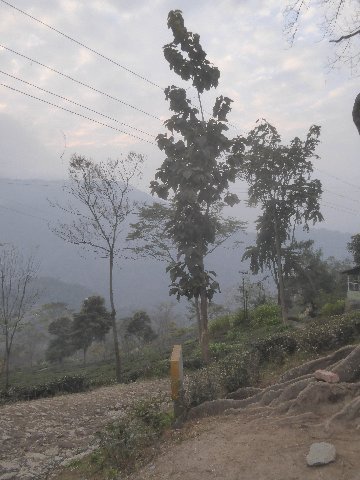
Above: Teak tree. Glenburn Tea Estate. Darjeeling, West Bengal, India. 21 January 2016.
Rare, desirable wood, ubiquitous here.
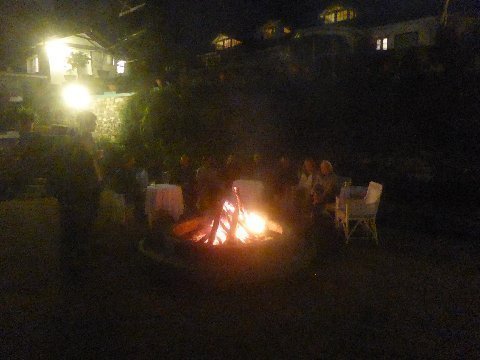
Above: Cocktails by the fire. Glenburn Tea Estate. Darjeeling, West Bengal, India. 21 January 2016.
Glenburn Tea Estate managers a young British couple (Faye and Will), note that they are fully booked... and that they get business by word of mouth.
The owners of Glenburn are owners of the premises that Citibank occupies on Chowringhee Road in Kolkota. We met the Glenburn owners during our visit to Kolkata last year, learned of their boutique hotel tea estate and signed up for a visit the next (this) year.
http://www.glenburnteaestate.com/
We have not been disappointed. This is a unique, off the beaten track, travel experience.
Sadly, because the atmosphere was misty, we missed vistas of the nearby Himalyan peaks. Kangchenjunga, the world's 3rd highest mountain, is visible from Glenburn on a clear day. Check the above website for some good images of Kangchenjunga. We'll have to go back!
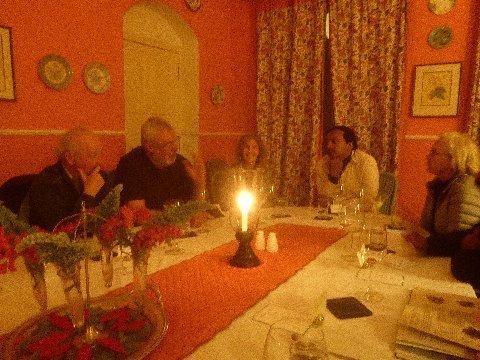
Above: Dinner. Glenburn Tea Estate. Darjeeling, West Bengal, India. 21 January 2016.
Left to right: Montage, The Bishop, Spago, Perveez (GM of tea production), and TIMDT.
Food is excellent. Tonight was Burmese fare.
Addendum:
“Never Become Negligent”
What a concept!
Love all your posts and pics.
Thank you. Our hero!
Inventor,
Park City, UT
Members of the Margaret Taylor Dance Troupe exit Glenburn Tea Plantation headed -three and one half hour drive to Bagdogra... and two hour flight west - to Delhi... the last stop on the Margaret Taylor Dance Troupe 2016 visit to India.
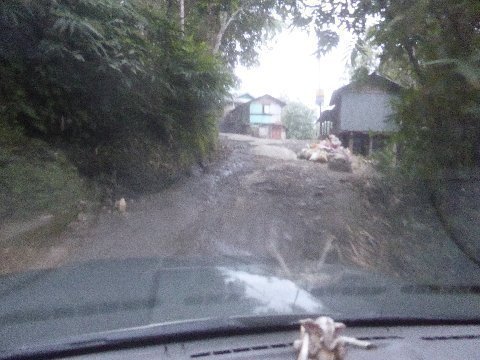
Above: Ascent from Glenburn Tea Estate to main road connecting Darjeeling with Siliguri, in the low lands. Darjelling, West Bengal, India. 22 January 2016.
The Darjeeling road is at 6000 feet and Glenburn is at 3000 feet. We have a long climb on a four wheel road to get to the main road. Part of the charm of Glenburn is its isolation.
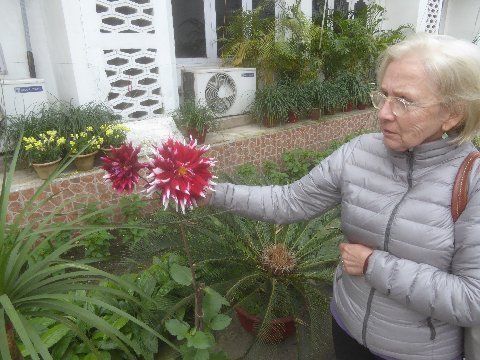
Above: TIMDT and flower. Rest stop. Siliguri, West Bengal, India. 22 January 2016.
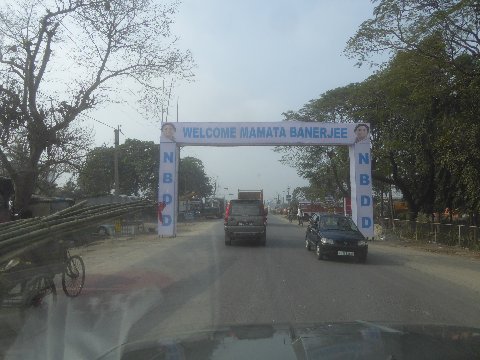
Above: As we leave Siliguri, we note that Mamata Banerjee, Chief Minister of West Bengal, is due in town today (see welcome gate). Siliguri, West Bengal, India. 22 January 2016.
There is always a worry that road shut down for visiting bureaucrats will stymie our exit. But, be got to the airport in Bagdogra sans incident. Our flight was an hour and a half late... but we made it back to the Oberoi Gurgaon hotel before dark.
The West Bengal chief minister's colors are blue and white. She mandates that many of the public works... road dividers, bridge railings etc. be painted blue and white.
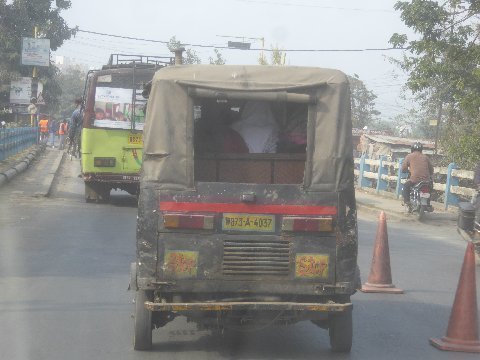
Above: Tuk tuk. Siliguri, West Bengal, India. 22 January 2016.
Limit 10 passengers!
Note the blue and white bridge railings.
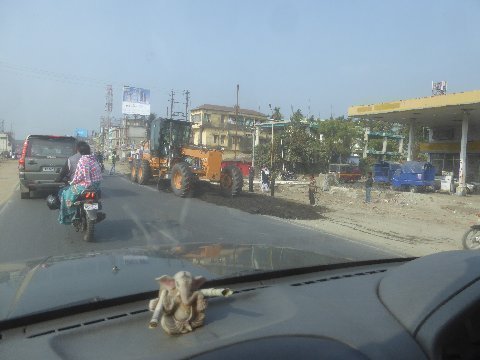
Above: Road Construction. Bagdogra, West Bengal, India. 22 January 2016.
Road construction is ubiquitous in growing, burgeoning India. Here the road is being widened from two lane to four lane.
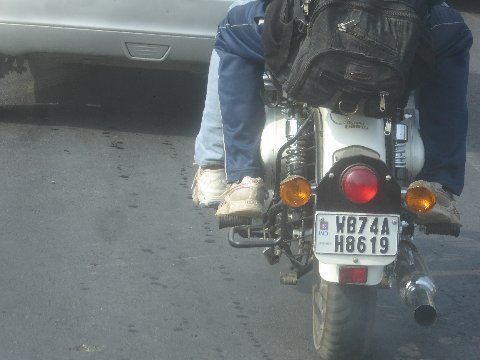
Above: Footrest at left of rear wheel for sari wearer, who sits "side saddle." Royal Enfield motorcycle. Bagdogra, West Bengal, India. 22 January 2016.
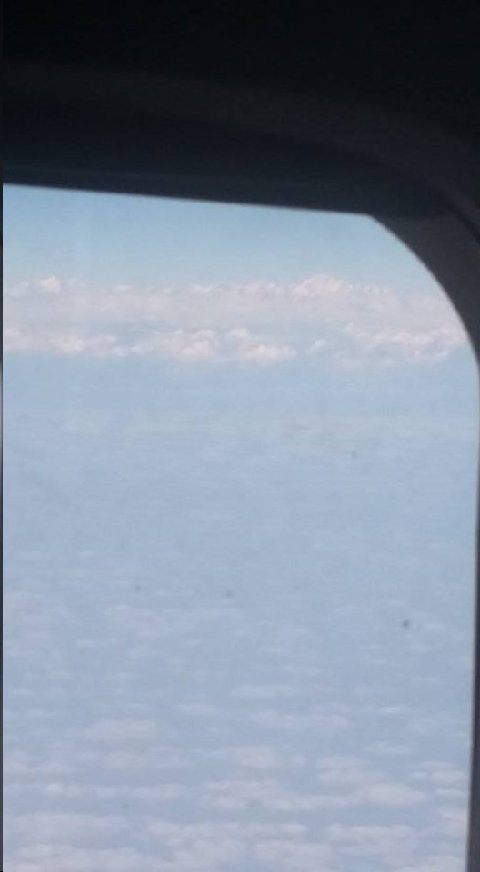
Above: Himalya Range. Nepal. 22 January 2016.
Image taken from aircraft flying west from Bagdogra to Delhi.
Well.... some sighting is better than no sighting!
Actual mountains at the top, above the cloud level.

Above: Members of the Margaret Taylor Dance Troupe dine at 361, Oberoi Hotel, Gurgaon, NCR, India. 22 January 2016.
Addendum:
Steve,
Looks like another great trip to India!
Janet and I enjoy reading your updates every day.
In case you didn’t see the news-
A new ski mountain added to the Epic Pass. Vail Resorts just purchased Wilmot Mountain in Wisconsin, only 90 minutes from Chicago. You can now ski here on your next visit. Unfortunately the word Mountain is a little misleading. The elevation of the hill is all of 230 feet!
Hope to see you and Margaret soon.
Chicago Ducati,
Chicago, IL
Snow is good here this year. Look forward to seeing you. I had a pair of skis in the basement I didn't recognize so I gave them to charity... claiming a charitable deduction.
What is it about the conditions in that area of India that makes for growing great tea (soil, water, temps, elevation, etc. etc..)? Are there any places in the USA with similar conditions where tea could be grown? Can tea plants be grown in pots like many herbs? Thanks for all of the great travelogues from this trip.
Nathans,
Orlando, FL
After returning from Glenburn Tea Plantation last evening, TIMDT and Mwah (sic) enjoyed a final dinner at 361 with members of the Margaret Taylor Dance Troupe (image in yesterday's diary) and had most of today to relax. To make our 8:50 PM flight to Abu Dhabi, we left for the airport at 6:00 PM.
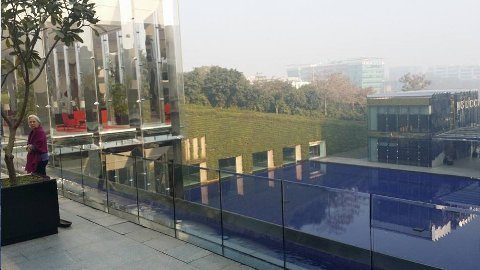
Above: TIMDT at the Oberoi in Gurgaon, NCR, India.
India...a land of contrasts...struggling on the one hand...aspiring...surging...reaching... on the other.
I love coming to India...where people use hands to produce as opposed to holding them out.
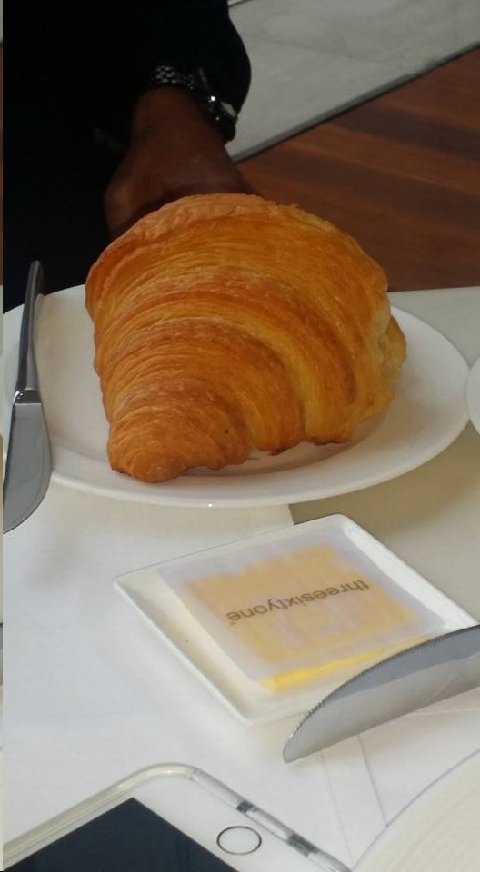
Above: Croissant, Restaurant 361. Breakfast offering. Oberoi Gurgaon Hotel. Gurgaon, National Capital Region, India. 23 January 2016.
Croissant... perfect in every way. Metaphor for top Indian hotels.
I've long suspected that one of the reasons TIMDT likes returning to India time and time again is because of the hotels. It may well be sufficient reason. Incomparable food and service.
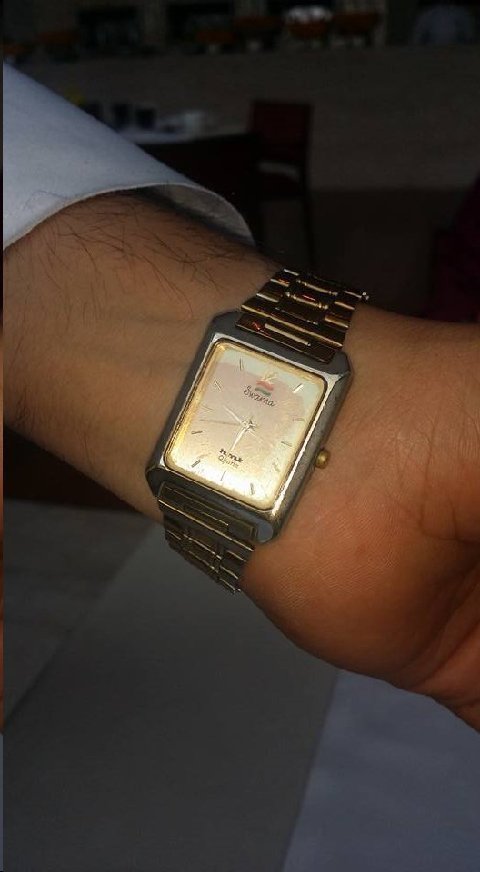
Above: HMT (Hindustan Machine Tool) watch worn by one of the waiters at 361, Oberoi Gurgaon Hotel, National Capital Region, India. 23 January 2016.
The waiter and I compared our HMT watches and mutually commiserated on the demise of the company, recently closed. I treasure my HMT, purchased last year in Pondicherry. An automatic movement for less than $25! Soon, to be a collector's item!

Above: 361 Restaurant. Oberoi Gurgaon Hotel. Gurgaon, National Capital Region, India. 23 January 2016.
TIMDT and Mwah (sic) agreed, the combined food and service level at this restaurant was the best of the trip.
It was nice to hang out for a day, decompressing from a busy, fascinating, agenda laden trip, at the Oberoi Gurgaon.
24 January 2016
No image. Long flight home. New Delhi to Abu Dhabi (Ethiad). Abu Dhabi to Chicago (Ethiad 15 hours!). Chicago to Salt Lake City (American Eagle). Picked up by FeeBee around 5:00 PM on the 24th.
Addendum:
FYI: The flower that your lovely wife, TIMDT, is admiring is a dahlia.
Mrs. Driggs,
Salt Lake City, UT
I was hoping someone would tell me what it was. TIMDT wasn't around when I finalized my diary. Tks. Skiing good yesterday (back to normal). Lets do some runs.